Join our Adventure: Get all my insider tips for motorhoming & road trips
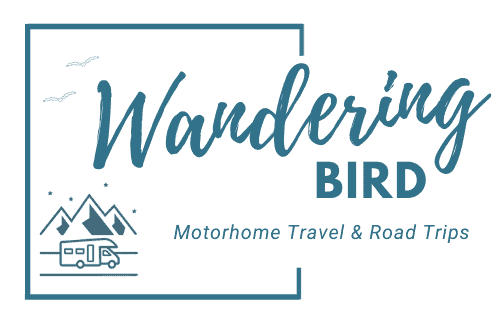

Motorhoming and Campervanning in Switzerland- The Ultimate Guide
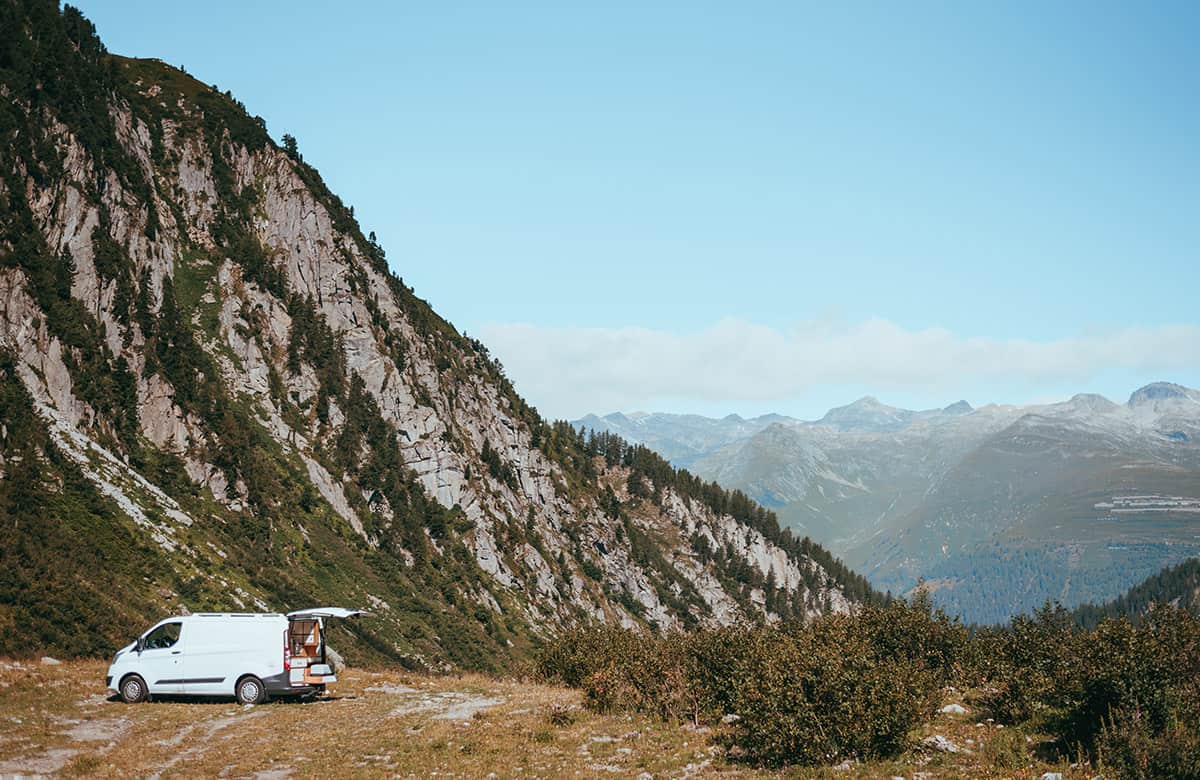
Planning a motorhome or campervan trip to Switzerland? Want to see some of the most beautiful places in Europe (Switzerland has some INCREDIBLE places to visit)? Here’s everything you need to know to go motorhoming or campervanning in Switzerland.
Don’t forget to download your FREE Europe motorhome travel checklist below to help you plan your Swiss road trip.
*We work hard to make this the best motorhome travel blog and road trip website possible, full of helpful content for you. The website is supported by our readers, so if you buy through links on this site we may earn a commission- at no extra cost to you. All opinions remain our own .
If you find this post useful, you can also treat us to a coffee – we promise to enjoy it while creating more useful content like this- we might even indulge in a biscuit (or two!)
JUMP AHEAD TO...
Campervanning in Switzerland – why you should go!
When you think of Switzerland, what comes to mind? Mountains? Lakes? Chocolate? Switzerland is all that- and so much more. The nature, the wildlife and the friendliness of the people are all wonderful reasons to visit.
You can explore Switzerland using public transport, but it’s so much better if you have your own vehicle- whether that’s a motorhome or campervan (our preferred options), or a car, caravan or even motorbike.
One of the best things about being able to explore Switzerland on a motorhoming holiday is that you can see the differences between the regions and really get a feel for the country in a short space of time. It can also make your trip cheaper if you can buy and prepare your meals instead of having to buy them all (Switzerland is not particularly cheap- although not as expensive as Norway!)
In this guide, we’re going to share with you everything you need to know to go motorhoming or campervanning in Switzerland, including getting to Switzerland from the UK or abroad and planning your route, where to stay (motorhome campsites, aires or wild camping with your camper), some road trip ideas and places to visit, driving tips and other practical advice to help you have an amazing Swiss road trip.
If this is your first campervanning trip to Switzerland (or Europe!), don’t forget to grab your free motorhome travel checklist which will help you plan and organise everything you need.
Planning to take your motorhome to Europe?
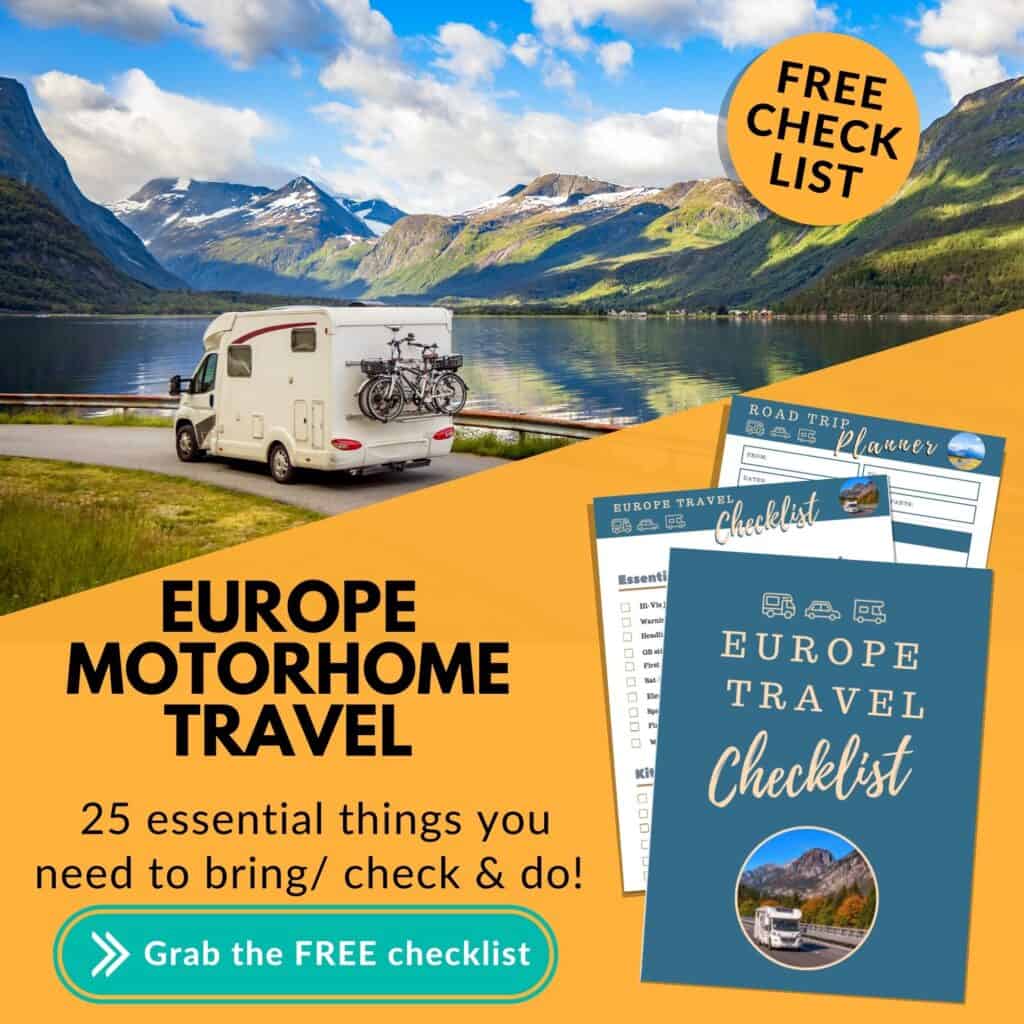
GUIDE: Stop the overwhelm with our step-by-step guide. Contains eBook, checklists and more. Complete Europe Motorhome Travel Toolkit
CHECKLIST: Don’t forget to grab your FREE Europe motorhome travel checklist HERE
GEAR – If you need any motorhome gear for touring Europe, here’s what we recommend.
Motorhoming in Switzerland- Where to go
When planning a motorhome trip to Switzerland, the first thing you need to do is decide where you’re going (and how long you want to go for!)
How long to go for?
If you’re driving from the UK to Switzerland (we’ll cover that shortly), you need to allow at least a day to get from arriving in France (by either ferry or Eurotunnel ) to the Swiss border. And that’s a long day of solid driving (it’s about 7 and a quarter hours (685km) from Calais to Basel, on the north-west border of Switzerland with France.
You can easily visit and explore Switzerland for just a few days or a week and it’s quite easy to drive around. Of course, if you have 10-14 days, you can see a lot more of the country.
How long does it take to drive across Switzerland?
Switzerland isn’t a huge country and you can drive across it quite quickly if you use the main roads.
As a guide, if you wanted to drive from Basel to Como (on the Italian border near Milan), it will take about 4 hours (300km)
If you want to drive across Switzerland from West to East, Geneva (on the western border with France) to St Moritz (in the East) will take about 5 and a half hours (480km)
However, much of the country is made up of the Alps (BIG mountains), so driving those take a lot longer as the roads are full of hairpin bends and steep inclines! Don’t underestimate how long a journey will take you, especially if you’re in a larger vehicle like a motorhome or campervan .
TOP TIP: If you want to drive into northern Italy and the Dolomites , you might find it faster to go through France and then through Italy, rather than negotiating the Swiss Mountains. Get more Italy road trip tips.
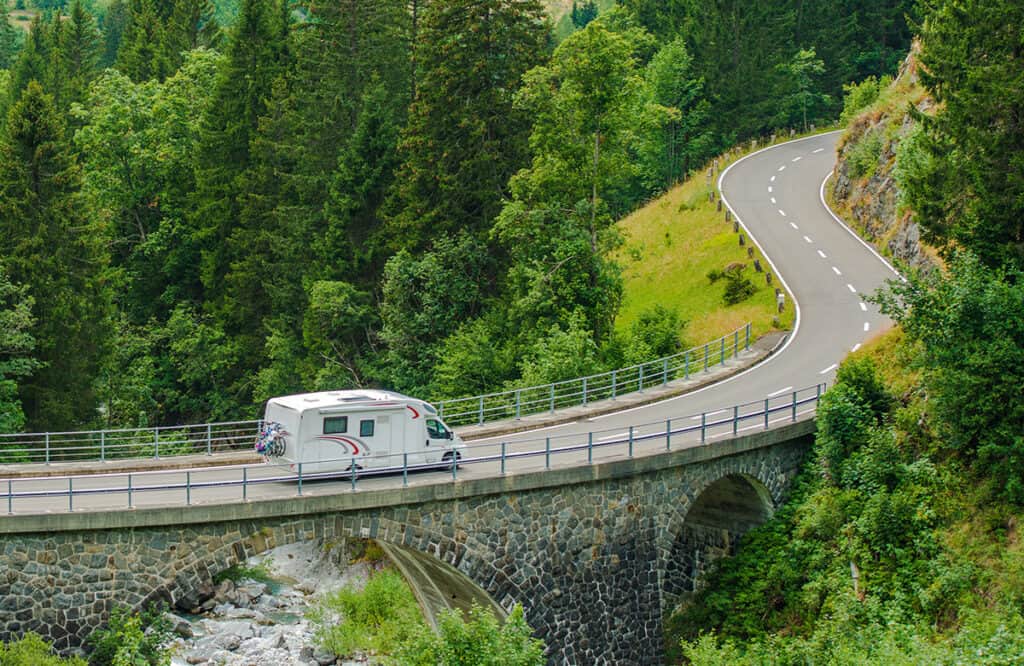
Highlights of a Swiss campervanning holiday
Some of our favourite places to visit in Switzerland include:
- Standing in the middle of the Rhine Falls – one of Europe’s biggest waterfalls.
- Driving in the Swiss Alps. They are breathtaking (scary, but breathtaking!)
- Going up the Gelmerbahn Funicular and visiting Gelmersee Lake
- Visiting Jungfrau and the train to the Glacier
- Titlis- with the world’s first cable car
- Beautiful Chillon Castle- right on the shores of Lake Geneva
- Winter sports. The slopes in Switzerland are world-class
If you enjoy reading books before a trip, here are some we recommend:

See more fun and practical motorhoming books we recommend reading
Best time to go campervanning in Switzerland
Switzerland is worth visiting at any time of the year, but for different reasons.
If you want to be able to drive freely and have all attractions open, go between April and October. Summer is very busy in the cities and major attractions, but the mountains are fairly empty.
Spring in Switzerland
Spring is lovely- as long as it’s after April. Although technically Spring starts on 21 February, the snows don’t fade until around the end of March, so April, May and June are a great time to visit. Avoid the Easter holidays if you can- prices get hiked up then.
But the flowers are beautiful- be sure to check out the Morges Tulip Festival at Lake Geneva in April. You can also visit Gruyeres on the first Sunday of May for the annual Cheese Festival- expect to try lots of yummy samples.
Summer road trips in Switzerland
Summer is perfect. Highs hit mid-20s, although it can always feel cool up in the mountains, but the skies are often clear and you can see the Milky Way at night. Of course, these means more people and more traffic, so if you are driving any of the crazy mountain passes, be sure to do it as early as possible to avoid oncoming tour buses!
A great day to be in Switzerland is Swiss National Day on 01 August. The entire country will celebrate with fireworks and parties – and they’re happy for tourists to join in.
Autumn in Switzerland
Autumn is actually my favourite time to go campervanning in Switzerland. The days are still long and mostly warm, the leaves look amazing as they change colours, and the crowds from summer have gone.
TOP TIP: If you are travelling outside of peak season, definitely get an ACSI CampingCard – you’ll save a fortune on campsites all over Europe, including Switzerland
The weather can be chilly at end of October into November and many places close at end of October, so do your research if there’s something specific you want to do or see. If you enjoy wine, don’t miss the Basel Wine Fair which happens at the end of October each year.
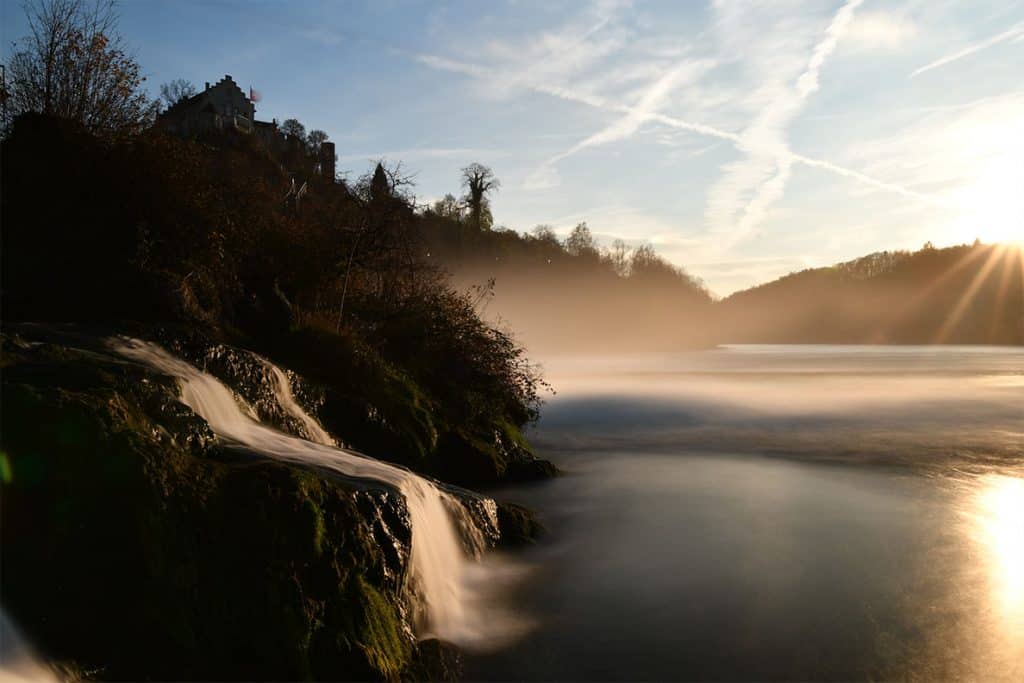
Winter campervanning in Switzerland
I’ll be honest, winter in Switzerland starts around the end of November and runs until April. It gets COLD, there will be lots of snow and you’ll need to prepare your van and yourself with appropriate gear. Make sure your campervan heating is working ok.
The days are also shorter, so you’ll have less time to explore.
Some of the panoramic mountain trains, like the Gotthard Panorama and the Glacier Express shut over the winter months and many mountain roads are closed due to heavy snow. Many of the funiculars and even some cable cars close during the winter too- due to adverse weather.
However, if you want to go motorhome or camper skiing , this is a great time to bring your van to the slopes! The best snow is usually from the end of December until March, but nature does love to be unpredictable! Skiing and winter sports are a BIG DEAL in Switzerland, so expect aires to be busy and campsites to be booked up well in advance. Also, try to visit during some of the world cup ski races- the atmosphere is amazing!
Don’t miss out on visiting some of the Christmas markets- Switzerland has some of the best Christmas markets in Europe. It’s also a great place to celebrate New Year, as some of the cantons in Switzerland celebrates it twice- once on 31st Dec/ 01 Jan, and then again on 13th Jan in accordance with the Gregorian Calendar! (This is called Silvesterchlausen)
New to motorhome or camper travel in Europe? You might find these posts helpful:
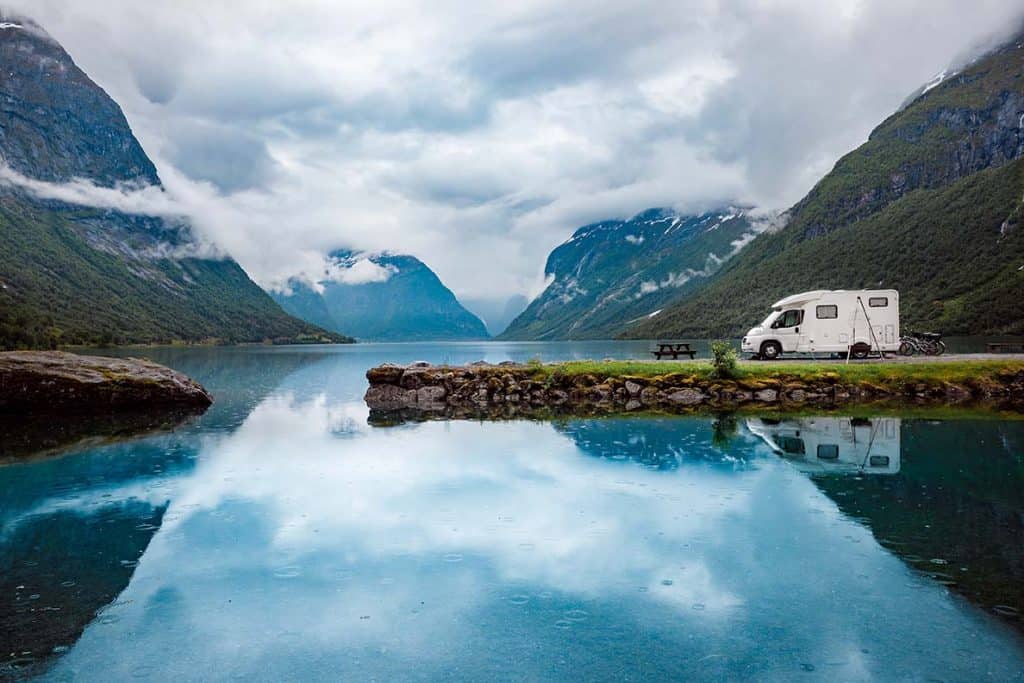
See all our Europe motorhoming posts here
NEED GEAR? If you need any kit or essentials for motorhoming in Europe, here’s what we recommend and where to find it
Planning a driving route from the UK to Switzerland
There are a couple of routes for you to get from the UK to Switzerland.
The most obvious is the Eurotunnel, which is generally cheaper and faster than a ferry (read more about the pros and cons of the Eurotunnel for motorhome trips here). If you use the ‘Chunnel’, you’ll end up in Calais.
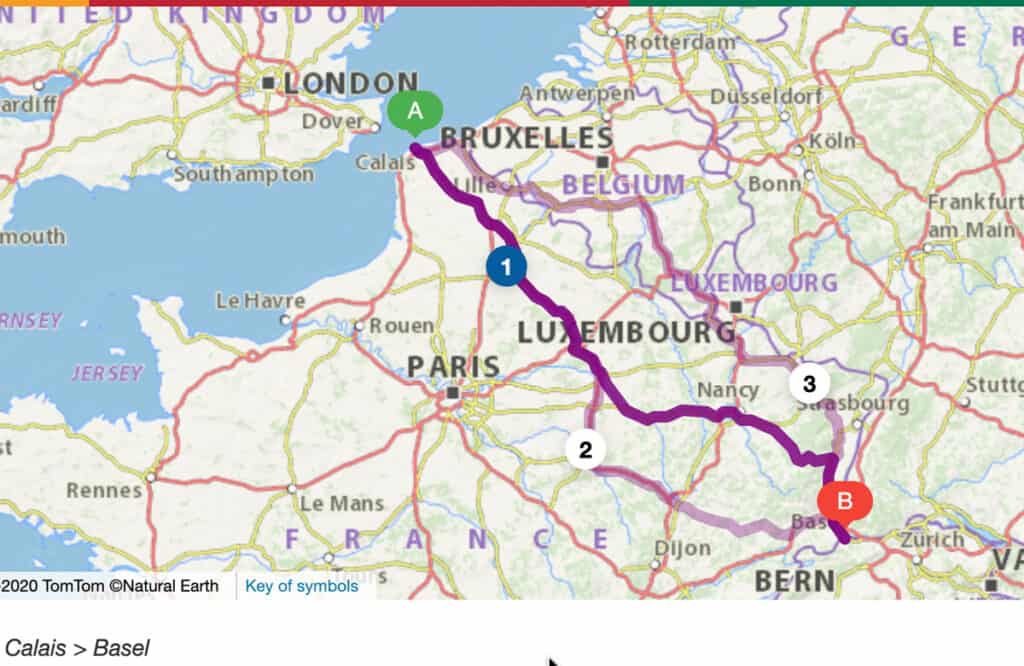
The quickest route from Calais to Basel (closest major point in Switzerland) is to the NE of Paris, via the A26 and then the N4. This route is around 685km, should take around 7h 25m and will cost about 33€ in tolls for a small camper or a car. A motorhome will cost more.
Route 2 is via A26, then N5 and is 725km long. This will cost a car or small camper around 48€ and is estimated to take 7h 39m
Route 3 is via Belgium on the E411 and then the A4. It’s longer, at 736km, will take 7h 42 but will only cost 9€ on the tolls. So it’s up to you which you choose.
You can learn more about Tolls in France and how to plan a route in our France route planner guide .
Some top tips for route planning:
- Avoid peak days and times on the Eurotunnel
- Try to avoid driving on the weekends or on bank holidays- LOTS of traffic
- Alternatively, get up early and do as much driving as possible before the traffic hits, then stop and have a nap somewhere safe- a huge advantage of having a motorhome or campervan with a bed with you!!
Can I drive to Switzerland in the Winter?
Yep. Generally the major routes are open all year, unless you happen to be really unlucky and hit it in the middle of a snowstorm (do check the weather forecast before travelling.)
If this happens, then we recommend stopping for the night somewhere safe (again- the beauty of travelling in a motorhome) and then continuing on when the roads have been cleared. Don’t forget you will need snow chains and make sure you have fitted all-weather tyres- more on that shortly.
Make planning your next road trip EASY (& fun!)
When you’re planning a road trip, keeping track & organising all your ideas is often the hardest part. Fix that TODAY with our printable pdf road trip planner. Grab yours FREE now
This form subscribes you to our mailing list. We share tips, itineraries, stupid mistakes and guides like this for road trippers and motorhomers.
We never spam (yuck) and you can unsubscribe at any time.
Borders / Customs in Switzerland
Ok, let’s get the technical bit out of the way.
Switzerland is in Europe, but it is NOT in the EU. Therefore, there are border restrictions on what you can/ cannot take into the country (and out.) It also does NOT use the Euro- it uses Swiss Francs. (CHF)
Also, Switzerland IS in the Schengen Area, which means that if you are subject to a 90 day limit on your time in the Schengen Area (like UK passport holders are now after BREXIT), then your time in Switzerland DOES count towards those 90 days.
READ MORE: Driving in Europe after BREXIT- new rules to be aware of
Tobaccos and spirit limits
If you are entering Switzerland, this is what you can carry with you (for persons older than 17 years)
- 250 units/g cigarettes / cigars / other tobacco products
- 5 litres of alcohol (up to 18% vol.) and 1 litre of alcohol (over 18% vol.)
Border Crossings into Switzerland by road
There are many places where you can drive across the border into Switzerland. Some have a proper, official border where you will be stopped and asked to show your passport and other documentation. Other crossings are literally marked with a flag which you look at as you drive past. There are no guards, no customs control and no barrier.
Don’t forget you will need a vignette (more on that later), so you might need to stop at/ near the border to get one.
Bring a dog/ pet into Switzerland
You can bring your dog into Switzerland. They will need:
- Proof of rabies vaccination (now done as an Animal Health Certificate if you live in the UK).
READ MORE: New rules for taking your dog into Europe after BREXIT
Hiring a motorhome or campervan to tour Switzerland
If you don’t have your own vehicle, or don’t want to drive to Switzerland, you can easily fly in and hire one. Just make sure to ask how to get from the airport to the rental agency- not all of them are at the airport itself and you might need to book a taxi.
To rent a vehicle in Switzerland you must:
- be at least 20 years old, (certain car categories may require older)
- have had a driving licence for more than one year
- show identification (identity card for EU citizens or a valid passport for other nationalities)
Make sure you have proof that you can take the vehicle across a border into another country if that’s what you’re planning to do. Also, be warned- although most countries in Western Europe are generally fine, many hire companies ban travel into Eastern Europe with their vehicles- which includes Slovenia and Croatia. So check before you book.
You can expect to pay around £60/ day for a campervan in June out of peak season- be sure to ask the right questions so you know what to expect from your motorhome or campervan rental
Don’t forget, it is YOUR responsibility to make sure the vehicle has the required safety equipment. The on-the-spot fines apply to you as the driver, not the company. Check in advance with the company what kit they will provide with the vehicle and what you will need to bring.
Take a list of what is legally required with you and check it off one by one as you are given the handover. Do not drive until you are happy you comply with the local laws.
Want to rent a vehicle for your road trip?
These might help:
- Discover incredible deals for motorhome/ camper rentals
- Find the best deals for car rental
READ: 10 essential questions to ask before you rent a motorhome
Motorhome rules in Switzerland- what gear do you need to carry?
Just like motorhoming in France , there are certain things you MUST carry with you in your motorhome or campervan whilst touring in Switzerland.
Don’t forget, if you are driving through France or another country to get to Switzerland, you need all the kit required by that countries, as well as the kit needed in Switzerland.
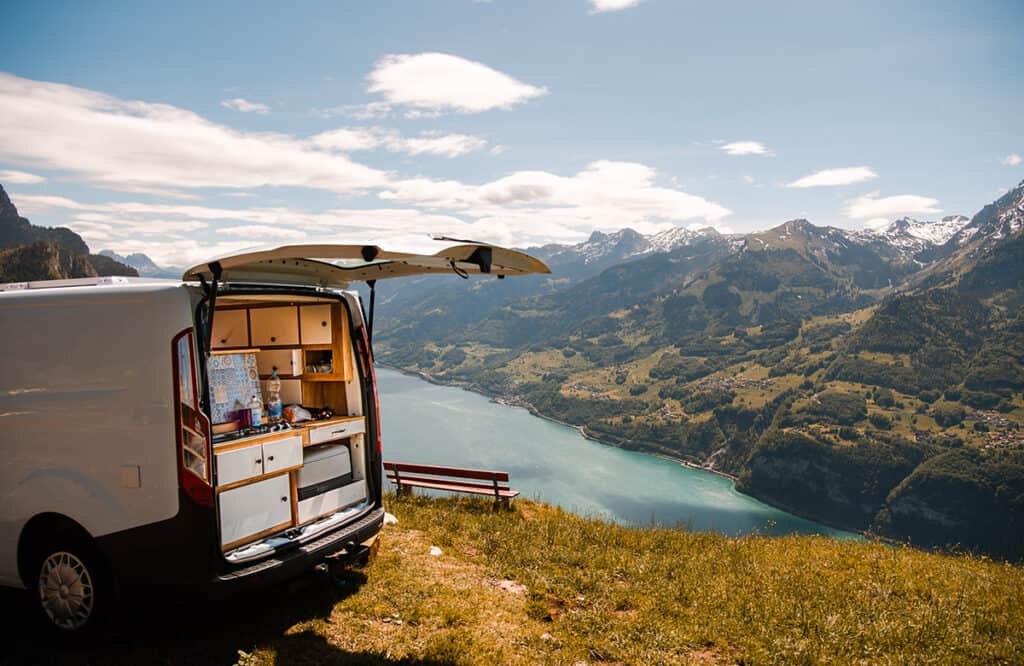
Things you need to drive in Switzerland- safety gear
These are the things you MUST have with you when you’re motorhome or campervan touring in Switzerland.
- Warning triangle
- Headlight beam converters – if you have a UK vehicle. These must be fitted before you drive in Europe. (If you have a vehicle which allows you to adjust the beam automatically for European driving, you won’t need these.)
- UK sticker attached to the back of vehicle or reg plates (and trailer if you have one)
- A vignette (see the Vignette section for more details)
- A spare wheel (and tools to change it!), or a tyre repair kit.
- If you wear glasses you MUST carry a spare pair
- Crash helmets are mandatory for motorbike/ moped riders and passengers
- If you are driving in winter, you WILL need snow chains (make sure they fit your vehicle) and winter/ all-season tyres should be fitted. ‘Ketten obligatorisch’ means Chains obligatory- you should stop and attach your snow chains.
NOTE: Hi-vis reflective jackets are NOT legally required in Switzerland but they are in both France and Germany, so you’ll need them if you go there.
TOP TIP: Buy these essentials for driving in Switzerland in advance. If you wait until you’re at the ferry/ tunnel, you could spend THREE times as much! See the latest deals and best prices on essential gear here

What documents do you need to road trip in Switzerland?
If you’re driving in Switzerland, you need to carry the following documents:
- Passport (or identity card)
- Driving licence (check it is in date!)
- Motorhome Insurance documents- check you are covered for driving in Europe
- Breakdown cover
- Vehicle V5 logbook (which must show your correct address)
- Vehicle must be legally taxed and MOT’d
- Trailer certification
- Green card (get from your vehicle insurer)
- International Driving Permit if required
- Personal travel insurance
Do I need an international driving permit to drive in Switzerland?
Most UK citizens do not need an IDP to drive in Switzerland, as long as you have a card driving licence issued in the UK (in date, of course!)
You might need one if you have:
- a paper driving licence only
- a licence issued in Gibraltar, Guernsey, Jersey or the Isle of Man
(If you do need an IDP, here’s an in-depth guide on how to get an International Driving Permit and which one(s) you need from a UK post office.
Vignettes in Switzerland
Most countries in Europe have some sort of charge for using their motorways/ major roads. They either use tolls, like France, or they use a vignette, like Switzerland. (Unless you’re used to motorhoming in Holland, where they don’t have anything!)
A vignette is literally a sticker which you must buy from an approved location and stick on your windscreen (in a specific place so the cameras can see it). Once it’s in place, you can then drive on any of the motorways or major roads (Classes 1 and 2) without worry- there are no tolls to pay.
Now, some people make the process of getting a Swiss vignette sound horrendously difficult. It’s really not, especially if your motorhome or campervan is under 3.5 tonnes. You can even order it online in advance and get it sent to your home before you leave from the website here .
How much does a Swiss Vignette cost?
A vignette currently costs 38.50€ per vehicle. However, if you are towing a caravan OR a trailer (and the total train weight is less than 3.5t), you will need to purchase a second vignette. Also if, like us, you tow a motorbike or a second vehicle, you will need to buy another vignette for that too.
So we, with a motorhome, a trailer and TWO motorbikes, would have needed to buy 4 vignettes if we wanted to ride the bikes in Switzerland. Although, in reality, we only needed to buy two (for our bikes) because our train weight with the motorhome and trailer was greater than 3.5t, so we needed the next level up.
Affixing the vignette to a trailer or bike isn’t as easy as on a car- it must be fixed “on an easily accessible part which cannot be dismantled and replaced.”
How long is a vignette in Switzerland valid for?
A vignette is valid up until the end of January the year after you bought it. (So the 2021 sticker is valid until 31 January 2022.)
And yes, you still need to buy one even if you’re only visiting Switzerland for one day, or even one hour, out of the year, assuming you want to use the motorways.
NOTE: the Vignette is invalid if you remove it. So be sure you won’t be returning within the time limit before you take it off.
Do you HAVE to have a vignette in Switzerland?
If you want to use the motorway network, yes- it’s compulsory. However, you can choose to drive just on the backroads and never buy a vignette- as long as your vehicle/ train weight is less than 3.5t.
What does a vignette NOT cover you for?
You will still need to pay for using any car trains, some of the bigger tunnels and any car ferries. There are also a few private roads which you will need to pay for if you choose to use them, like the Oberaar panorama road at the Grimsel pass.
Vignettes for vehicles UNDER 3.5 tonnes
If you have a vehicle with a train weight of less than 3.5t, and you haven’t bought a vignette in advance , you can buy one from the border or just stop at the first garage/ service station after crossing the border. Simples.
Vignettes for vehicles OVER 3.5 tonnes – Via App
If you have a motorhome which weighs over 3.5t, OR the total weight of your motorhome and trailer exceeds 3.5t, you can’t buy the ‘normal’ vignette. You must pay the HVF (Heavy Vehicle Fee).
To do this, you need to download the VIA app (from your App store or Android store). This App is actually REALLY good. It allows you to select your vehicle type, enter details, select dates and pay- all from within the app. You get a scannable QR code for border crossings if needed to show proof of payment. Find out more about the App and watch a video here
NOTE: If you are over 3.5t, you need to pay to use any public roads in Switzerland, not just the motorways,
I believe the current payment amount is CHF 3.25 a day (about £2.60) and there’s a minimum fee of CHF 25.00.
Touring Switzerland in a campervan- Other useful things you might need
We’ve been touring Europe in our motorhome for several years. We’ve tried all sorts of kit- some useful, some not so much.
Here is a list of things we highly recommend when motorhoming in Switzerland, but which are NOT essential:
- Motorhome WiFi – learn our favourite way to get internet on the road
- Toll pass (see below)
- TV- If you’d like TV in your motorhome or camper , here’s how to get it.
- Motorhome sat-nav – get one you can enter your motorhome dimensions into, like these
- Motorhome security camera – this thing is GOLD for allowing us to go exploring and leave the van for a short time.
- Solar panel- perfect if you want to wild camp in Switzerland with your motorhome
- Inverter- a motorhome wild camping essential
- An awesome motorhoming logbook to record and remember your adventures!
Motorhome Stopovers and Overnight camper parking in Switzerland
Like most countries in Europe, there are several types of places where you can stop with your motorhome or campervan overnight in Switzerland.
- Free/ approved motorhome parking schemes
- Wild Camping (we’ll talk more about the legality of that shortly)
Campsites in Switzerland for Motorhomes and Campervans
Campsites in Switzerland are much like other campsites anywhere around Europe. Some are very rustic, whereas others are incredibly well-equipped with pools, entertainment and more! They’re pretty easy to find, especially if you’re a member of ACSI or have a book!
You normally don’t need to book in advance unless you’re visiting in peak season, are going to a VERY popular one (like up Jungfrau) or are visiting a specific ski resort in winter. Also, if you’re a member of one of the UK’s biggest motorhome clubs , they have some sites in Switzerland which you can book through their systems.
Be aware that many campsites close at the end of the season, some as early as mid September and don’t re-open until Easter. So do your research, especially if you’re travelling out of season. There are some campsites here which are open all year.
TOP TIP: We’ve found campsites in Switzerland to be expensive, much more so than neighbouring France or Germany. If you can travel outside peak times, use your ACSI Camping Card to reduce the cost of campsite stays
Aires in Switzerland
An Aire is an approved motorhome and campervan overnight parking place. They are often paid, although you will find some in more remote areas which are free to use overnight. Many of them have motorhome service points- often for a small additional fee.
If you use an aire there will usually be a board with the rules displayed, such as how much it costs, how to pay and how long you can stay. Switzerland only has about 100 aires, so they’re not always easy to find.
READ MORE: Learn how we find and use aires and approved free overnight motorhome stopovers across Europe
You cannot book motorhome aires in advance- it’s first-come, first-served, so if you’re visiting at peak times you might feel happier booking a campsite so you’re assured of somewhere to stay.
A good tip is to try and arrive AT your destination just before lunchtime. Many people move on after. a lazy morning, and stop en-route, so you have the best chance of finding a spot around this time, but that’s when the day is at its hottest, so be careful.
There are very few motorhome facilities at an aire. You should be able to get water and empty waste, but don’t expect restaurants, pools or entertainment areas. Also, do not hang out the washing, get your awning out or put chairs out- this is camping and is not allowed- the police will stop and ask you to move.
It’s always worth investing in a motorhome book of aires, as well as an online app- just in case you find yourself without internet in your motorhome (or without a wifi signal). Of course, the downside with any book is that it goes out of date, but don’t worry if it’s only a year or two out- most information about aires won’t change too much. These also make great gifts for motorhomers.

Other Free Approved Motorhome and Campervan stopover schemes
Swiss Terrior is the Swiss equivalent of France Passion. It’s a scheme which connects vineyards, restaurants, farms and the occasional chocolate maker (yes, really!) with motorhomers and campervanners looking for safe places to stay overnight. If you’d like to avoid busy campsites and aires, but don’t want to risk wild camping, this might be the option for you.
The scheme is simple- you join up, and are given access to a collection of business who have agreed to provide overnight parking for motorhomes and campervans at their premises, in return for you spending money there, in the form of a meal, or buying some food (or chocolate!)
The one downside to the scheme (according to people who’ve used it more extensively than we have) is that most of the places are in the west of Switzerland and there are very few businesses who’ve opted in around the major tourist areas- the ones where the campsites are often fully booked (like Jungfrau).
Wild camping in Switzerland for motorhomes and campers
Ok, let’s talk about wild camping in Switzerland for motorhomes and vans.
The first thing to understand is that there is a difference between ‘overnight parking’ and ‘ wild camping’ when it comes to motorhomes and campers.
Usually (and I know I’m definitely guilty of this), we say ‘wild camping’ when what we actually mean is parking up overnight, and then moving on again in the morning. Overnight parking means no awnings, outdoor furniture, BBQs, motorhome generators , washing lines or anything OUTSIDE the vehicle.
Motorhome wild camping guides for the UK & Europe
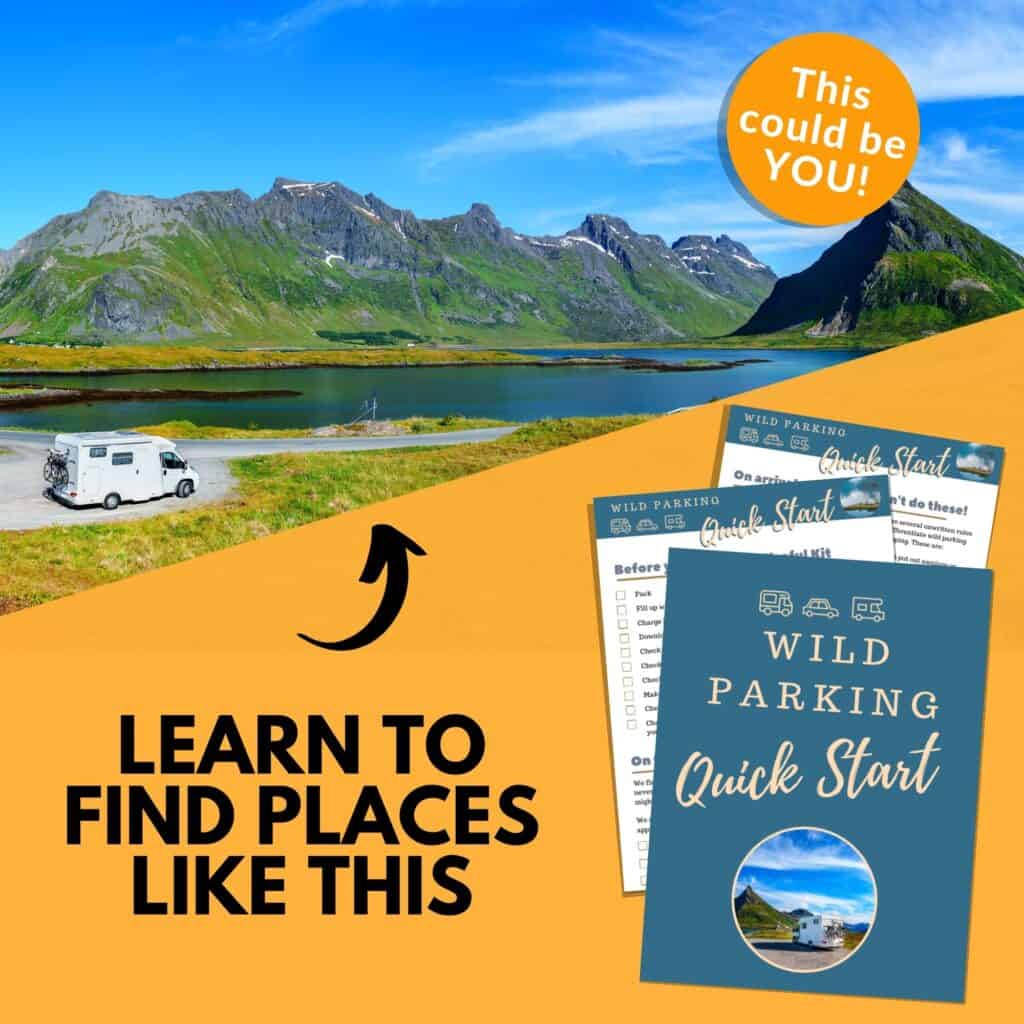
For information on how to find good wild camping places, WHAT to do when you’re there and how to stay safe, check out our step-by-step guide for motorhome wild camping in the UK and Europe, complete with database of 250+ overnight spots we’ve stayed with our motorhome.
Don’t forget to grab your free wild camping checklist here
Usually, overnight parking is not banned, but places may forbid it, like Geneva, who do not allow vans to stay overnight anywhere except on approved sites. Also, different cantons (regions) within Switzerland may have slightly different rules.
Wild Camping is a different matter, and is forbidden in Switzerland. You will be asked to move on and/ or fined by the Police if you look like you are camping with your van.
National Parks and Game reserves
Overnight parking is prohibited in the following areas:
- Swiss National Parks
- Federal Game and nature Reserves
- Wildlife protection or rest zones
Also, it is forbidden to light a fire in these areas, unless in an official fireplace. Fines can be up to 10,000€
Driving tips for Switzerland
Switzerland has a good road network. Most places can be reached by motorhome or camper, but some are only able to be reached by train or cable car.
TOP TIP: Pay attention to your speed. Fines are expensive! Driving just 11 km/h over the limit in a town could cost you CHF 250 as an on-the-spot fine
Some basic rules for driving in Switzerland:
- Switzerland drives on the right, like much of Europe
- Overtake on the left (NEVER undertake)
- Seat belts are obligatory for all passengers. Children under 12 years old/ under 150cm need an approved safety seat
- You need to have a motorway vignette properly fitted on your vehicle, unless you are over 3.5t
- Headlights must be switched on during the day.
- Traffic from the right (including cyclists) has priority.
- Traffic on roundabouts has priority unless the signs indicate otherwise.
- Police cars, ambulances, fire trucks and trams always have priority.
- You’re legally required to stop for pedestrians at a zebra crossing. NOTE: Trams do NOT have to stop, so don’t walk in front of one thinking it must give way to you- it won’t!
- Hands-free calling is allowed, but it is strongly discouraged. Handheld calling will attract a hefty fine.
- In some places, it is mandatory to turn off your engine when waiting for traffic lights, railroad crossings etc.
- You might wish to buy a parking disc, which shows traffic officers how long you have been parked. They are mandatory in some places.
- In-car speed camera detectors and motorhome sat-nav systems warning of the presence of radars are illegal (whether they’re in use or not!)
- Dash-cams are discouraged, as they impact people’s privacy and there must be a clear legal reason for using them.
- Minor traffic offences can result in on-the-spot fines.
- UK driving licences are perfectly acceptable to use and you probably won’t need an IDP (find out the changes made to driving in Europe after BREXIT )
- You will need a green card to prove you have motorhome insurance cover
Speed limits in Switzerland
Speed Limits for vehicles under 3.5t are as follows (unless otherwise signed!)
- Motorways/ autobahns- 120km/h (74mph)
- Major roads/ expressways- 100 km/h (62 mph)
- Outside built-up areas 80km/h (50mph)
- Built up areas- 50 km/h (31 mph)
Speed limits for vehicle OVER 3.5t
- Motorways/ autobahns- 100 km/h (62 mph)
Speed cameras in Switzerland
There are an estimated 1,000 speed cameras in Switzerland, which is a huge number for a small country. Again, pay attention to your speed.
Drink driving laws
Switzerland has stricter drink driving laws than the UK, only allowing 0.25 milligrams of alcohol per millilitre of blood (the UK is 0.8). As always, don’t drink and drive. If you are a new or a professional driver, there is zero-tolerance, so be careful what medication you take.
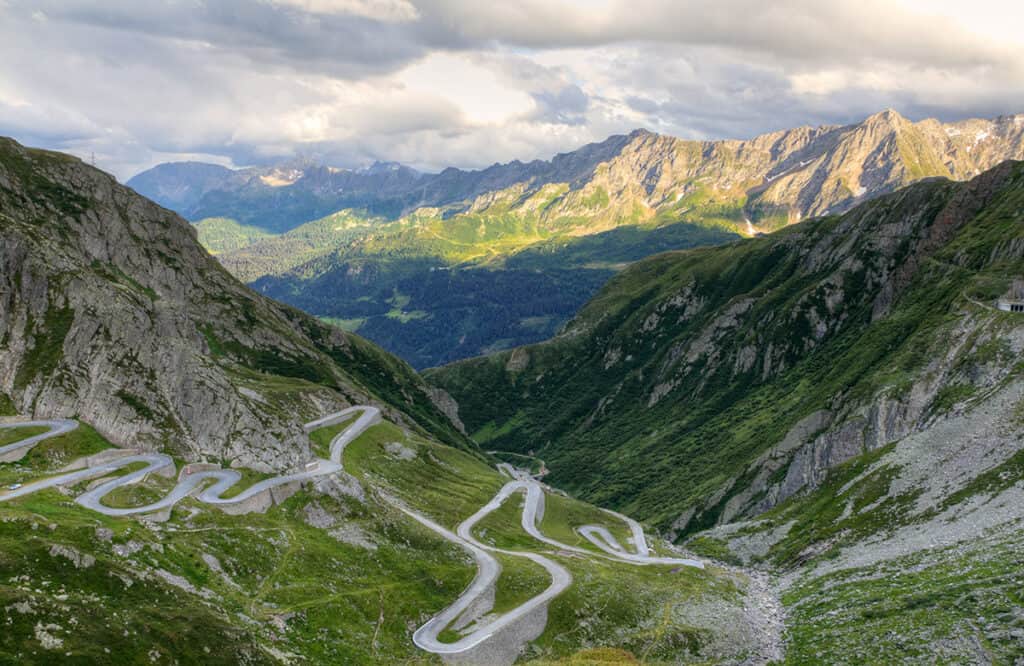
Tips for Driving in the Mountains
Driving in the mountains can be scary- especially in a campervan or motorhome. Here are some tips to help.
NOTE: On small roads, ascending traffic usually has priority. So if you are driving downhill, be prepared to give way to vehicles coming up towards you. The exception to this is the postbus, which has priority either way.
- Estimated driving times by navigation systems and route planners can be very optimistic. Take your time and allow extra.
- Try not to drive in the mountains after dusk- it’s even scarier at night!
- Many mountain passes close for winter. There are no fixed dates as it depends on snowfall Some higher passes can be closed until June.
- Some passes are too narrow or steep for trailers, caravans or motorhomes. Read the map and also any warning signs carefully.
- Make sure your vehicle is prepared and you have done your pre-trip checks.
- Make sure that you have adequate fuel- there are no fuel stations on mountain roads. Top up whenever you find a garage, even if it’s only half empty.
Tips for braking/ engine speed in the mountains
- When descending, use a low gear and high engine speed. The engine with help with deceleration, which in turns saves your brakes.
- Maintain as low a speed as possible.
- You will have longer braking time than you might be used to- allow extra room
- Assuming a 5-gear vehicle, it is usually sufficient to use gear 1 to 3 only.
- Your brakes will get HOT as you descend as you are using them almost-constantly. Try not to ‘ride’ the brake and give them a rest whenever possible. If possible, stop about halfway down in a safe place for 10-15 minutes and let them cool.
- Keep a high engine speed and don’t change gears so quickly (stay around 3000 – 4000 revs)
- If you gain speed, select a lower gear or gently use the brakes (not continuously.)
- Do not drive in neutral.
- If you have an automatic motorhome or camper, switch to manual mode for better control over the gears.
- Hairpin bends are tough, especially if you don’t have someone who can look for oncoming traffic. If in doubt, sound your horn before a blind bend and listen for a response.
- Don’t underestimate the stupidity of other drivers, especially those who don’t understand turning circles for large vehicles. They will try to cut inside you as you start to turn around a blind bend…
- Beware of cyclists on a descent- those people are crazy!!
- If you are slow and can safely pull over, let other cars past and indicate right to show your intentions.
What to do if your brakes fail
On our first trip to the Swiss Alps, our brakes failed. It was, without doubt, the most terrified I’ve ever been on a road trip. Ever.
You can read the entire story here , including the cause, but here are some tips in case that ever happens to you *touch wood it never does!*
- Try to decelerate as quickly as possible. Select a low gear and apply hard pressure to the brake pedal.
- Only pull the handbrake if the road is not slippery (if the surface is wet, you could skid)
- Do NOT put the vehicle into neutral
- If you can find an emergency road, a run-off road, a field (check there’s no ditch) or anywhere safe to run off into, use that.
- Worst case, drive the vehicle sideways into the wall- scraping down the side. It will destroy your vehicle, but you should be slowed to a stop.
Driving in Switzerland- what to do in the event of a road traffic accident
You should have a European Claim Form provided by your insurer before you leave. In the event of an accident, all parties complete and sign the form at the scene and then send a copy to your insurer for assessment.
What to do at the scene:
- Stop your vehicle immediately but safely- out of the flow of traffic if possible.
- If a vehicle is blocking the road, use hazard lights and put the red warning triangle 30 metres from the scene to warn approaching traffic
- Name and address of all the people involved in the accident
- Vehicle registration numbers of all parties
- Insurance company details of all parties
- Take photos of damage using a camera, GoPro or phone
For more details, read our step-by-step guide on dealing with a road traffic accident in Europe
“Rettungsgasse”
Switzerland, German and Austrian law requires drivers to create a Rettungsgasse (emergency vehicle lane) whenever there is an accident or emergency on the Autobahn. This is so ambulances, police or fire can get to the casualties.
NOTE: This is only for when you are pulling to a stop or very very slow moving.
If there are two lanes (going in the same direction), drivers must move their vehicles to the far right or far left (whichever is closest to you), creating a middle open lane for emergency vehicles. If there are more than two lanes then drivers in the right-side lanes stay far right, while drivers in the middle or left lane(s) go on the far left. The emergency parking lane (hard shoulder) should not be blocked unless signage or a police officer indicates otherwise.
You should keep all doors closed and avoid standing outside the vehicle so you don’t get in the way of any emergency service vehicles.
Wildlife accidents
It is a legal requirement to report any accidents involving wildlife to the Police. Around 80% of the country is designated as ‘rural’, so it is very likely that you may encounter wildlife on your journey. On small roads, be prepared to slow down or stop for cows, goats and sheep.
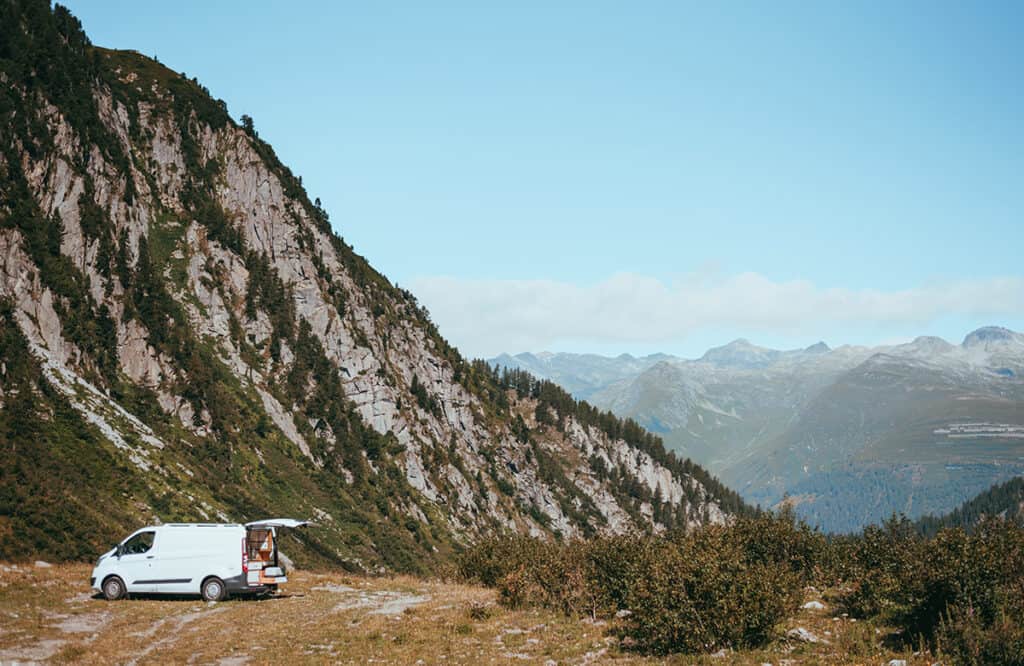
Petrol/ Diesel
There are plenty of fuel stations across Switzerland. As with everywhere, you’ll find the prices slightly higher on the motorways.
Petrol is Bleifrei (95 / 98), Sans plomb (95 / 98), Senza piombo (95 / 98) – Green handles on pump
Diesel is called… diesel. Black or yellow handles on pump
Some places are 24h pay at the pump, but may require you to go into the shop and pay the cashier either in advance or after you’ve filled up- there will be a sign to tell you what to do. (Leave your car in front of the pump and make a note of the pump number.)
You can pay using cash or a credit card. Many places do NOT take American Express. You can usually use your UK cards without a problem.
Getting LPG in Switzerland
LPG (GPL) can be found at selected petrol stations and at autogas stations. If buying from a petrol station, you may need to wait for an attendant to turn the system on for you.
You can find places which sell LPG using MyLPG.eu
Remember, if you don’t have refillable gas bottles , you will be unable to buy a gas bottle which fits straight onto a UK system- you need a new pigtail.
Switzerland uses the ACME connector and the Dish connector.
LEARN MORE: Learn how we find LPG in Europe for our motorhome
More useful things to know when campervanning in Switzerland
Some more tips to help you enjoy your time touring in Switzerland.
Emergency Numbers: 112 will get you everything
Language – The 4 official languages are French, German, Italian and Romansh. Different regions have different ‘main’ languages. English is widely spoken and understood.
Currency – Swiss Francs (CHF)- NOT Euros
Cards – most major credit and debit cards are accepted. American Express is only taken in large stores (not at tolls and often not at fuel stations)
Timezone – GMT+1 (or one hour ahead in BST)
Mobile Phone and Internet – It’s usually possible to use your UK phone and data in Switzerland, but do check with your provider.
Tipping- Tipping is not expected but appreciated. 5% – 10% in restaurants is standard if you are happy with the service.
Shops – Food prices are pretty expensive. Many shops close at 6.30pm and do not open on Sundays at all. Bigger supermarkets and garages may be open.
Some of the local dishes include:
- Cheese fondue (served in a pot with bread)
- Raclette (melted cheese)
- Rösti (fried potato cake)
- älplermargronen (the original mac‘n cheese!)
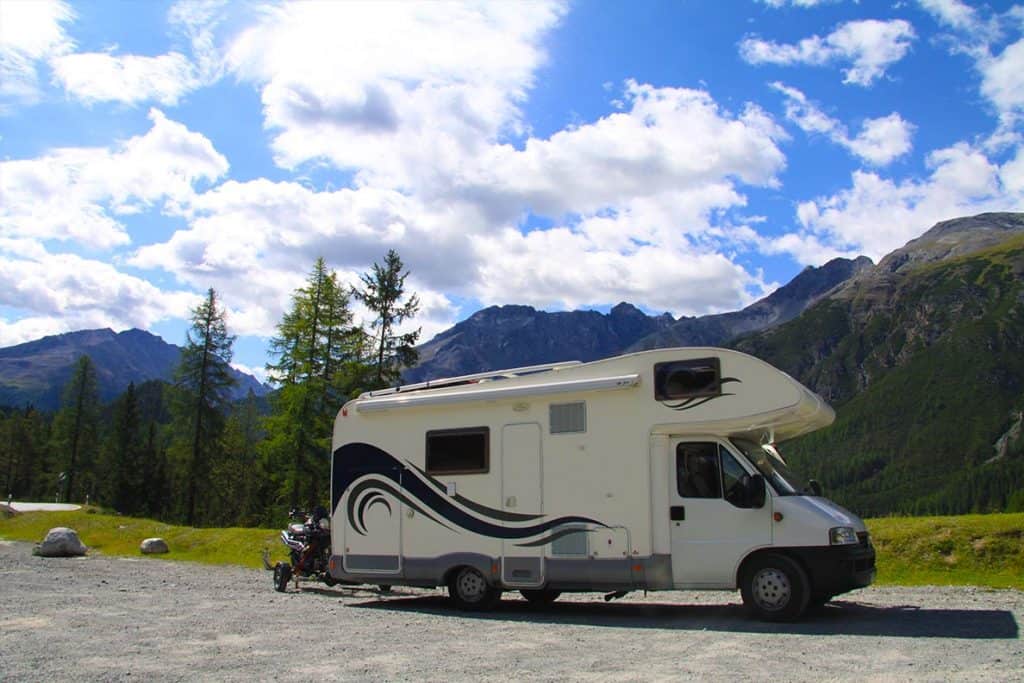
Campervanning in Switzerland- security
Switzerland has a low crime rate, but vehicle break-ins do happen, as do petty theft and pickpocketing.
We highly recommend paying extra attention to your motorhome security when travelling in Switzerland. You might even wish to fit an extra camper habitation door lock and never leave your vehicle unattended in an unsecure area.
READ MORE: Essential tips for protecting your van at home and on the road
Touring Switzerland with a dog
Switzerland is pretty dog friendly. In restaurants, bars and cafes, you can usually assume your dog is welcome unless there’s a sign (or employee) telling you otherwise.
Read more: changes affecting travelling to Europe with a dog after BREXIT
They are not allowed into public places like museums.
Dogs are welcome on trains and most public transport. Inside a dog carrier, they’re free of charge. On a leash will cost you a half-fare.
Don’t forget how hot it gets in summer and to make sure your dog is comfortable. Do NOT leave them in your motorhome or camper on a sunny day- vans heat up just like cars do. Here are some tips to keep your dog cool on a road trip.
To return to the UK you’ll need a vet on the continent to administer a worming treatment and then allow between 24 hours and 5 days before re-entering the UK.
Using a drone in Switzerland
You are allowed to take and fly your drone in Switzerland, but they are VERY hot on privacy laws and recording people without their permission- especially if you then upload the footage to Youtube or something.
READ MORE: What’s the best travel drone (and how to choose)
Drones and similar remote-controlled flying devices must be kept at least a minimum 100m from people, vehicles and buildings that are not connected with the drone operator. Flying must happen in daylight only, below 150m and never fly closer than 5km to airports. The drone must always remain within the sight of the operator.
Please check for local regulations and military or other special restricted areas where all the aforementioned activities are forbidden by law. Here are current rules .
Other posts you might find useful:
- Motorhoming in Europe- complete guide
- Unmissable road trip ideas for Europe
- The best logbooks to record and remember your road trip
- Essential motorhome checks to do before you travel
See all our Europe travel tips and ideas
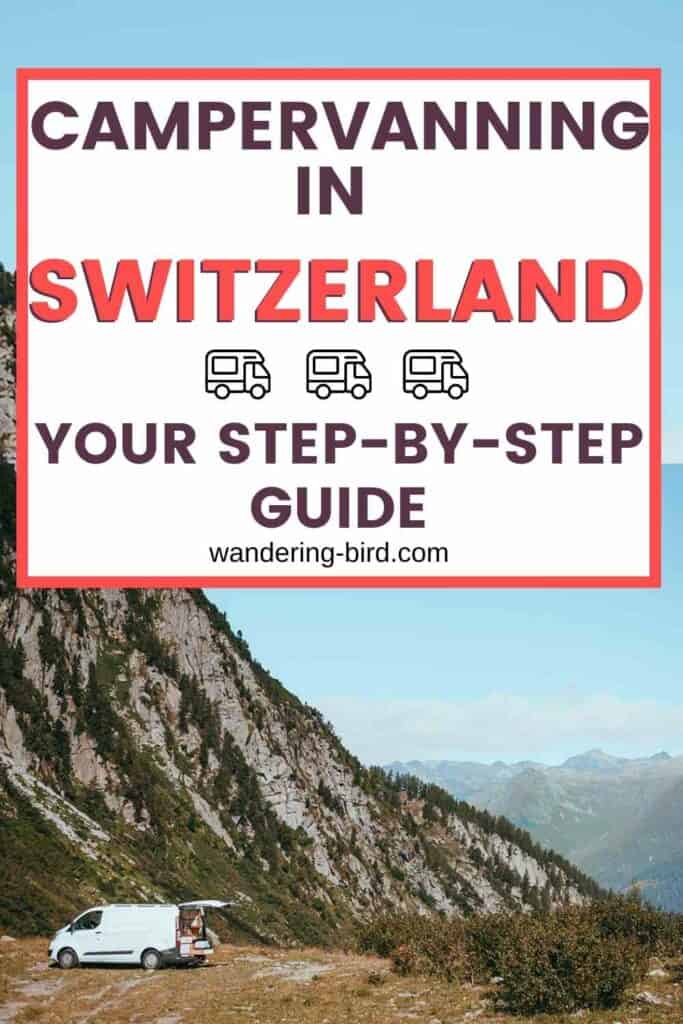
Kat never planned to buy a motorhome. She also never planned to quit her job as an air traffic controller, go touring around Europe in said motorhome, start one of the UK’s largest motorhome travel websites… or get a cocker spaniel.
Find out how she went from stuck in the rat race to being a digital nomad and inspiring thousands of people to have their own epic adventures here.
If you’d like to connect with Kat, send her an email or follow her adventures on social media.
Last update on 2024-04-30 / Affiliate links / Images from Amazon Product Advertising API
Sharing is caring!
Similar Posts
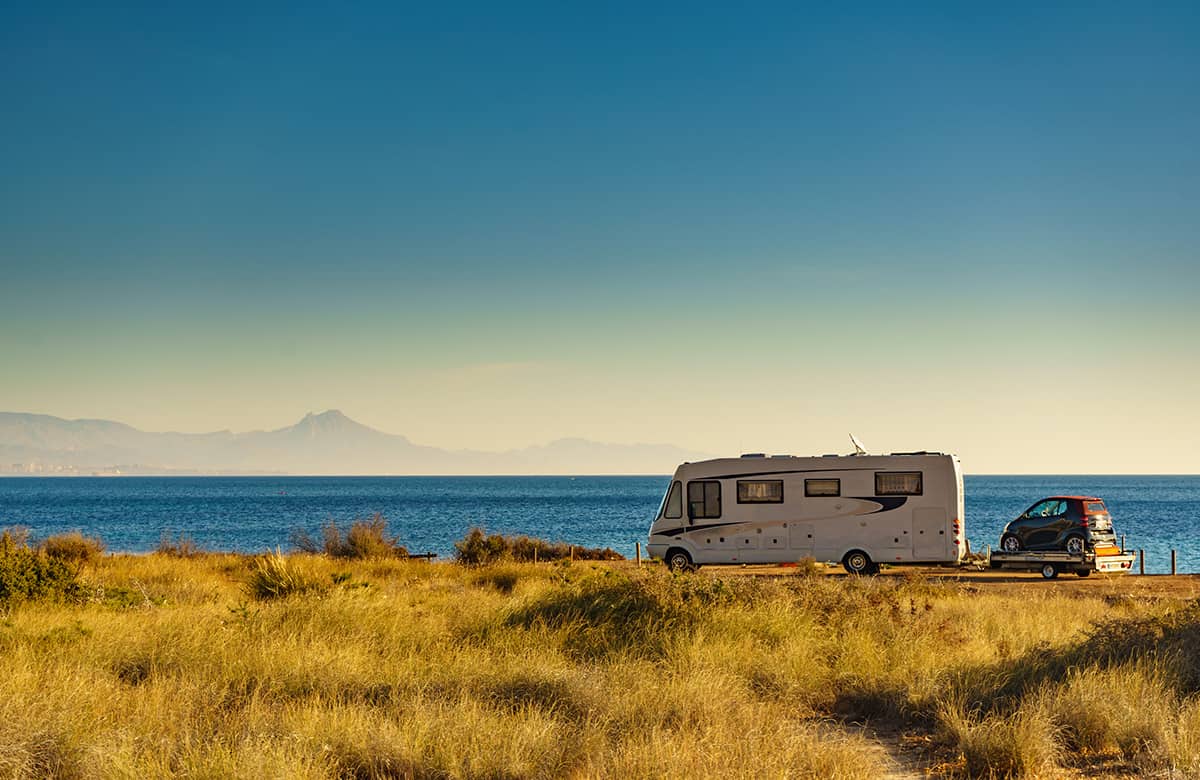
Summer Van Life: 21 tricks to keep your camper cool
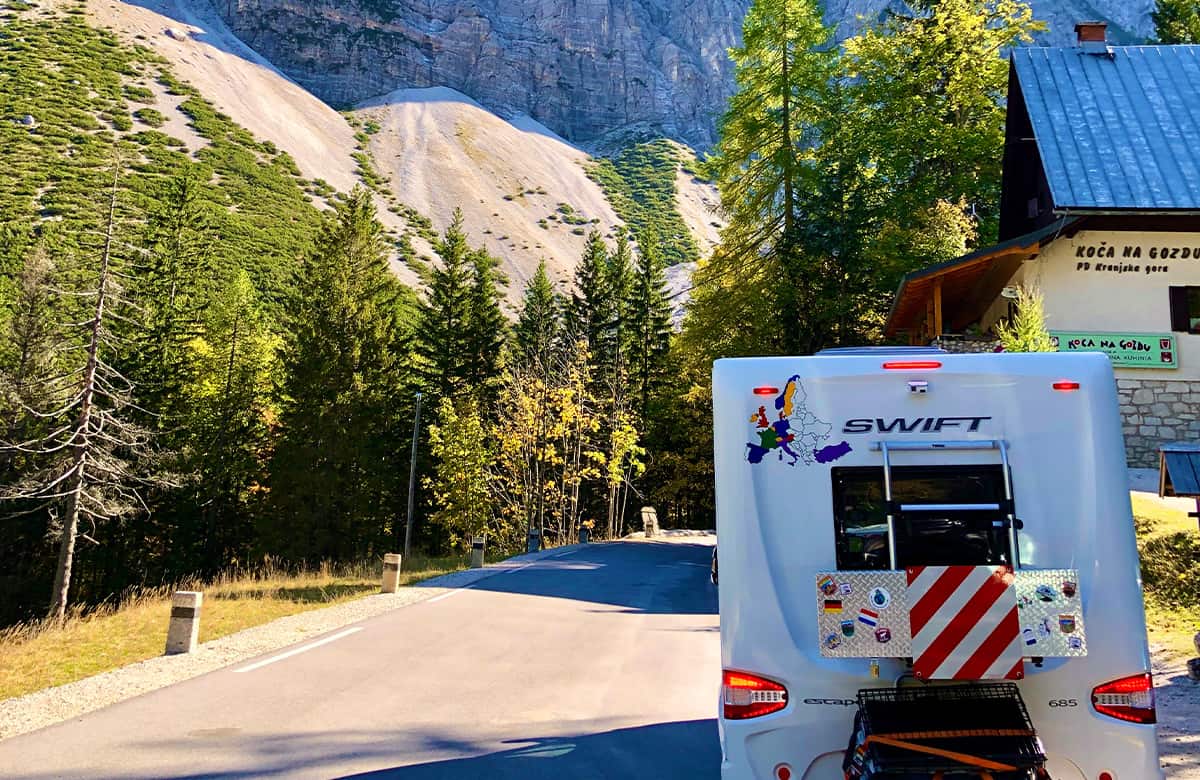
Red / White Reflective warning signs for motorhomes- do you need one?
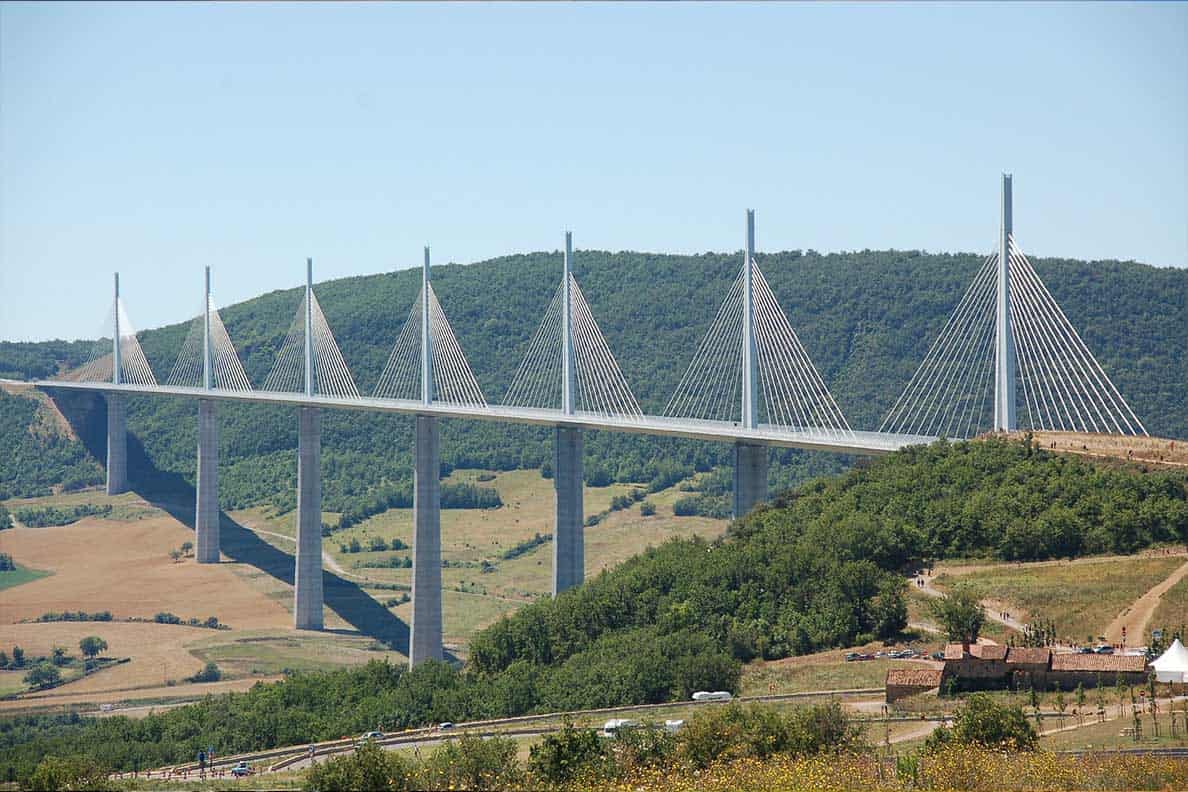
Crossing the Millau Viaduct in a Motorhome

7 mistakes NOT to make at Lake Annecy – don’t do these!
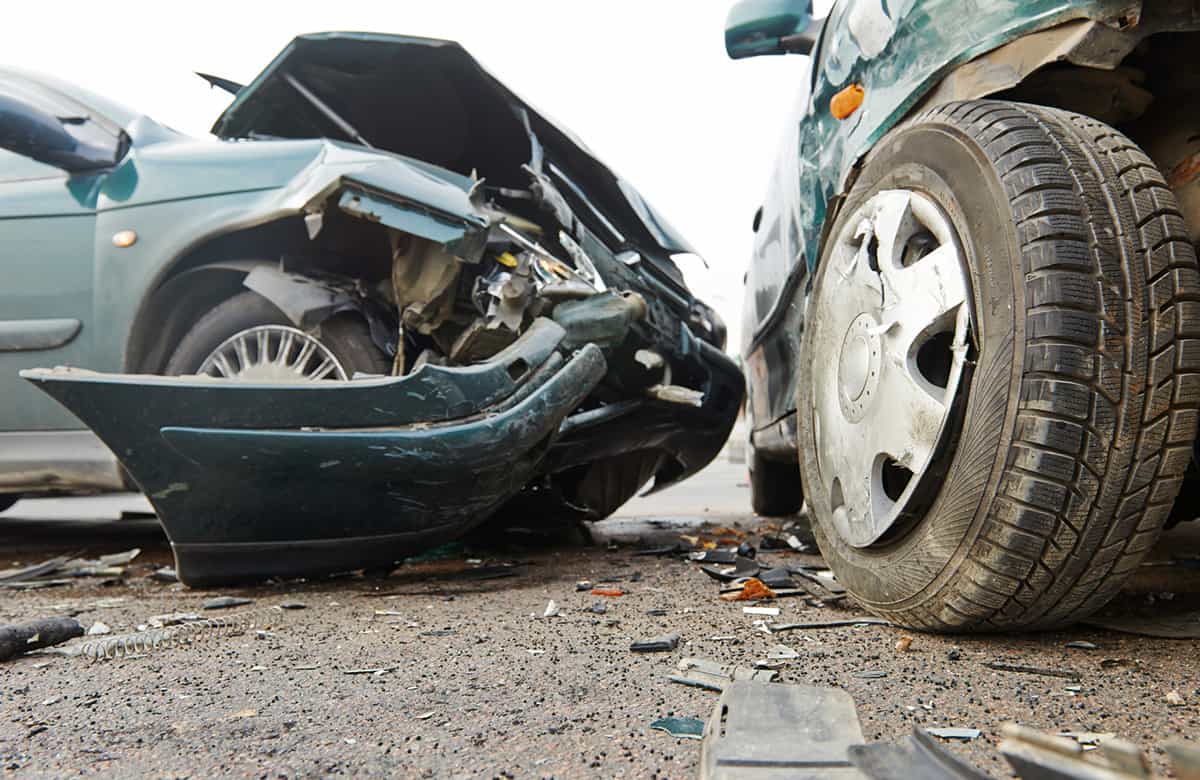
Car crash or road traffic accident in Europe- what to do
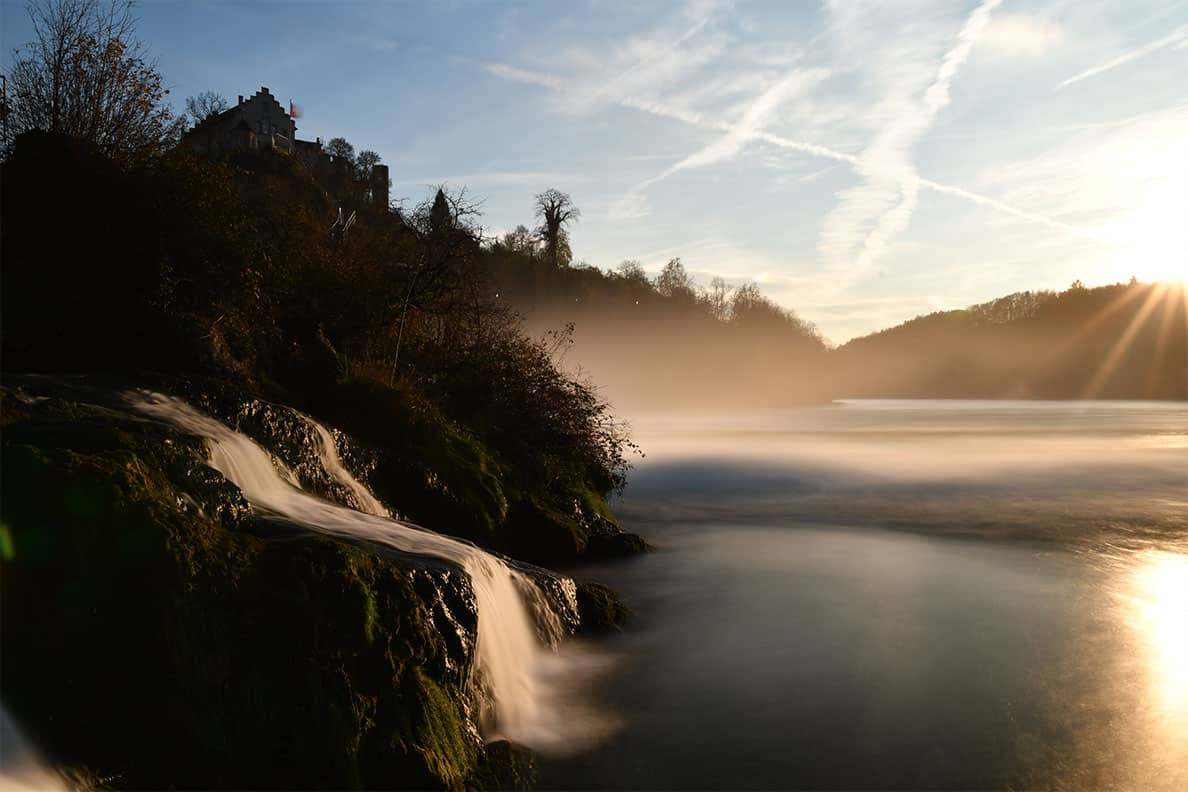
How to Visit the Rhine Falls- 10 things you need to know!
Leave a reply cancel reply.
Your email address will not be published. Required fields are marked *
Save my name, email, and website in this browser for the next time I comment.
A Unique Switzerland Campervan and Road Trip Itinerary

I may earn income from affiliate links or partnerships in this post. I spend time to curate tours or products that align with my values. Thanks for supporting my work, at no additional cost to you.
Last updated on January 31st, 2023 at 02:00 pm
A re you curious about the best way to see Switzerland? Well, then, this road trip campervan itinerary is just for you! Ganesh and I took a lovely trip through Switzerland this spring with our trusty campervan. Living in Munich, I’ve visited Switzerland several times, but slower traveling with a campervan was ideal for seeing this picturesque country. Switzerland has some great campsites ranging from well-maintained holiday parks to more rustic farms, which are perfect for a campervan, tent, or those renting a cabin. We loved our campervan road trip itinerary, which allowed us to experience some of the highlights of Switzerland but also got us off the beaten path for unique experiences.

Switzerland is a gorgeous country that gives you a sample of the very best of Europe. With 4 national languages, including French, German, Italian, and Romansh, each region has a distinct flair. When you’re in the French-speaking cantons, you’ll find rustic chateaus and rolling vineyards. In the German region, you’ll find delicious cheese and towering mountains, and in the Italian-speaking region, there’s great food, and locals extend their hospitality. The diverse landscape, language, culture, and cuisine packed into a safe and easy-to-drive country make Switzerland the perfect destination for a European campervan road trip.

This campervan road trip itinerary for Switzerland is fully customizable, so whether you have 7 days or 14 days, you can pick and choose the best stops and campervan campsites that work with your schedule. Before you follow my itinerary, make sure you head over and save/read my post about the best driving and camping tips for a Switzerland road trip with a campervan, which includes essential planning tips, what to expect at campsites, and recommendations for where to rent a camper. For this itinerary, you can rent a camper from IndieCampers which is located in Zürich. For a more budget-friendly option, you can also rent RoadSurfer from Munich or Freiburg and enter Switzerland near Zürich or Basel. We are based in Munich and drive a RoadSurfer.

WHAT WE’RE COVERING
Stop 1: Zürich
Stop 2: Bio Farm in Neuchâtel
Stop 3: La Fouly Glacier Camping
Stop 4: Interlaken Lake Camping
Stop 5: Lauterbrunnen Waterfall Camping
Stop 5: UNESCO Biosphere Camping
Discuss and Share
- Unique road trip itinerary for exploring Switzerland by campervan
- Discover hidden gems and still see the highlights
- Focus on nature-based and agricultural camping
- The perfect way to see a new side of Switzerland
Stop 1: Zürich – 1-2 Nights
If you’re renting based on my campervan tips post, you have a variety of entry options. If you’re coming from Munich as we did, Zürich is a great first stop. Zürich has a special place in my heart. It was the first place in Switzerland I ever visited while backpacking Europe in 2010. While I’ve come a long way from only being able to afford to stay in a spaghetti factory on my budget (that’s a story for another time), Zürich remains one of Europe’s most impressive urban sustainability hubs. As a modern European city with an upscale hipster vibe, my favorite thing to do when visiting the city is exploring the more grungy and artistic side, which is often overlooked.

Where to Stay in Zürich
Fischers Fritz is the closest and most popular campsite for the Zürich area. However, it can get very crowded, especially during peak season. So, I would suggest parking near Zürich to see the city for the day and then heading to Camping Sihlwald to access a beautiful nature reserve. You could also choose Camping Strandbad Turlersee , which is right on a lake with access to walking trails, lake swimming, and nature.

Of course, you can also choose to stay at a hotel in the city and park the van with them if you want to enjoy the most of your urban setting. I always stay in a recommend 25 Hours Hotel which oozes unique Zürich charm. In fact, with these campsites away from the city, you could easily spend 2 days in the area – one exploring the nature reserves near your campsite and the other seeing Zürich.
Things to do in Zürich
Alternative Tour of Zürich – In Zürich, I always recommend the alternative side of things. I suggest you visit the industrial district, the viaduct, and Rote Fabrik, which houses locally-owned boutique stores, art galleries, bars, and restaurants. Of course, the Alt Stadt can’t be missed for its authentic European charm. If you’re camping at Frischers Fitz, you can even walk along the lake into the city, stopping at some of the sights along the way.

Embrace Sustainability & Nature – Zürich is one of Europe’s sustainability hubs. A few zero waste shopping centers are a great option for filling up your campervan with packaging-free products. This helps reduce your waste while on the road and honestly makes cooking so much easier. Sihlwald Nature Reserve has some easy hikes, and Thurlersee has a fantastic walking trail that circumnavigates the entire nearby lake.
Driving: Zürich -> Lac de Neuchâtel
The drive from Zürich to my recommended campsite in Neuchâtel is pretty short, which means there is plenty of time to explore some of the surrounding nature during your drive. I do recommend leaving the Zürich area early to get a spot at the campground I recommend for Neuchâtel. If you want another city break, you can hop over to Bern, but there are three impressive nature parks on your way, and I would suggest getting out and stretching your legs in one of them.
The largest of the three, Doubs Natural Park is a great place for hiking, biking, and cultural immersion. The park is known for its impressive sustainability practices balancing traditional lifestyle with conservation. The park is home to impressive biodiversity, including the endangered checkerboard flower (Fritillaria meleagris ). There are two hikes in the region and sections of a long-distance bike trail. It is recommended you stop at the visitor center for maps of the two hikes.

If you want more of a challenging hike or opportunities for wildlife viewing, then visit Thal Nature Park . Finally, in Jurapark Aargau, you’ll find some great themed walking trails for opportunities to learn about rural agriculture, biodiversity, and sustainable development in the region. You can even plan a route and drive through all three!
Stop 2: Bio Farm in Neuchâtel – 2 Nights
When we first entered the Neuchâtel region, I stuck my head out the window like a dog, gaping at the beautiful rolling vineyards. Each vineyard had an impressive château with a stunning lake view. If you are a big fan of wine, this is the place for you! After we checked into our bio farm accommodation and got the campervan set up, we offloaded the bikes and took off on a bike tour through the vineyards. There are plenty of spots to taste wine and many mountain ruins to visit along the bike trails if you don’t have a bike or don’t like wine, no worries.
On our second day, we also took time to stroll through some nature trails and poked our heads into small towns filled with museums, cobblestone streets, and boutique shops. We spent two nights here fitting in everything we wanted to do but also scratched the surface. You could easily spend three nights at a more relaxed pace and have the opportunity to see more castles and museums and enjoy long hikes. If we were to stay longer, we would have left the bio farm and checked into a campsite along the lake for a change of scenery. You get a taste of the very best of Switzerland in this hidden gem of a region. Whether you prefer to spend the day indulging in a wine tasting in a French-style wine cellar, cooling off by the lake, or have an action-packed day with hiking and biking, there is something for everyone.

Where to Camp in Neuchâtel
The Coue: One of the reasons we choose this region is because of a specific camping spot. The Coue is a family-owned bio-farm near the sleepy town of Travers. This exclusive and off-the-beaten-path spot was a highlight of our Swiss campervan road trip. They don’t take reservations, so I recommend adjusting your itinerary to visit on weekdays or arrive just after check-in (around 2:30 pm). As soon as they open their gates, you can drive in and see if they have space for your campervan. Those on a road trip without their campervan can book one of the eco-pods or treehouse accommodations, which must be booked ahead of time on AirBnB.

We loved relaxing on the farm, watching the chickens, goats, sheep, horses, rabbits, and baby cows frolicking – they legit had baby cows frolicking through the campsite. There is a small shop with local beer, cheers, wine, farm-fresh eggs, and daily bio-baguettes. You can even order some pizza and have a sit-down dinner if you need a break from camp food. The bathrooms and showers were comfortable and clean. While this campground is marketed as a great place for kids, with a play barn and farm animals, we enjoyed our time as an adult couple. The farm is located on one of the main bicycle routes, and you can easily walk to Travers, a quaint town.

The owners both spoke French. Whether they spoke much German (our second language) or English wasn’t apparent. Ganesh got by with his basic French, and they never offered to switch to another language. If The Coue is full, you can try Hotel Camping Sutz, TCS Camping Gampelen Neuenburgersee, or any of the dozens of sites available in Neuchâtel.
Things to do in Neuchâtel
Wine Tasting: As you drive along Lake Neuchatel and Lake Bieler, you’ll be tempted to stop at every vineyard you see. We visited Château d’Auvernier, which was an excellent decision. This gorgeous winery offers a fantasy wine tasting, exploring their wines from traditional Chardonnay to premium Pinot Noir. You can even tour the wine cellar or take a moment to enjoy the sweeping views.

Explore Auvernier : After (or before) your wine tasting, I recommend just wandering the charming cobblestone streets of Auvernier. This small village has cute local shops and restaurants, medieval structures, and colorful doors framed with wisteria.

Bike Tour : If you’re like us and brought your bikes, I recommend doing a bike tour in the region. From the Eco farm campsite, you can quickly access a trail that runs from Travers to Les Verrières, a hilly but relatively easy ride exploring smaller towns and farmland and runs along a scenic river. There are chances to get off and do small nature walks to add some steps to your day. You can also do the wine road, which runs along the lake and take you from the winery to the winery for a day of biking and wine tasting.

Museums and Castles: If you prefer a little more hustle and bustle, you can head into the main capital to see the impressive Neuchâtel Castle. You can book an afternoon tour of the castle for about 5 CHF. There are also dozens of castles in the region, so if you are castle obsessed, this is the place to go bananas. Before or after your castle visit, explore the capital city. There are about 25 museums and dozens of castles in theCanton, so this is an excellent place for history buffs.

Driving: Lac de Neuchatel -> La Fouly
The next stop after Neuchatel is La Fouly, a mountain town surrounded by glaciers. Of course, we took our time getting there because there is plenty to see along the way. The beauty of a Swiss road trip with your campervan is stopping wherever your heart desires, so feel free to stop as you please or follow along with our recommended stops.
Montreux is a great option to stop for lunch. We’ve been eating most of our meals in our campervan, but we liked to stop for lunch at a restaurant on transit days. There are some great lakeside options along Lake Leman, like Le Fouquet’s or more casual eats. Don’t miss Château de Chillon , which is the castle that inspired Prince Eric’s castle in the Little Mermaid. If you prefer a quieter and more relaxed lunch stop, I can recommend La Terrasse du Port in the small harbor town of Port-Valais.

Pissevache is a stunning waterfall you’ll see on the side of the road. If you want to hop out and take a look, it’s a great place to stretch your legs.
Amphithéâtre Romain: We stumbled on this hidden gem of a Roman ruin and were so excited we did – as Ganesh loves ruins! There is free parking across from the ruin, and the ruin itself is free to explore. It’s not much, but it is a reminder of the expanse of the Roman empire. If you’re into St. Bernards and kitschy tourist stops, there is a St. Bernard museum at the same stop, which honors the legacy of St. Bernards in the region. We didn’t visit the museum as it was not our cup of tea, but it looked cute.

Enjoy the last stretch on your way to La Fouly. You’ll be heading up the mountain through winding roads and alpine farmland. Be prepared for narrow and winding roads, switchbacks, and the possible cow crossing, depending on the time of year.
Stop 3: La Fouly, Camping Among Glacier – 2 Nights
La Fouly is a mountain town that operates as a ski resort in the winter. This tiny yet charming village is an excellent hub for camping among glaciers and scenic hiking in the summer. Once again, we planned this stop around a campsite. I mean, who doesn’t want to camp among glaciers? We arrived later in the afternoon after spending the day sightseeing during our drive. We checked into our campground and found the perfect spot that suited our needs. Once settled in, we took off on a very short 1km educational trail walk before hunkering down at camp. Since it was rather chilly in spring at the high elevation, we cooked a hot meal, busted out the wine and whiskey, and allowed ourselves to take in the glacier views.
The next morning we woke up and headed out to hike, taking in the 360 mountain views. We packed lunch for the hike and took our time observing the flora. After another relaxing night, we got up early before packing up and hitting the road again. You probably don’t need more than two nights here, as the activities are limited and it is a very small area.

Where to Camp in La Foley
Camping Des Glaciers : The highlight of this stop is the campsite, where you camp among glaciers. You check in, order your morning baguette, and find an available pitch that suits you. We were traveling off-season, so we got an entire field to ourselves. You can choose a plot on a grassy field or rocky terrain underneath the glaciers. Each campground section has a bathroom, dishwashing station, and laundry sinks. Not every spot has power, so ensure your cord can reach the green power supplies. The bathrooms and showers are pretty good, but they aren’t close to some pitches. We made sure to stay near one as I frequently pee at night. Reception has great tourist and activity advice to help you plan your active outdoor holiday. There’s also a nice playground and cabins for rent.

Please offset your Switzerland campervan road trip itinerary through carbon offsetting with Swiss-based MyClimate or carbon-capturing with Tomorrow’s Air so we have glaciers to continue to camp underneath.
Things to do in La Fouly
Hiking, hiking, and more hiking: La Fouly is a hiking region, so you’re in the right place if you enjoy hiking. There are a handful of trailheads starting at the visitor center. We had planned on making the Chemin du Bouquetin trail. This is a more challenging day hike where you can hike up and down the mountain in a circular route or ride the gondola up and hike down for a more accessible option. However, when we arrived, there was still quite a lot of snow in the higher elevations, and the cable car wasn’t operating, so we opted for a lower elevation, Chemin du Bisse . This was a circular 5-6k trail that allowed for great views and a bit of forest traversing. We lost the trail through and ended up making out own way. Another lower elevation option is the Chemin des Places which takes you more through the forest. The region also has longer multi-day hikes such as the St. Bernard Trail and Tour du Mont Blanc.

Mountain Biking and ‘Extreme’ Sports: The region is ripe for mountain biking, paragliding, mountaineering, and mountain climbers. If you are more of an adrenaline junkie, you will certainly get your fix in the La Fouly region.
Nature Walk and Tree Tops: For those looking for a softer adventure, there are many nature-based options, including a zipline and tree obstacle course, which is part of the campsite. Also starting at the campsite is the Charlotte the Marmot nature trail. This trail is marketed for kids, but honestly, even as adults, we enjoyed learning about the region’s ecosystem. This light walking trail meanders through the woods, and you’ll learn about the wildlife and nature in the region.
Driving: La Fouly -> Interlaken
The drive from La Fouly to your next stop in Interlaken is a bit longer, but there are many great stops along the way. I’ve provided two options, plus an overall itinerary variation so that you can tailor the drive and next stop based on when you are traveling or your interests.
St. Bernard Pass is a must-do for those on a summer campervan road trip. The pass is hailed as one of the most amazing drives in the world. The easiest way to make the drive is to navigate to St. Bernard Hospice, but make sure you take the correct route, as there is an express tunnel to Italy or a scenic drive. You want the scenic drive. The pass is only open June-October, and you’ll want to check road conditions before you head out. If you reach the hospice and lake, there are hiking opportunities with St. Bernards, lunch, and views of high alpine lakes and mountains. For tips on mountain passes with a campervan, head over to read my Swiss campervan tips.

The Cheese Trails: If you are traveling during the offseason, like us, I recommend heading straight to Gruyère Pays-d’Enhaut Nature Park . This is a lovely area known for its long history of cheese making. You’ll find plenty of great stops for cheese and scenic hikes. Better yet, you can even hike the Cheese Trails and follow in the footsteps of mountain people who used to carry cheese from village to village. I recommend hiking sections of the Via Le Gruyere AOP for more leisurely walks ranging from 4km – 10km; however, if you prefer to swing by a fromagerie and pick up some cheese for the road, then F romagerie Bio des Moulins is the best place.
It is important to support bio-farming and agriculture in Switzerland to protect pollinators and healthy crop yields for the future .
I thought a few campsites in this nature park looked nice. You could certainly stop and camp in this region for the night if you want more time to hike the cheese trails and learn about agriculture in the region.

ALTERNATIVE ROUTE : We prefer to visit Zermatt for our skiing holidays, so we skipped the Matterhorn on this campervan itinerary for Switzerland. If you have your heart set on seeing the Matterhorn, this is the perfect spot to divert, driving from La Foley to the Zermatt region. I recommend camping at Camping Attermenzen, which views the Matterhorn for one night, before reconnecting with my itinerary in Interlaken. However, you’ll see plenty of impressive mountains and glaciers in Lauterbrunnen on my itinerary.
Stop 4: Lake Camping at Interlaken – 2 Nights
The Interlaken lake region is world-famous for its stunning lakes and scenic mountain views. After a long day of driving, we arrived at our lakeside campground in the late afternoon. We had enough time to check in, grab a spot on the water, and head out for an evening nature walk. The campground connects with the Weissenau Nature Reserve. The reserve was set up to protect rare nesting birds and restore their natural habitat. We lucked out; since we visited in May, the baby chicks had just hatched, and we spent hours bird-watching and taking photos.
Eventually, we made our way to the Weisenau Castel Ruin and the Thunersee Viewpoint. The following day we inflated the paddleboard and spent most of our time on the lake, paddling, picnicking, and exploring the nature trails connecting the camp to Interlaken. We stayed here for two nights and felt we had enough time to enjoy the region. However, you could easily stay longer and explore Interlaken.

Where to Camp in Interlaken
Camping Manor Farm is a superb location. The facilities were a bit dated, and the better spots could get grabbed up during peak season. However, we snagged a pitch right on the lakefront during the shoulder season and enjoyed a primarily crowd-free stay. The campsite has access to a nature reserve, ferry terminal, walking trails, ruins, Interlaken, observation decks, and more. The receptionist spoke English and was very helpful with tours and ideas in the region. The camp does require a J plug if you need electricity, but you can get one from reception for a deposit. There was a bar and restaurant available, but we made most of our food in our campervan, so we didn’t try it out.

Things to Do in Interlaken
Nature, Birding, and Ruins: Spring is the best time for birding, but there are opportunities for bird viewing throughout the summer. Historically the Thurnsee was an important lake for transportation, and over the years, humans built up the shores with fortresses, housing, and shipping terminals. This had an unfortunate impact on wildlife, as birds no longer had marshy areas for nesting. To rewild the region, the nature reserve was set aside to restore the marshy wetlands. Dozens of rare bird species moved back in. From your campsite, you can walk the reserve length, stopping to view birds from observation decks and with binoculars.

At the end of the nature reserve are ruins of an old fortress. It is free to enter, and you can go to the top for a stellar lake view. Make sure you go to the Thunersee View Point for the best view of the lake. It is a great spot to watch the sun begin to set before heading back to camp. The Lombach nature walk is a very easy trail that starts at the camp. The trail is flat and only runs for a few kilometers, making it a very accessible nature walk.

Lake Activities: If you brought your SUP, kayak, or any other boating activities (unfortunately, there are no rentals), then you can enjoy the proximity to the lake and spend the day SUPing. If you don’t have anything to take to the lake, picnic and spend the afternoon relaxing on the lakeshore.

Explore Interlaken: Interlaken is primarily a region but also a town nestled between two lakes. The town itself is a bit overrated, but there are a few things worth doing, most notably the funicular to the Harder Kulm observation deck.
Take the Ferry: If you want to explore more of Thunersee without your car, the ferry system is the perfect way to do so. I recommend taking the ferry from your campsite to Beatushölen Sundlauenen for a scenic viewpoint. There is then a walking trail along the cliffside that will take you to Merligen. From there, you can catch the ferry back to camp.
Driving: Interlaken -> Lauterbrunnen
If you didn’t take advantage of the ferry system to circumnavigate Thunersee, then today is a great day to drive the route. We circumnavigated the lake visiting the viewpoints and stopping in Thun. We parked for 2 hours and did a lovely walk along the river, visiting the Jakobshübeli observation deck and the Thun castle. We didn’t spend too much time meandering as we wanted to get to our next camp and explore the Lauterbrunnen region – a definite highlight of our Swiss campervan itinerary.

Stop 5: Lauterbrunnen, Camping Under Waterfalls 2-3 Nights
Lauterbrunnen is really the crem de la crem of this itinerary. The campsite we picked is literally at the base of several of the iconic waterfalls in the region. On top of that, the area is a home base for visiting Jungfrau, a towering glacier-filled mountain and Europe’s highest train ride.
We arrived in the later afternoon and geared up for a panoramic hike of the valley. After making our way through fields of wildflowers, cow pastures, and scenic compounds, all surrounded by powerful waterfalls and gigantic mountains, we ended up in downtown Lauterbrunnen. We grabbed a few drinks at the Hotel Horner and met some friendly locals before heading back to camp for the night.

Where to Camp in Lauterbrunnen
Camping Jungfrau: The campsite is large and modern, with ample pitches and rentals for all campers. The front desk was so friendly and gave us tourist information, we would even buy our Jungfrau tickets from then on another day. Most amenities were still closed due to the pandemic, but the campsite had a rec room, a small store, and plenty of fun in-house activities. Once we checked in, a camp employee escorted us to our spot. They gave us additional space on our pitch to follow covid requirements, so we had a whole row to ourselves. The bathrooms and showers were some of our best on this trip. From our camp spot, we could see multiple waterfalls and often fell asleep to the sound of cowbells and water crashing against rock. The campsite was close to town, the train station, and the waterfall experience, and overall had a good vibe.

Things to Do in Lauterbrunnen
Panorama Valley Walk: When you check into your campsite make sure to ask for a little map of the area. The map will include a 5km circular route around the valley. We were able to do this in just over an hour and it was fairly easy, but offered stunning views and a quiet intimate look at life in the valley.

Trümmelbachfälle: If you love waterfalls, this is the place for you. One massively powerful waterfall has carved out a channel through the mountainside, effectively creating 12 smaller waterfalls in a unique cave system. There is an entrance fee, and kids under 4 are not allowed in, even with an adult. There are thousands of stairs, dangerous water, and steep drop-offs. Once you pay and enter, you can take an elevator up, but if you’re physically able, I suggest the stairs. After 12 waterfall views, you’ll reach the top with absolutely breathtaking views of the valley. It’s no wonder Tolkien was inspired to create Rivendell after visiting.

Jungfraujoch: Visiting Jungfrau is a full-day adventure. You can buy tickets from the camp reception and catch the train from Lauterbrunnen station. The train ride alone takes almost two hours, and you must change trains once as you climb to the top of Jungfrau. Once you arrive at the top, you can explore the ice museum and exhibits. You can enter an observation deck, learn about glaciers, drink prosecco on ice, or if you’re prepared for hiking in the snow, you can even venture out to a hut for lunch before slowly working your way back down the mountain.

Cable Cars, Hiking, and Endless Views: The Lauterbrunnen valley teems with gondolas, hiking trails, observation decks, and just views for days. You could spend an entire week or more traversing the region and taking photos. Ask your receptionist for recommended hikes and routes based on your interest to make the most of your stay.
Grindlewald: While I suggest just staying in Lauterbrunnen and soaking up the region, you can access the popular Grindlewald from Lauterbrunnen by taking some gondolas and train. Grindelwald is picturesque and offers more alpine views.
Driving: Lauterbrunnen -> UNESCO Biosphere Entlebuch
Once you leave Lauterbrunnen, you’ll want to take the driving route along Brienzersee and then take the mountain pass called Panoramastrasse near Giswil to reach the UNESCO Entlebuch. The mountain drive is slow going, so take your time and use the scenic pull-outs for photos, or get out and stretch your legs at any of the countless walking and hiking trails. If any of the tourist offices are open, perhaps you can stop in and get some help planning your time in the region.
Stop 6: UNESCO Biosphere Entlebuch
This is the perfect spot for UNESCO and nature lovers alike. Entlebuch is a role model for UNESCO sites fostering gentle tourism to protect nature while revitalizing rural communities. The management model of Entlebuch is so successful it is renowned among UNESCO sites winning awards. Unfortunately, when we visited, many things were closed from the pandemic, but there were plenty of hiking opportunities regardless. The UNESCO site was founded to protect unique alpine marshland (moors) and stunning geological features (karst) while preserving traditional lifestyles.

Where to Camp in Entlebuch
If there is room at the inn, and you enjoy rustic and rural camping, then I hope you consider camping at Hof Grosschreie. There are only two places, and the owner is a full-time farmer, but camping here is a genuinely unique agricamping opportunity. You’ll get local knowledge about the best things to do in the biosphere and be able to buy direct from the farm. Even though the camping experience is more off-the-beaten-path, there are still facilities and even a little BBQ pit for cooking. If there isn’t room at the farm there’s a handful of campgrounds like Camping Thorbach and stellplatz (parking lots) in the area.
Things to Do in Entlebuch
Hire a Local Excursions Guide: Local guides can help introduce you to the area while sharing their years of knowledge on excursions such as bat viewing. You can even sign up for courses including mushroom collecting, painting, or yodeling classes. The courses are temporarily on hold, but when they resume you can learn about them online.

Hiking and taking a dip in the Kneippe: There are countless regional hikes. Your campsite or visitor center can help you find a route ideal for your fitness level, or you can explore some options here. After a hike, it is common in the Alps to cool your feet off in cold water. If you end your hike near the Kneippanlage Schwandalp , then you can enjoy this tradition if you’re brave enough to get in!
Environmental Education: If you want a more gentle day focused on learning about the biodiversity of the marshland, then check out the newly opened large moor path. With loads of informational signs, you’ll take extra steps and learn about alpine marshland. We have similar ecosystems here in Germany, which are some of my favorites.
Marbachegg: Take a gondola to the top of Marbachegg, where you can picnic, take a food tour, paraglide, or try mountain co-karting.
Driving: UNESCO Biosphere Entlebuch -> Zürich
Your unique and off-beat itinerary for Switzerland is coming to an end :(. From the Biosphere, you can drive back to Zürich. Along the way, you can take the gondola to the top of Mount Pilatus for views of Lucern. If you want more city breaks, then Lucern has plenty to offer.
Alternative Routes and Options
Of course, there are several opportunities to expand your trip. Instead of returning to Zürich, you can navigate down to Lugano via the Gotthard pass – another of Switzerland’s famous passes. I’ve driven to Lugano on a separate trip itinerary, and the drive is stunning. You can easily find camping spots using tips from my Switzerland campervan road trip tip post. Some ideal places for camping would be in the Naturpark Beverin or continue to the Appenzell District to see the Wildkirche. From there, you could continue back to Germany, if you’re based in Munich, like us, head back to Zürich, or drop down to Italy for my Italian Campervan Itinerary (coming soon).
Finally, suppose you want to keep following my European campervan itineraries into Spain (coming soon). In that case, you can reverse this unique campervan itinerary, dropping into France after staying at La Coue eco-farm.
I hope this alternative and off-the-beaten-path campervan itinerary for Switzerland helps you plan an epic road trip. With a focus on nature and hidden gems while still seeing the highlights this itinerary offers a fresh look at Switzerland.
- What part of this road trip itinerary looks the most exciting to you?
- Let me know if you have any questions to help you plan your dream campervan road trip through Switzerland

About the Author: Susanna Kelly-Shankar
Related Posts

Monfragüe National Park in Spain Guide for Nature and Birding

Nature in Spain – 15 Incredible Natural Landscapes in Spain

Montserrat Nature Park and Monastery – Day Trip from Barcelona
17 comments.
This is what offbeat travel is all about – the special experience. I have followed your journey on Instagram and it was satisfying to read through it in detail. You came across some really special places and all of it is so stunning.
Thanks for following along on Instagram! I really enjoyed seeing a different side of Switzerland with the campervan.
Switzerland is heaven! I have been there once and I think one can never get enough of the beauty.
It is hard to forget the beauty of Switzerland. You’ll have to return and see a different season – it’s beautiful in summer, winter, and even the shoulder seasons.
What an amazing road trip! I would love to do this. A very useful guide and itinerary, so saving this just in case I ever get the opportunity.
I hope you are able to visit! Seeing it all by campervan on a road trip is a great way to experience Switzerland.
I had no idea they made wine in Switzerland! This sounds like an amazing road trip!
Yeah, they make some great wine! Their shared border with the wine regions in France and Germany means they produce some great quality wines! A great reason to visit.
Okay, camping on Lake Interlaken would be a DREAM! I visited that area of Switzerland for 2 weeks and completely fell in love with it. Now, I love camping just as much so having both of those experiences together would be incredible! Thanks for sharing!
Yeah, it really was the perfect area to go camping. Many of the campsites are right on the shores of the lake.
Wow, this looks like an amazing trip! I love the mountains in Switzerland, and this looks like a great way to see the scenery. The Lauterbrunnen waterfall looks amazing!
Oh my gosh, that view of the waterfalls in Lauterbrunnen, Switzerland was jaw-dropping. It was a walking distance away from our campsite, which made it even more special.
I remember this from your Instagram’s stories! This looks like a fantastic itinerary; the landscapes in Switzerland are straight out of a dream, so beautiful!
Hi, this itinerary is inspiring, thus I will follow quiet the same route. Do you have the estimation of driving distance (in kms) for this itinerary? I would love to know it, to arrange my booking plan of the campervan. Thank you very much
Hey Mita, since we had our campervan on a long-term lease and were paying by the year, we didn’t keep a close eye on kilometers, especially since we drove in from Germany. I also have a few variations listed in the itinerary, so it depends on if you go to Zermatt, the St. Bernard Pass, or want to explore the eastern part of the country. I suggest you plug in the stops you want to make in Google maps and use the multi-destination feature or run the itinerary by the campervan rental company to ensure you are covered. Hope you have the best time in Switzerland.
Hi again, Mita, I just did a rough calculation, and this road trip was about 700-800 kms. But, again, the number greatly depends on the route you choose, and any alternative stops or detours you might make. It is an excellent reminder to keep track of stuff like this for the blog, and I’ll look at updating the post with an interactive map.
An schedule for a campervan road trip in Switzerland may be found in this post on the Curiosity Saves Travel blog. The author offers advise on selecting a suitable campervan, mapping out your travel route, and reserving campsites based on their own experiences and those of other travelers. Anyone considering a road trip through Switzerland in a campervan and looking for advice from a seasoned traveler should read this piece.
Leave A Comment Cancel reply
Notify me of follow-up comments by email.
Notify me of new posts by email.
This site uses Akismet to reduce spam. Learn how your comment data is processed .
Campervanning in Switzerland- Tips,Routes & Destinations
Switzerland has to be among the most beloved destinations for road aficionados, for a good reason. From dramatic alpine sceneries, purest lakes and rivers, delicate chocolate, and fairytale towns, there’s much more than meets the eyes in Switzerland. So much more.
Exploring the finest mountain roads in Switzerland – all from the comfort of your campervan -is a great way to discover Europe’s most scenic destination.
But, campervanning in Switzerland requires proper planning and research – especially if traveling for longer than a week. And this is where our handy road trip tips come in.

From France, Germany, Italy, or Austria, there are countless possible routes to visit Switzerland by motorhome. It all depends on whether you want to take the road trip through the majestic landscapes of Swiss nature or explore the country through its historical towns and landmarks.
Here are some ideas on how to know about hitting the road on the right foot.
1) A 7-Day Campervan Trip Itinerary in Switzerland
Campervanning across Switzerland for the week? Here is a neat 7-day road trip itinerary to ensure you make the most of your time.
Day 1,2: Geneva Old Town and Lake Geneva Shores
A full day in Geneva’s Old Town will more than impress you. The Old Town is a labyrinth of streets and allies, filled with charming cafes and restaurants. We loved how the Old Town features Geneva’s top landmarks and museums, and the incredible Saint Pierre Cathedral . Parking a campervan in Geneva can be done at TCS Camping Geneva-Vésenaz , just 4 kilometers outside the city, with prices depending on your type of stay, the duration, and the amenities you’ll use. After parking for the day, we recommend you walk Lake Geneva ’s shores for a picturesque view of the city and all the colors of the sunset.

Lake Geneva
Day 3: Lausanne
Lausanne deserves a whole day to be seen as it should. Take an hour’s time and make the drive there. Catch a breathtaking view of one of the many Lausanne national significant landmarks, or do what we did and visit its Notre Dame Cathedral – and peer at Geneva from the other side of the Lake . As for campervan parking locations, Lausanne offers C amping Lausanne Vidy , located right on the lake.
Day 4: Montreux
If you’re like us, you’d also want to come full circle around Lake Geneva and drive half an hour from Lausanne to Montreux . The town’s scenery is the epitome of campervanning in Switzerland on a high shelf. Montreux welcomes you with insane views of the Alps you can easily reach with a motorhome. Florals and a whiff of the Mediterranean make this spot the best for your around-Switzerland week tour. Campervanning areas to park your vehicle in Montreux include the city’s P+R Car Park , charged by the day or the hour.

Day 5,6: The Vaudois Alps
For a proper campervanning experience in Switzerland, we recommend you hit the Vaudois Alps. A complex of forests, mountain passes and nature like you’ve never seen before is before you. Visit the charming village of Les Diablerets , the region’s leading ski center. Or, head to the Gruyère Pays-d’Enhaut Regional Nature Park for a proper ‘wow.’
Campervanning parking options in the moutnain range include, Camping la Toundra les Mosses , Camping Frassettes , and Camping De Moratel .

Gruyère Regional Nature Park
Day 7: Fribourg
Settled among the clouds and built in medieval times, Fribourg takes you to a different era. We found it to be the ultimate getaway spot for motorhome campers who want to captivate a sense of gothic with a dose of mystery as well. And if you can stay there for the night, by all means, go for it.

Fribourg old Town
15-20 Days: A Campervan Trip Itinerary in Switzerland
For a longer campervanning excursion, consider the 7-day Switzerland road trip itinerary we offered above and expand it with the following destinations:
Day 8: Neuchâtel Lake & La Chaux-de-Fonds
The Jura mountains are proud of their top-tier Neuchatel lake and adjacent town. Marshlands, bird varieties, and vineyards will welcome you in and see you out of this radiant paradise. Another town under the Neuchatel canton we loved visiting – and so will you- is La Chaux-de-Fonds, just a 20-minute drive from Neuchatel.
Day 9,10: Bern
UNESCO-backed, vivacious, and a true campervanning paradise, we feel that Bern deserves a spot on your Swiss to-see list. Take your time in the Swiss road trip OG and make the most of its campervan spots, free outdoor pools, traditional gelato, and offroad trails inside the Gantrisch Nature Park. Yes, a few days in the capital are due – if you can help it.

Day 11-16 Lucerne, Zurich, Basel
Reserve your ride at a different time and spend a day or two in Lucerne. This Swiss gem boasts fabulous Old Town, historic sites, and a medieval feel. And for all you roadies, this waterfront town explodes with the best viewpoints, mountain passes, trails, and panoramic spectacles.
Off to Basel in an hour and a half or so, and you’re greeted with another staggering city that’s made for a drive-through and a stay-in. Another hour and a half take you to Zurich, Switzerland’s largest city. Also known as the world’s banking and finance center, Zurich completes this triangle of Swiss road trip gems to visit.

Sunset in Zürich
Day 17-20: The Honorable Mentions
Those wishing for a full-on Switzerland campervan road trip – sights, nature and all – here is what to do with a few extra days on hand.
- Ride off to the Oberland mountains for a royal spread of snowcaps.
- Pay Interlaken a visit, a city offering likely the greatest close-ups of the Swiss Alps.
- The Jungfraujoch glacier is left to the most ambitions, whereas the divine Rhine Falls will meet about anyone’s taste.
A Month or Longer Campervan Trip Itinerary in Switzerland
Staying for longer or up to a month? On top of the 20-day tour above, here’s what else not to miss on your Switzerland road trip.
The Elite Route: Valais, Lugano
As campervanners, we had a blast visiting Valais, Swiss’s undoubted paradise overlooking the everlasting Matterhorn. Alpine tracks, winter mountain passes, and divine routes are before you, enjoy. As for Lugano, it’s a few hours’ drive from Valais, so it’s best you combine it with a trip from Luzerne – or as its own Switzerland campervan road trip.
The Lakes: Maggiore, Constance, Walenstadt
One of the perks to driving through Switzerland is you get to see many, many lakes – for free. Lake Maggiore is the closest to Lugano, whereas Lake Constance is the nearest to Zurich. As for Lake Walendstandt, it is the closest to Lucerne . These make the Swiss holy lake trio and deliver scenic routes for all eager drivers and campers.
The Alpine Feel: Punta Terrarossa, Binn Valley Nature Park, Graubünden
Thrill seekers with some time to spare in Switzerland can always opt for one of the many alpine routes in the country. Get a divine view of Punta Terrarossa – or climb, if you are up for the challenge.
A more all-around experience is a drive to the astonishing Binn Valley Natural Park rich in pastoral landscapes.
Finally, for any of your extra days in Switzerland, a visit to the country’s oldest national park, Graubünden, is a must.
2) How and Where to Rent a Motorhome in Switzerland?
If you are coming to Switzerland looking to rent a motorhome, you’ll be happy with the options. Near the border is the first place to check for Switzerland campervan rentals.
As a leading provider, Roadsurfer is always a reliable option. It is a German campervan rental provider trusted by many, with rentals across various EU countries. In Switzerland, their rentals can be booked at the border, in Geneva, or in Basel. The customer support team at Roadsurfer is available, efficient, and resourceful, and the company offers many budget-friendly options for van lovers.
Aside from Roadsurfer, you can also trust a few other providers, including Indie Campers and the popular My Camper .
3) Driving a Campervan and Motorhome Rules in Switzerland
Driving across Swiss territory requires becoming familiar with their rules and regulations, especially with a campervan. Some of the things to know here include:
- Manage the technicalities. Keep your headlights on at all times and drive on the right.
- Drive within the speed limit. It’s not only safe but economical as well and prevents carbon emissions.
- Get a Swiss Vignette. You won’t be able to travel or enter the country without one and you can get it for about 40 CHF.
- Traffic coming from the right always has priority.
- The only vehicles that do not stop at a Zebra crossing are Trams.
- In some areas, it might be mandatory to turn off the engine when waiting at traffic lights.
- A parking disc might be mandatory to get in some places, so authorities know how long you have been parked.
Safety and Equipment
- Border crossing paperwork . Those coming from an EU country should know that Switzerland is not an EU-member state. The borders are recognized and clear for you to pass. If you are stopped, provide an EU-legal driver’s license.
- Have your campervan insurance paperwork on you at all times. Especially if renting.
- Legal props . All drivers are legally obliged to have a traffic triangle in the car and a safety vest.
- C02 and Carbon Offsetting. Campervans ought to use Diesel fuel with AdBlue. All campervans come with a carbon price, so keep an eye on the miles you drive throughout the trip. Following the trip, you will be able to carbon offset with Swiss-based MyClimate .
- Always have your seatbelt on – it’s a legal requirement.
- Have the essentials. You need a first-aid car kit, meaning spare tires and a rod to change the tires with. If you have a road accident, you need to create a separate lane so authorities can reach you.
Speed Limits & Signaling
- Know the speed limits. Every Swiss canton has different rules on this. Plus, speed regulations can change if the weather worsens. The driving speed limit in a Swiss town is 50km/h, 100km/h on highways, and 80km/h on roads out of town. A trailer vehicle can drive up to 100km/h.
- To help you navigate, the Swiss use different signals. Such include functional traffic light signals, alongside priority signs and road rings, and direction pointers.
- Have a language app working . Switzerland recognizes four official languages which change depending on the canton you visit. Get a translation app from and to German, French, Italian, and Romanish.
Alcohol Limit
- Across Switzerland, drivers are not allowed to drive if their blood level is over 0.05%.
- Over 0.05% to 0.079% of blood alcohol might cost you a fine of CHF 600-800. For other broken regulations, like speeding, you risk getting your license taken away for a month.
4) Motorway Tolls in Switzerland: Price for Your Motorhome Category?
In Switzerland, driving on motorways requires the use of an electronic vignette, for vehicles lighter than 3.5 tonnes. For vehicles over 3.5 tonnes, you will pay tolls in accordance with the motorway distance you traveled. This is also referred to as distance-based tolling. Then, there’s the Munt La Schera tunnel, which relates from Switzerland to Livigno and Bormio.
The tunnel has its own tolls and is open 24/7. It is the best route for all drivers, including campervan drivers traveling in the area, especially in winter. The toll price for the tunnel is CHF25.00.
5)Vignettes in Switzerland
- A vignette in Switzerland costs CHF 40, for all motorways.
- The vignette is valid for the remaining days of the current year and up to 31 January of next year.
- Yes. Driving without a vignette is illegal and might cost you a fine of CH 200, plus the purchase of a new vignette.
6)Motorhome Stopovers and Overnight Camper Parking in Switzerland
Overnight stops in Switzerland are abundant, with a few viable options to consider, including:
- Other free and approved motorhome parking schemes
Switzerland Campsites for Motorhomes and Campervans
Swiss campsites operate quite the same as other campsites across Europe. The condition of campsites can vary from less than favorable to elegant, with both options available to choose from. Booking a campsite is not necessary so long as you are not arriving in the heat of the season or at a popular campsite.
To make a booking online and early, you can look at the many Swiss campervan websites that provide this and are open year-round.
Take note, some campsites might work off-season and some won’t. So, check the campsite status before visiting, especially if you are traveling out of the peak season. Another thing to keep in mind is that campsites might be the priciest option of all, so always have a plan B or a planned budget in mind.
Switzerland c and Campervans
Another stayover option when campervanning in Switzerland is aires. These are designated and approved overnight spots for campervans and usually come at a more favorable cost.
Some aires might even be free to use, but these are typically located out of town or in a more remote area.
Using an aire for the night will come with several rules to comply with, including the payment method and service cost, and the stay duration limitations.
In Switzerland, there are about 100 aires – not great, not terrible – but all are easily found and reachable.
Booking an aire in advance is not an option, so here, the early bird gets the cheese. Come around lunchtime (when others are typically leaving), avoid peak times, and reserve your spot for up to 48 hours. Aires don’t have restaurants or amenities in the vicinity, so ensure you have enough food and water on you.
Some of the leading providers of aires in Switzerland include Camperstop Europe and All the Aires France.
Other Free and Approved Schemes for Motorhomes and Campervans in Switzerland
A viable scheme for your campervan stay around Switzerland is Swiss Terroir . This option allows campervans and motorhomes to find safe havens to spend the night – or two. This is a great option to consider if neither aires nor campsites are to your liking.
We like this scheme since it’s quite simple – you join the site and will be given a list of businesses who offer overnight parking for campervans on their premises. Instead of paying for this service, you can dine and buy food on-site, so everyone wins and earns without breaking the bank.
7)Wild Camping
Check our complete guide of wild camping in Switzerland
Depending on the Swiss road trip you take and the canton you’re entering, the rules may vary and differ. In terms of wild camping itself, since it is forbidden, you are to avoid it at all times. Otherwise, you might have issues with the police.
In Switzerland, overnight campervan parking is forbidden in all National Parks, Federal Game and Nature Reserves, and Wildlife Protection or rest zones. Parking aside, lighting a fire in any of these locations or anywhere except for a designated fireplace is also forbidden and can cost you a fine of 10,000€. Other rules wild campers – with an appropriately parked motorhome – and visitors have to follow include:
- Respecting nature and not taking uncharted trails;
- Not making excessive noise or interacting with wildlife;
- Leaving the campsite in the same condition as you found it. Pick up your litter!

Overnight Campervan Parking
8) When is the Best Time to Travel by Motorhome in Switzerland?
For the smoothest campervan road experience in Switzerland, it is best to travel between April and October. In the summer, heading for the mountains is less crowded than visiting any of Switzerland’s busy cities.
Spring Campervanning in Switzerland
Likely the best time to travel with a motorhome in the country. Spring in Switzerland might take a while to arrive – given the snows – but once April kicks in, you can be on your way. Easter is a very busy time in the country, so you might want to avoid urban areas with festivities, which can get quite pricey.

Lauterbrunnen in Summer
Summer Campervanning in Switzerland
Summer is the new black for campervanners looking to embark on a Switzerland road trip. With a moderate temperature and a breezy climate, summer is the best time to get your motorhome on the road. But, summer in Switzerland is also appealing to other tourists, meaning things can get crowded in the most popular areas. During the summer, traffic is also greater, so drive early to avoid jams.
Fall Campervanning in Switzerland
Many love the autumn season in the Swiss alps and metropolitan cities. And for a reason, fall in Switzerland is dreamy, colorful, and mild. By October, the weather can get edgier so if traveling then, choose designated sights you want to see. All in all, you can expect warm days until November and the occasional rain that gives any Swiss scenery a special appeal.
Winter Campervanning in Switzerland
By the end of November and until the end of March, Switzerland is in full winter mode. Heavy snows are likely to happen and persist as will strong winds, lower temperatures, and icy trails. Bringing the right winter equipment for yourself and your campervan is essential to make your journey smooth, safe, and pleasant.
If traveling during the winter, it is recommended you avoid slippery and uncharted mountain roads, as well as icy mountain roads that have not been defrosted yet. In winter, the days are shorter, so you’ll need to move with the daylight to see everything on your list. For snow aficionados, the best time to see it in full swing is between December and March.

Switzerland in Winter
A Wrap on Your Switzerland Campervanning Trip
With all road trip tips and information in one place, your campervanning in Switzerland can happen during any season.
And with millions of tourists visiting Switzerland every year, it is easy to proclaim this Alps-rich country among the most popular destinations for motorhome owners.
Whether planning a 7-day, a 15-day, or a month-long trip to Switzerland, sticking by their main regulations and recommendations will make for a smooth-sail journey. Don’t let your dream Swiss voyage slip through your fingers – get packing, researching, and booking, and set yourself up for a majestic adventure ahead!
Enjoying reading our posts?
Join our mailing list to receive all of our travel journeys and recommendations :-)
Welcome! From now on, you won't miss any of our news!
Rym is the cofounder of Walk Beside Me Blog. With a knack for connecting with people and cultures, she's explored more than 70 countries over the last 10 years. Rym's passion for travel blogging shines through in her 50+ blog posts on Walk Beside Me, making her a true travel expert.
The Perfect Itinerary for a Catalonia Road Trip [+ Valubale Advice]
How can you ensure that you’re respecting local customs when travelling, related posts, italy’s lakeside retreats: scenic beauty and tranquility, 16 stunning eco resorts in portugal: sustainable holidays..., 25 incredible best lakes in switzerland (+ alpine..., drachensee and seebensee hike in tyrol: the full..., 22 best lakes in bavaria (most beautiful +..., neuschwanstein castle in winter: your complete guide (+..., camping in tirol: the ultimate guide (+top 10..., 25 best lakes in slovenia that you should..., 9 amazing things to do in the dolomites..., the perfect itinerary for a catalonia road trip....
This website uses cookies to improve your experience. We'll assume you're ok with this, but you can opt-out if you wish. Got it Read More
- Destinations
Wild Junket

Driving in Switzerland: A Guide to Campervan Travel in Switzerland
Last Updated on March 7, 2024
Planning on driving in Switzerland? Here’s my complete guide to campervan travel in Switzerland, including Switzerland driving rules and parking tips.
Dramatic mountains, spearmint lakes, cute alpine towns blanketed in sparkling white snow — Switzerland is the winter wonderland that many dream of. Switzerland may be a small country, but it sure packs a punch with landscapes of epic proportions.
We have traveled Switzerland several times and experienced the country on bus, train, and most recently, camper van. I can safely say that a road trip is the best way to explore Switzerland . With your own vehicle, you can weave your way up the jagged mountains and into some of the highest points of Europe, and snake alongside sapphire blue lakes. Every turn of the road reveals new landscapes that will keep the entire journey exciting.

Table of Contents
Who can Drive in Switzerland?
Renting a car, renting a campervan/motorhome, when to go on a switzerland road trip, winter driving in switzerland, how easy is it to drive in switzerland, toll fees in switzerland, gas prices in switzerland, driving route for a switzerland road trip, mountain roads in switzerland, driving across the borders into/from switzerland, gas stations in switzerland, parking in switzerland, service stations & pitstops, wild camping, full-service campsites in switzerland, car insurance in switzerland, speed limits in switzerland, basic rules for driving in switzerland, driving in switzerland.
If your license is not in one of their official languages – French, German, Italian – or English, you need an international driver’s license (easy to obtain in your home country’s automobile association). So if you are from the US, UK, Canada or Australia, you can drive in Switzerland with your license.
Like most places, you have to be 18 years of age to be able to drive in Switzerland. Be aware that many rental car companies only allow you to rent a car if you are over 23 or even 25 years of age.
How to Rent a Vehicle in Switzerland
Car rental in Switzerland is relatively affordable. A 1-week car rental in Switzerland costs around US$365 or €300. We recommend booking a car rental online from Discover Cars before your trip. They consistently offer the best prices and customer service. Plus free cancellation. Check rates here.
Note that most cars in Switzerland still have manual transmissions . Be sure to choose an automatic car from the car hire company if you prefer that.

We drove our camper van from the Netherlands to Switzerland, and loved exploring the lakes and high mountains in the day while sleeping in our warm van by night. As Switzerland is so expensive, driving a camper can be a great way to save on accommodation and meals.
You can hire a campervan in Switzerland on Indie Campers or Goboony from €50/day and it comes with everything you need including camping chairs, bedding, cooking equipment. Make sure to look for a van that has heating, if you’re traveling in winter. We were comfortable as our van has heating provided by a boiler which is powered by external batteries.

It really depends on what sort of experience you’re seeking in Switzerland. I f you’re after long hikes and warm weather, then summer (June – August) is the best time to visit. Everything turns green and there’s no better time to immerse in Switzerland’s nature.
We visited Switzerland both times in winter (November – February), and we found it an excellent times to explore the charming alpine villages and snow-covered mountains.
However, you should be experienced in driving during snowy conditions. Read the next section on driving in winter.

If you’re planning a Switzerland road trip in winter, make sure you are prepared for snow and icy conditions. Although it’s not required by law, I definitely recommend using winter tires on your vehicle. Make sure you check with your car rental company if the car you’re hiring has them on.
If your van doesn’t have a heater, it’s wise to get some blankets, hot water warmers, and even a small heater before starting your road trip.
Also prepare snow chains in advance. We used our snow chains on some stretches (like the road to Grindelwald), and definitely felt the difference. Snow chains cost around €80-100 in Switzerland and can be found at any Coop supermarket.

It’s really easy to drive in Switzerland, as the country is practically designed for road trips: roads are well-paved, and there are regular rest stops and gas stations for refueling. Plus it’s a small country and driving distances are never more than a couple of hours.
Mountain passes are trickier, but they’re not too steep and managable for campervans like ours. Due to heavy snowfall some mountain passes like the San Bernadino pass are closed during winter. (More on that below)
As there are four languages in Switzerland, you’ll notice that road signs, place names, and information change as you travel across the country.For example, you’ll see “Sortie” which means “exit” in the French-speaking part of Switzerland, and “Ausfarht” in the German parts and “Uscita” in the Italian parts.

Cost of Driving in Switzerland
Let’s face it: Switzerland IS notorious for being expensive. Prices of accommodation and food can be exorbitant. Thankfully driving in Switzerland isn’t a lot more expensive than elsewhere in Europe. In fact, renting a car or driving your own camper is cheaper than taking the trains everywhere in Switzerland.
Car rental in Switzerland is relatively affordable — a 1-week car rental in Switzerland costs around US$365 or €300. Currently, petrol costs around €1.3-1.5 per liter.

To drive around Switzerland, you’ll need to get a vignette that costs 40CHF or €40 . It’s a sticker you need to apply on the inside of the windshield of your car.
When we drove into Switzerland from France, there were officials at the checkpoint who would make sure everyone had one. If you don’t have one, you can just buy one from them. Alternatively, save time by buying one online .
The vignette covers tolls on all roads in Switzerland and lasts for a year. In comparison to neighboring France, that is a lot cheaper than paying individual toll prices.

Gas in Switzerland is surprisingly cheaper than in neighboring countries. The prices fluctuate depending on season and where you fill your tank. We spent less on petrol here than at home in the Netherlands!
The average price is €1.3-1.5 per liter for unleaded petrol and €1.4-1.7 for diesel ( yes diesel costs more than unleaded petrol in Switzerland!).

If you’re looking to do a 2-week Switzerland road trip, I recommend focusing on the Basel, Interlaken and Montreux areas . Switzerland is all about spectacular mountains, countryside, and alpine villages. I prefer nature to big cities, and so I’ve designed this Switzerland itinerary with a focus on nature, and skipped cities like Geneva and Zurich.
Click here to see a detailed breakdown of my Switzerland road trip itinerary .
- Day 1-2: Basel
- Days 3-4: Interlaken & Lake Brienz
- Days 5-7: Lauterbrunnen & Grindelwald
- Day 8: Wengen & Murren
- Day 9: Glacier 3000
- Days 10-12: Montreux, Lausanne, Gruyères
- Day 13: Zermatt
- Day 14: Back to Basel

Things to Know About Driving in Switzerland
As Switzerland is one of the most mountainous countries in Europe, the mountain passes are some of the most scenic drives but also most dangerous routes in Switzerland. Expect a series of twists and turns, combined with a mixture of steeper and flatter sections. But don’t worry, they’re well-maintained and regularly cleared of snow. Just be alert and well prepared, and you’ll be fine.
As mentioned, mountains passes can be closed during winter due to heavy snowfall. Click here to check the current alpine pass statuses before driving.
Here are some of the most scenic mountain passes to drive in Switzerland:
- Bernina Pass — near Switzerland’s only national park
- Furka Pass — setting of James Bond’s Goldfinger movie
- Grimsel Pass — crosses steep ridges of Bernese Alps
- Gotthard Pass — connects north to south of Switzerland
- Gotthard Pass — sweeping valley roads and hairpin bends

Switzerland has borders with France, Germany, Italy, Austria and Liechtenstein . Driving across borders is very easy and straightforward. There are no border crossings or custom checks, even though Switzerland is not a member of the EU.
When we drove across in December 2020, there were officials to check if we had a vignette upon entry. Upon departure, they were quick checks to make sure we had nothing to declare. But they were fast and there was no custom or immigration.

There’s no shortage of gas stations in Switzerland, regardless of where you’re driving. Most gas stations in Switzerland are now self-service, which means you’ll need to pump yourself.
All of the stations we went to accepted foreign credit cards, and you usually pay straight at the pump without having to go inside the station. If your debit card works for bank machines in Switzerland, the card will also work on automatic gas pumps.
If you are driving a rental car, you must return the vehicle with a full tank. Our car rental dealer asked us to pump at a particular gas station right before returning the vehicle and to bring the receipt from the gas station when returning it.

It’s hard to find free parking anywhere in Switzerland — almost all carparks are paid. Most parking areas have parking meters or machines, most of which only accept Swiss Franc coins. Make sure to exchange/withdraw some cash so you can pay for parking. Some areas allow you to pay for parking via an app.
Finding parking space in cities can be a nuisance, especially in the old towns. Many restricted parking areas are reserved for long-term parking and require a permit.
Parking areas are designated with different colors. Here’s a chart to show you what each color means:
- white zones (white lines on the ground) – you can park free of charge for as long as you wish;
- white zones ‘pay and display’ – enter your car license number plate to buy a ticket at a street machine and display on the dashboard to park for a limited time;
- blue zones – get a blue parking disk from a gas station and set the dial on the disk to park for up to 90 minutes free of charge;
- red zones – free parking for up to 15 hours if you have a red parking disk, available from police stations, tourist offices and banks;
- yellow zones – parking is illegal.

Along the highways of Switzerland, you’ll find quite a few rest stops that are simply parking areas for a quick break. If you’re lucky, you can find rest stops with toilets, cafeterias, gas station, and sometimes a hotel. But those are few and far between (France has a lot more).
Coop Pronto, BP and Avia are some of the most popular gas companies. We found Coop to have the best prices. Highway gas stations usually charge higher rates than smaller gas stations.

Wild camping is technically not legal in Switzerland . You can’t just park your motorhome and spend the night on any beautiful spot along the road in Switzerland. You are only allowed to do so at designated campsites.
That said, you can still find remote spots in the mountains or valleys to park for the night through the Park4night app. That’s how we found parking spots in remote areas.
I would only recommend wild camping if you have heating in your vehicle. Our heating is powered by an external battery that is recharged by plugging to a power source. Every 2/3 nights, we need to park in a campsite in order to get the battery charged.

There are plenty of campsites all over the country, that are open year-round. If you prefer to park somewhere safe and have full services, then a campsite would be your best solution.
Most of them offer all services, including electricity, water, toilets and dumping station. The price for a night’s parking in a campsite is around 25CHF for a vehicle and 2 adults.

Third Party Liability Insurance (TPL) is obligatory in Switzerland. It covers third party damage or injury, which means that if you cause any injury to others in an accident, the treatment will be covered by your insurance.
I highly recommend getting travel insurance as well as it covers personal loss, theft, and medical on top of damages that may incur on your camper van or vehicle in Iceland. With the harsh conditions and extreme weather, your camper can easily suffer from damages. Refer to this post for details.

In Switzerland, traffic rules are enforced more strictly than in other countries. For example, a driving license can be withdrawn for one to three months if the speed limit is exceeded by 20 km/h. Similarly, severe penalties are imposed for exceeding the blood-alcohol limit of 0.5. Furthermore, a criminal complaint is filed. You are also required to drive with your lights on during the. If you don’t comply with these rules, you will be fined 40 francs, which corresponds to approximately 36.00 €.
These are the general speed limits for different areas:
- Residential areas: 30km/h
- Towns and cities: 50dm/h or 60km/h
- Country roads: 80km/h
- Dual carriageways/expressways: 100km/h
- Motorways: 120 km/h
*Vehicles over 3,5 tonnes should never exceed 100 km/h.
There are speed cameras in police cars and fixed cameras. Fines are graded according to how much over the limit you are in a certain area, for example, 1–5 km/h over the limit in a built-up area is a CHF 40 fine while on a motorway it would be CHF 20.

- They drive on the right and overtake on the left, then return to the right lane (on multiple lane roads). It is not allowed to overtake on the right, even if the left lane is blocked by a slower driver.
- Lights are mandatory to use at all times, even during the day.
- Do not drive barefoot or with flip flops.
- Public transportation (post buses, city buses, trams, trains, ambulances, police and fire engines) has right of way.
- Watch out for cyclists – you need to keep a distance of at least 1 meter when passing them.
- On narrow mountain roads, uphill traffic has the right of way.
- At a roundabout, the driver coming from the left (already in the roundabout) has the right of way.
- Children under the age of 12 and under 150cm (59 inches) height, must be secured on all seats by a device.

I hope you’ve found this Switzerland driving guide to be useful! Leave a comment below if you have any questions regarding driving in Switzerland or campervan travel in Switzerland. I’ll be more than happy to help!
Disclaimer: This post contains affiliate links to companies I use and trust. I get a small commission when you click on my links, at NO EXTRA COST TO YOU.
Inspired? Pin it!

Nellie Huang
Nellie Huang is the founder of WildJunket. Originally from Singapore, Nellie has traveled to over 150 countries across 7 continents. She is a book author and Lonely Planet guidebook writer. As an adventure travel blogger, she has a special interest in unusual destinations and deep experiences. Follow her travels on her Facebook and Instagram .
Leave a Comment Cancel Comment
Save my name, email, and website in this browser for the next time I comment.
This site uses Akismet to reduce spam. Learn how your comment data is processed .
The Comments
Maravillosa descripción y comentarios, muy útil para viajar a Suiza
Hi! Thank you for the amazing guide. It’s really helpful! I would like to ask about the camping sites, if you have a list of the ones you stayed or any recommendations of where to look for them. I am looking for the ones that are open during winter, specifically during Christmas. It’s been a tough search so far. Thanks in advance!
hey Sena, yes most of the campsites are closed in winter. We only stayed at one campsite and just wild camped the rest of the time. We had heating in our campervan, thank god for that! Try to get a small heater if your van doesn’t have it, as it’ll make a huge difference. Hope this helps!
Hi Nellie, I enjoyed your article travelling in Switzerland in winter. We are taking our VW camper van from the 1st November. We will consider taking a similar road journey to the one you did but, I don’t have winter tires fitted (just snow chains)… so do you think it would be a good idea to change the tires to winter tires or is driving during November going to be safe on normal tires? Thank you
hi Andy, sorry for the late reply! Apparently it’s not mandatory to use winter tires in Switzerland ( source ). I think the key is having snow chains and you have them, so that’s great news!
You May Also Like
Traditional german food: what to eat in germany, 20 best things to do in mykonos, greece, spanish food guide: best dishes to try in spain.
Unfortunately, we don't support your browser (Internet Explorer) anymore, some functionalities could not work. Click here to get information on how to upgrade your browser.

- Follow us on social media
Grand Tour of Switzerland by motorhome
Author: Freeontour / Tarja Prüss, Header image: Switzerland Tourism / Mattias Nutt Photography
Switzerland is a stunning, versatile travel destination with so much to offer campers. The Grand Tour of Switzerland demonstrates this impressively along 1,643 km where you'll be able to discover five Alpine passes, 13 UNESCO World Heritage Sites and 22 lakes. Freeontour presents the best places, attractions and camping options for your next Swiss adventure.
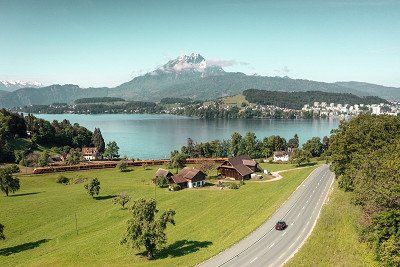
What is the Grand Tour of Switzerland?
The Grand Tour of Switzerland is a circular tour of Switzerland in 25 stages. It was developed by the Switzerland Tourism organisation to promote the most scenic routes in the country, which they have also marked with signposts along the way. Accordingly, this road trip is not so much about the destination, but rather about travelling itself. You'll rarely see a motorway, instead it's a leisurely, winding journey through valleys and over mountains from north to south and back again. To avoid closed passes – winter closure or snowfall – the best time for a trip around Switzerland is between May/June and October. If you start in Zurich, you'll first go past Lake Constance to Appenzell and St Moritz, then to Lugano, Zermatt and Lausanne in the south and finally to Neuchâtel and Bern. But you can also set off from Basel, from where it's about 165 km to Neuchâtel. You should, ideally, plan at least eight days for the entire journey by car to make sure that you have enough time for sightseeing, hiking or cycling. At least ten days are recommended if you are doing the tour in a motorhome due to the longer travel times. If you only have a week, expect to drive an average of six hours per day, maybe only managing half the tour and taking the motorway back. Freeontour presents the tour for campervans and motorhomes in eight stages, which should be spread over ten or more days depending on your interests and activities. You'll experience more than 2,000 metres in altitude when you consider that the highest point of the Grand Tour is the Furka Pass at 2,429 m above sea level and the lowest point Lake Maggiore at 193 m above sea level.

Alpine passes and motorhome restrictions along the Grand Tour
The Grand Tour of Switzerland goes over five Alpine passes that are at least 2,000 m above sea level: 1. Flüela Pass Length: 27 km, max. gradient: 10%, usually closed in winter from January to April/May, no restrictions for motorhomes, bypass: Vereina car shuttle station from Klosters Selfranga to Sagliains 2. Julier Pass Length: 16 km, max. gradient: 12%, accessible all year round (winter equipment is compulsory in the winter months), no restrictions for motorhomes 3. San Bernardino Pass Length: 17 km, max. gradient: 9.7%, usually closed in winter from November to May, max. vehicle width: 2.30 m, max. weight: 18 t, bypass: San Bernardino Tunnel (vignette required) from Hinterrhein to San Bernardino. Please note: in the summer of 2023, the tunnel will be closed occasionally at night during the week due to renovation work 4. Gotthard Pass (Tremola) Length: 24 km, max. gradient: 9%, usually closed in winter from October/November to May, the old Tremola road is only accessible for vehicles up to 3.5 t, bypass: new pass road (A2) or the Gotthard Road Tunnel from Airolo to Göschenen 5. Furka Pass Length: 29 km, max. gradient: 11%, usually closed in winter from October/November to May/June, bypass: car train from Realp to Oberwald Vehicles heavier than 3.5 t face one more restriction on the Grand Tour of Switzerland from Treyvaux to La Roche. They can take the alternative route via Serbache.
An overview of the stages
Stage #1: From Zurich to Appenzell, approx. 150 km Stage #2: From Appenzell to St Moritz, approx. 160 km Stage #3: From St Moritz to Bellinzona, approx. 160 km Stage #4: From Bellinzona to Zermatt, approx. 196 km Stage #5: From Täsch/Zermatt to Lausanne, approx. 175 km Stage #6: From Lausanne to Neuchâtel, approx. 165 km Stage #7: From Neuchâtel to Bern, approx. 240 km Stage #8: From Bern to Zurich, approx. 320 km
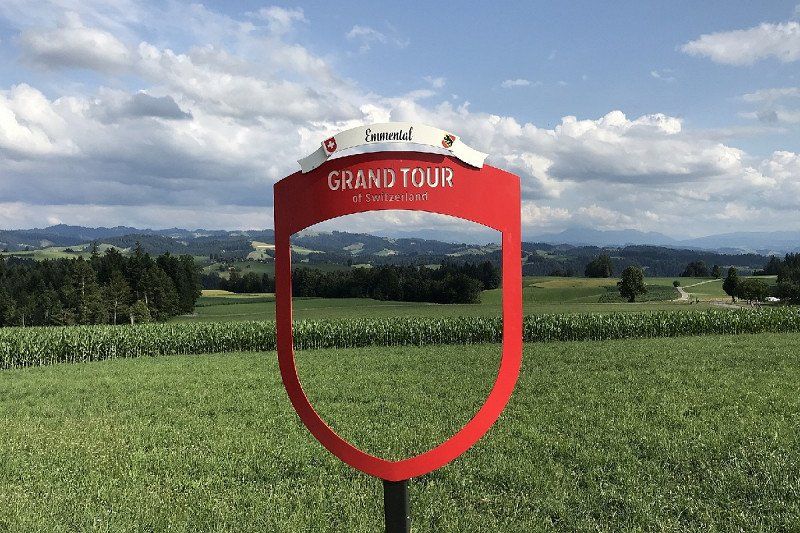
Alpine passes, lakes, panoramic routes - route suggestion for a round trip through Switzerland away from the motorways in a mobile home or camper van in 10 days. Those who take more time can enjoy the
This text was automatically translated using Google Translate and may be inaccurate.
Stage #1: From Zurich to Appenzell, approx. 150 km
Zurich is a business hub, university city and trendy town all in one. It lies at the northern end of Lake Zurich and on the Limmat River. Its landmark is the Grossmünster – built around 1100, it was the starting point of the Reformation led by Ulrich Zwingli. Ulrich, actually Huldrych Zwingli, was the Martin Luther of Switzerland, a radical reformer whose theses paved the way for the Swiss Reformation. It's only a few metres from the Grossmünster to the Fraumünster church with the world-famous Chagall windows. Also worth seeing is the Kunsthaus, the largest art museum in Switzerland, which houses one of the largest art collections in Switzerland. The main shopping street is Bahnhofstrasse, known for its exclusive shops, jewellers and banks. You can explore Lake Zurich either on an excursion boat or in one of the many Badis , as the locals affectionately call their public swimming baths. What else is a must when in Zurich? The classic: Züri-Gschnätzlets (ragout).

Stopover at the Rhine Falls
The route then continues for around 40 kilometres through the Zurich area to the Rhine Falls, the largest waterfall in Europe. Several hundred cubic metres of water thunder down 23 metres every second across a width of 150 metres. You can experience the waterfall close up by standing on a platform, some of which protrude over the Rhine. The best way to get there is via Laufen Castle where an interactive exhibition at the visitor centre provides a lot of interesting information on the Rhine Falls. The new adventure trail with a dual lift system and the Belvedere Trail make the Rhine Falls easy to access. The large P4 car park at the waterfall is suitable for motorhomes and you can park there for up to 17 hours. It's not too far from here to the banks of the Rhine where the many excursion boats can either ferry you to the other bank or take you on a small trip to the Rhine Falls. If you feel like walking, you can also hike for about one hour across the bridge to the observation platform at the Rhine Falls. Our tip: if you want to avoid the crowds, it's best to come early in the morning or late in the afternoon.
There are more motorhome pitches about one kilometre away outside of Neuhausen with supply and disposal facilities.
Along the shore of Lake Constance to St Gallen
The road from Neuhausen will take you along the shore of Lake Constance to St Gallen, the historic city of books and textiles. The city's landmark is the St Gallen Abbey District with its Baroque cathedral and impressive library, which is a UNESCO World Heritage Site and houses 170,000 books. 50,000 of these are on display in the beautiful Baroque hall where you can also admire the 2,700-year-old Egyptian mummy of Schepenese.

Activities in Appenzell
After experiencing so much culture and history, it makes a welcome change to end the day in rural Appenzell, which is incidentally the smallest Swiss canton with around 7,000 inhabitants. You can stroll through small streets with ornate houses in the car-free centre of the village of Appenzell. And when you venture out of the village and suddenly find yourself surrounded by massive rock formations rising 2,500 metres and more, you might just start wondering how it's even possible that hilly landscapes can change into the rocky Alpine world here so abruptly like nowhere else. Appenzell has a particularly dense network of hiking trails, including adventure trails such as the barefoot trail near Gonten, a nature adventure trail and the chapel circular hiking trails. You can take the cable car from Wasserauen to the Ebenalp (1,644 m) and then hike for about 15 minutes to the wild chapel caves (Wildkirchli) clinging dramatically on to the rocks. Even more spectacular is the location of the Berggasthaus Aescher guesthouse, depicted thousands of times on postcards. The Ebenalp is also the starting point for hikes to the summit of the Säntis. However, if you don't want to sweat too much, take the suspension railway from Schwägalp up to the Säntis. Appenzell is perfect for a day of activities if you aren't pressed for time.
Campsites and RV parks in Appenzell
There are two campsites in Appenzell: Camping Jakobsbad and Camping Eischen . Or you could spend the night at one of the various RV parks in the region, e.g. at Gasthaus Rössli, on Brauereiplatz, in Appenzell-Schlatt near Zistlis or in Wasserauen on Schwendetalstraße.
At a glance: travelling around Switzerland by caravan and motorhome
What you need to know for your trip to Switzerland: interesting facts, traffic rules and practical tips

Stage #2: From Appenzell to St Moritz, approx. 160 km
You'll come upon an impressive illustration of the formation of the Alps on the road from Appenzell to St Moritz – the UNESCO World Heritage Swiss Tectonic Arena Sardona between the Murgsee lake, Pizol mountain and Martin's Hole near Elm, where layers of rock have piled up high over millions and millions of years. Glaciers, wind and weather have shaped the top layer of the valleys, uncovering evidence of the continental plate shift. What makes it so unique is that the mountains are upside down, i.e. the mountain peaks that are visible today are actually older than the underlying rock, whereas it's usually the opposite.
A flying visit to Maienfeld, the Heidi Village
Maienfeld is a must for Heidi fans. The Heidi Village has a Heidi Trail that will take you through the idyllic mountain landscape to the Heidi House and the Heidi Alp. In fact, it was here in Maienfeld that the poet Johanna Spyri (1827-1901) was inspired by the landscape to write her children's classic book Heidi.

History stroll through the oldest city in Switzerland
After visiting Heidi's world in Maienfeld, we continue to Chur , with its 5,000-year history making it the oldest city in Switzerland. Stroll through the car-free Old Town with its winding streets and historic buildings surrounded by imposing mountains. Red signs guide you through the city, pointing the way to the most beautiful sights, squares and alleys. Make sure you visit the Bishop's Palace, the Cathedral of the Assumption of the Virgin Mary and as many of the restored buildings in the Old Town as you can. If you have some time to spare, go on a trip with the Glacier Express, operated by the Rhaetian Railway, from Chur and discover the spectacular railway line through the Swiss mountains, which are a UNESCO World Heritage Site. This will give you a completely different view of the landscape than travelling by motorhome alone. It's also worth seeing the Swiss Grand Canyon: a gorge in the Anterior Rhine Valley created 10,000 years ago when 100 billion cubic metres of rock thundered down into the valley. The Rhine Gorge boasts a raging river and steep white walls. Down in the gorge, gentle sandbanks alternate between wild rapids. But you'll also find tranquil lakes, rare birds and even orchids in this small paradise. The gorge can easily be explored on foot, by bike, on the water and by public transport.

Over the Flüela Pass to St Moritz
The Grand Tour of Switzerland now goes over the Flüela Pass to St Moritz via Davos and Klosters. 27 kilometres full of bends and fascinating mountain panoramas await you, therefore expect the journey to take a little longer. The destination of this stage is St Moritz in the Upper Engadine – the site of two Olympic Winter Games and a summer health resort thanks to its mineral springs. Today, St Moritz is primarily known as a luxurious holiday spot for the global upper-class. Gourmet temples, luxury hotels and international congresses have put St Moritz on the map. Sights such as the leaning tower, remains of the Saint Mauritius Church from around 1500 or the Segantini Museum offer a change from luxury and the jet set. The Ludains artificial ice rink is also open to ice skaters throughout the summer, and there are 17 climbing gardens with different levels of difficulty for climbing enthusiasts. Relax at the end of the day by taking a leisurely stroll along the lake and enjoying the panorama.
Campsites and RV parks near St Moritz
The St Moritz campsite lies at 1,800 m above sea level. It usually opens in mid-May and has a designated area for motorhomes at the Caravan Village. You can park overnight in the Via Sela car park, but it has no water, electricity or disposal facilities. There are motorhome pitches in Rona and in Dinvei Stierva, both around 30 km from St Moritz.


Stage #3: From St Moritz to Bellinzona, approx. 160 km
This stage of the Grand Tour takes you to Mediterranean climes and includes two Alpine passes, which is why you could also think about splitting this stage into two days and staying somewhere overnight roughly halfway. It starts at the Julier Pass, just after Lake Silvaplana on the wide lake plateau of the Upper Engadin. You'll have completed most of the ascents and serpentine roads by the time you get to the ski resort of Bivio. The road is consistently wider than 5 metres and manageable for motorhomes. Make a stop at Parc Ela behind the pass road. It's the largest nature park in Switzerland and perfect for hiking. Discover rugged mountain ranges, steep gorges and hilly mountain meadows on foot or by mountain bike. This region also has an exciting mix of cultures as it's the only canton with three official languages – German, Romansh and Italian.

Along the Hinterrhein River and over the San Bernardino Pass
The journey continues on a country road, past the turn-off down into Albula Valley to Thusis and then along the Hinterrhein River to Andeer. Shortly after Andeer, a serpentine road takes you into the Rofla Gorge where you can visit a waterfall and rock gallery. Road 13 will take you along the Hinterrhein to the village of Sufers and past Crestawald Fortress on to Splügen and Nufenen. The ascent to the San Bernardino Pass, which connects the Hinterrhein Valley with Ticino, begins just behind the Hinterrhein. In general, motorhomes shouldn't have any problems using the pass road, but there are a few narrow hairpin bends, which is why overtaking is prohibited on that section of the route.

Embrace la dolce vita in Bellinzona
After two Alpine passes and what feels like never-ending serpentine roads, the day ends with some dolce vita in Bellinzona. Not only can you enjoy some espresso and ice cream on the traffic-calmed Piazza Collegiata, but also beautiful Renaissance buildings and a market at the weekend. The capital of Ticino lies like a funnel in the narrow valley where a number of passes converge. The main attractions in Bellinzona are three recently restored castles: Castelgrande, Montebello and Sasso Corbaro were built to control access to the Alpine passes as well as the trade in goods to and from the Gotthard Pass. Leave your car or motorhome at the campsite or RV park and you'll appreciate the comfortable ride in the small tourist train from the Old Town of Bellinzona to Castello Montebello and Castello di Sasso Corbaro. You can hop on and off at the most important sights and historic places along the way. The round trip takes about an hour. You can buy tickets either at the train station just before the train departs or at the Bellinzona Tourist Office.
Where to stay in Bellinzona
You can spend the night in Bellinzona at the Camping Bellinzona campsite on the banks of the Ticino River or at the RV park on Via Brunari , both of which are within walking distance of the Old Town. If you drive about 20 km further south towards Locarno or Vira, you can also spend the night right by Lake Maggiore.

Stage #4: From Bellinzona to Zermatt, approx. 196 km
We now get to the stage of the Grand Tour of Switzerland with the most hairpin bends. The Tremola winds its way from Airolo up to the Gotthard Pass. The most spectacular section of the tour is where this road climbs 300 metres in altitude over four kilometres with 24 hairpin bends, which even have their own names. Considered to be the longest monument in Switzerland, this road is, however, only accessible for motorhomes up to 3.5 t. If your motorhome is heavier, you'll have to use the new pass road or the Gotthard Tunnel – or treat yourself to a ride in the post coach, still pulled up the Tremola by five horses. Book in advance as it's very popular. Today, the Gotthard Pass and the Gotthard Tunnel are the most important north-south connections. In 1882, the famous Gotthard Rail Tunnel – and with it the Gotthard railway – was opened, followed almost 100 years later by the A2 motorway tunnel.

The Furka Pass and Rhône Glacier
The old Gotthard Pass road meets the new A2 pass road just before Hospental. If you've had enough bends for the day, choose a campsite or RV park in the area around Hospental or Andermatt and enjoy the mountain panorama either by hiking or relaxing for the rest of the day. But there's one more Alpine pass waiting for you on your way to Zermatt: the Furka Pass. It's the last major Alpine pass on the Grand Tour of Switzerland. Between Realp and Oberwald, it connects the Urseren Valley (canton of Uri) with the district of Goms (canton of Valais). You can access the end of the Rhône Glacier on the west side of the pass from the 19th-century Hotel Belvédère, which has been closed since 2015. If you park your motorhome at the former hotel, you first have to walk about 200 metres before arriving at the entrance to an ice grotto with a 100-metre-long ice tunnel that is drilled anew every year. The panorama platform offers a fascinating view of the glacier. Incidentally, a new glacial lake is being formed at the end of the glacier between the melting front of the Rhône Glacier and a striking rock ledge, which will also be given its own panorama platform in the next few years.

Zermatt and the Matterhorn panorama
On to the next highlight of the Grand Tour of Switzerland: the Matterhorn. This huge, pyramid-shaped mountain is considered to be the most photographed mountain in the world, with its characteristic, unmistakable shape bearing responsibility for this claim to fame. In the shadow of this giant lies the small, car-free town of Zermatt, which can only be reached on foot, by mountain bike or by train from Täsch. The last campsites before Zermatt are also in Täsch. Another option is to leave your motorhome or campervan on one of the outdoor parking spaces at the Matterhorn Terminal Täsch, from where there is a regular shuttle train service to Zermatt. You can choose which type of mountain railway you want to take from Zermatt to get the best view of the Matterhorn, e.g. from the Klein Matterhorn (Matterhorn Glacier Paradise). You can take a cable car from Zermatt to the mountain station at 3,820 m above sea level, the highest cable car station in the Alps. Other observation points include the Gornergrat or the Rothorn. The first electric rack railway in Switzerland takes about 30 minutes to get to the Gornergrat from Zermatt. The viewing platform is open all year round.
Where to stay in Zermatt
You can spend the night with all the usual comforts at the Camping Alphubel campsite in Täsch. There's also an RV park at Taxi Christophe .
Stage #5: From Täsch/Zermatt to Lausanne, approx. 175 km
After so many Alpine passes and high peaks on the first part of the tour, culture and relaxation are now on the agenda. Starting in Visp, the route goes west through the Rhône Valley (canton of Valais) along the Rhône the entire time. The first stop before Lake Geneva is the small town of Saint-Maurice. It lies on a very narrow part of the Rhône, which is why the Romans settled here. The oldest abbey in Switzerland was founded here around 515 AD and houses one of the oldest church treasures in Europe – a must on your itinerary.

Chillon Castle on Lake Geneva
We continue along the Rhône to Lake Geneva where the next historic highlight awaits. Chillon Castle lies on a rock on the shore of Lake Geneva near Veytaux. For almost four centuries, Chillon was the home and profitable customs station of the Counts of Savoy. More than 400,000 visitors a year come to Chillon Castle to see its murals from the 14th century, the underground vaults, formal great halls and the original bedroom from the Bernese period. The entire complex consists of 25 buildings and three courtyards protected by two ring walls. So plan some time here for a sightseeing break and preferably reserve tickets in advance to avoid having to stand in a long queue.

Lavaux Vineyard Terraces, a World Heritage Site
Just before Lausanne you'll pass by the Lavaux Vineyard Terraces, a UNESCO World Heritage Site, with magnificent views of the surrounding area. The first terraces were laid out by monks on the steep slopes of Lake Geneva as early as the 11th century. This wine-growing region stretches over 40 kilometres, making it one of the largest wine-producing regions in Switzerland. You can explore it comfortably in the blue and yellow Train des Vignes , a tourist train that winds its way from Vevey through the vines up to Puidoux-Chexbres. You can taste what grows here in the small towns: practically every cellar offers wine tastings. Narrow streets and typical winegrowers' houses dominate villages such as Saint-Saphorin with the Auberge de l'Onde brasserie. And to really acquire a taste for it, visit one of the charming inns – after preferably parking your motorhome at Camping de la Pichette or Camping de Moratel .

Sightseeing and culture in Lausanne
The second largest city on Lake Geneva, Lausanne is best known as the headquarters of the International Olympic Committee. The Savoy Alps rise impressively on the French shores opposite. The beautiful Old Town is mainly car-free and the only Swiss city to have a metro. The medieval town centre is full of small alleys with cafés and boutiques, overtowered by the cathedral in the middle. After all, Lausanne was a diocese for more than 1,000 years. Also worth seeing are the Mediterranean-style parks, the art district and magnificent palace hotels such as the Hôtel de l'Angleterre where Lord Byron once stayed. If you want to try some local cuisine, Papet Vaudois (leeks and potatoes with sausages) is a popular regional speciality.
Where to stay in Lausanne
The Camping de Vidy campsite is located very centrally and also offers motorhome pitches in the outdoor area for anyone passing through. It's a great base for exploring most sights on foot or by bike. The TCS Camping Morges campsite lies directly on Lake Geneva and is about eleven kilometres from Lausanne.

Stage #6: From Lausanne to Neuchâtel, approx. 165 km
We continue from Lake Geneva into the hilly landscape of the Jura Vaudois Nature Park, which stretches from the La Dôle summit to the medieval monastery town of Romainmôtier. In the park you'll find the Orbe and Nozon Gorges, the Jura crest between Col de la Givrine and Col du Mollendruz mountain passes/Dent de Vaulion mountain, the southern foot of the Jura, the Mont Risoux massif and the Vallée de Joux. Lonely forests, mystical moors, rugged karst rocks, clearings and pasture landscapes surrounded by typical dry stone walls with the equally typical chalets (alpine huts) offer a lot of space for hikers and mountain bikers. If you want to be physically active, you'll be spoiled for choice. And even if you just want to make a quick stop with your motorhome, you'll frequently be able to enjoy sweeping panoramas from the Jura mountains and the southern foot of the Jura over Lake Geneva to the highest Alps.

Watchmaking in the Vallée de Joux
The Vallée de Joux lies at an altitude of about 1,000 m in the north of the Jura Vaudois Nature Park. It's a small world of its own, nestled along with Lac de Joux and a long watchmaking tradition between two Jura mountains. You can enjoy a fantastic panorama from Mont Tendre – at 1,679 m the highest peak in the Swiss Jura – over Lake Geneva and the Savoy Alps to the Bernese Oberland. The Lac de Joux at 1,000 m altitude is the largest body of water in the Jura massif. A regional railway line runs along the lake and through pine forests and Jura moorland from Vallorbe to Le Sentier and Le Brassus – two villages that have been the centre of the Swiss watch industry for almost 300 years and worth visiting, if only to admire this handicraft.

Relaxing at Lake Neuchâtel
38 km long and 8 km wide, Lake Neuchâtel is the largest lake in Switzerland. And on its northwestern shore lies the largest city in the region – Neuchâtel, known for its yellow sandstone buildings. The medieval town centre has many cafés and restaurants, shopping opportunities, theatres and museums, while the beach promenade is perfect for taking a stroll. The city's landmarks, visible from afar, include the Castle and the Collegiate church, a Gothic reformed church from the Middle Ages. The Laténium is the largest archaeological museum in Switzerland, with more than 50,000 years of regional history on display. You should also visit the Place des Halles (Market Place) and the L'Hôtel de Ville (Town Hall). If you're interested in art and literature, head to the Centre Dürrenmatt where the permanent exhibition showcases the paintings of the writer Friedrich Dürrenmatt in relation to his literary works.
Camping and parking in Neuchâtel
Vineyards dominate the northern shore of the lake. There are campsites outside of Neuchâtel, roughly 15 minutes from the city, e.g. Camping Paradis-Plage in Colombier to the west of Neuchatel or Camping La Tène to the east at the foot of the Chaumont mountain and right by Lake Neuchâtel. There are motorhome pitches at Euro-Relais at the port of Saint-Blaise and just outside of Neuchâtel above the city at the Hotel-Restaurant La Croisée in Boudevilliers.

Stage #7: From Neuchâtel to Bern, approx. 240 km
This is the stage where Switzerland shows its abundance of water and medieval buildings. The route goes from Lake Neuchâtel to Lake Murten, Lake Schiffenen, Lake of Gruyère, Lake Thun, Lake Brienz and finally along the Aare to the capital Bern. But our first stopover is at the small, medieval town of Murten on the southeastern shore of the lake of the same name. Located on the border between German-speaking and French-speaking Switzerland, this city has retained its original character with its picturesque Old Town streets, cosy arcades and wonderful lakeside promenade. After a stroll through the city, why not take to the lake – you can even go on a trip through canals to Lake Neuchâtel and Lake Biel. If you're feeling active, there are 170 km of bike trails and 90 km of slopes for inline skaters to take advantage of. A popular bike tour around Lake Murten takes a good two hours. And if that's not enough, you can admire tropical plants and animals in the Papiliorama and Nocturama gardens nearby.

The Gothic period and Middle Ages in Fribourg and Gruyères
If you want to surround yourself with amazing medieval architecture, head to Fribourg. It's one of the largest medieval cities in Switzerland and you'll find more than 200 unique Gothic façades from the 15th century in its Old Town. The most impressive building, however, is the Cathedral of Fribourg with its beautiful stained glass windows and 74-metre-high tower, from which you can enjoy a beautiful panoramic view. An old funicular railway will take you from the Neuveville district (Lower Town) to the pedestrianised areas in the Upper Town. The town of Gruyères doesn't seem to have changed since the Middle Ages. The fortified Castle of Gruyères from the 13th century alone is impressive with its magnificent exhibitions, knight's hall, towers, battlements, defensive walls, garden and stunning panorama of the foothills of the Alps. And the small, car-free town itself offers one photo spot after another, after which you can treat yourself to a delicious cheese fondue or another cheese speciality for lunch.

A scenic road and the St Beatus Caves on Lake Thun
We continune from Gruyères via Zweisimmen to Spiez on Lake Thun where fantastic panoramas on the journey along the lakeside road await you. Make sure your camera is always within reach. Another highlight: high above Lake Thun near Interlaken lies a unique cave system in the St Beatus Caves. A well-developed and illuminated path lets you explore about one kilometre of the Niederhorn massif with stalactites and stalagmites formed over millions of years. There's also a cave museum that you can visit. The temperature is a constant 8-10 °C all year round, so make sure you take a warm jacket with you. There's paid parking near the bus stop close to the St Beatus Caves. If you're staying nearby, it's best to take the 21 bus to the St Beatus Caves (Beatushöhlen) stop . Then it's just a short walk through the forest and across some bridges before you can start taking photos of a waterfall from inside the cave.
A medieval finale in Bern
Founded in 1191, the capital Bern is the final stop of this stage. You'll find miles of arcades, Renaissance fountains with statues, a cathedral, largely preserved sandstone façades and a unique roofscape here. This town is one of the greatest testimonies to medieval town planning in Europe and a positive example of how a medieval urban structure can be preserved and yet adapted to also serve contemporary needs and functions.
Campsites near Bern
You can stay at the TCS Camping Bern Eymatt campsite or at the more centrally located Camping Eichholz campsite.

Stage #8: From Bern to Zurich, approx. 320 km
The world-famous Emmental Valley is a must on any trip across Switzerland – as is the cheese produced there. Many tourists like to visit the dairy centre with cheesemaking demonstrations. If it's too crowded, you can stop off at any of the villages and towns along the road through the Emmental Valley and treat yourself to some delicious cheese. The tour continues through the Emmental Valley and then through Entlebuch, a UNESCO Biosphere Reserve, which has amazing huge moor landscapes, rugged karst fields and wild mountain streams. If you want to stretch your legs, choose one of the numerous hiking trails and go for it. Or you can drive a little further until just before Seengen and visit Hallwyl Castle, one of the most beautiful moated castles in Switzerland whose imposing castle complex is spread over three islands on Lake Hallwil.

Stopover in Lucerne on Lake Lucerne
Or you can continue straight on to the town of Lucerne on Lake Lucerne. This city is regarded as the gateway to Central Switzerland and has so much to offer that you could easily spend several days here exploring it all. A popular photo spot is the covered, medieval Chapel Bridge with gable paintings, which is considered to be one of the oldest covered wooden bridges in Europe. Another landmark is the Musegg Wall (Museggmauer), which apart from one tower has been preserved in its original fortified form. Moreover, historic houses decorated with frescoes in the car-free Old Town surround picturesque squares such as the Weinmarkt (Wine Market). The dying lion, carved into a rock in a small park to commemorate the Swiss Guards who fell in the Tuileries Palace in Paris in 1792, is one of Switzerland's most famous monuments. And stretching 112 m, the Bourbaki Panorama in Lucerne is one of the few surviving monumental circular panoramic paintings in the world. We don't want to forget Lucerne's local mountain, the Pilatus, which can offer a panoramic view of 73 Alpine peaks when the weather's good. You can get to the mountain from Lucerne by gondola and cable car or from Alpnachstad by the steepest cog railway in the world. So you can tour the area by paddle steamer, cog railway, cable car and bus, and even combine any of these options with a hike – it might just be a good idea to plan more time here to enjoy as many modes of transport as possible.
Campsites near Lucerne
You can spend the night at the Camping International Lido Luzern campsite or at the TCS Camping Luzern campsite in Horw.

Swiss Myths – The Rütli Meadow and Tell Chapel
Two of the best-known Swiss tourist attractions can be found right at the end of the Grand Tour of Switzerland. You could also think about taking an excursion boat from Lucerne to get there, therefore, avoiding the stress of looking for a parking space as well as not having to take the not-so-cheap car ferry from Gersau to Beckenried where a motorhome with just one person costs as much as CHF 30. Anyway, our next stopover is at Rütliwiese (Rütli Meadow). This takes us back to the founding of Switzerland because this is where the oath of allegiance forming the Swiss Confederation is said to have been taken in 1291. A one-hour hike on the Swiss Path will take you from Seelisberg to the Rütli Meadow; you'll need to be somewhat fit as the trail is steep and strenuous. The last stop on the Grand Tour of Switzerland is the Tell Chapel near Sisikon, which was built in 1879/80 and is decorated with four magnificent frescoes by the painter Ernst Stückelberg from Basel. The frescoes depict the Rütli Oath , the Shooting of the Apple , Tell's Leap and Gessler's Death in Hohle Gasse . The chapel here on Lake Uri marks the site where William Tell is said to have leapt out of Gessler's boat to save himself from the bailiff. You can get to the Tell Chapel by boat or on foot from the car park at Hotel Tellsplatte. Incidentally, the largest glockenspiel in Switzerland can be found above the Tell Chapel where it chimes on the hour, heralding the end of our Grand Tour of Switzerland as our journey now takes us back to Zurich where our trip started.
You might also be interested in
Suitable campsites and pitches, the most beautiful routes.
- Current Touring Programme
- All Motorhome Tours
- Tour Slideshows
- Why travel with us
- Customer Reviews
- Readers Letters
- Book Your Tour
- Motorhome Rental
- Financial Protection
- Terms & Conditions
- Show Planner
- Mailing List

- Search for...
Escorted Motorhome Tour Scenic Switzerland

Slideshow Tour Impressions “Scenic Switzerland” 2022
Touring Information
Start : Lucerne
End : Geneva
Tour days : 15
Non-Driving days : 9
Average daily milage : 37 miles
Maximum daily mileage : 73 miles
Total mileage : 331 miles
Calais- Lucerne : 493 miles
Pets allowed
Minimum number of units: 4 motorhomes
- Workshop “Make your own cream cheese” at an Emmental cheese factory
- Scenic drives along many lakes and between mountains large and small
- Visits of the main cities of Switzerland: Lucerne, Bern, Geneva and Montreux
The Escorted Motorhome Tour

Day 1, Day2 & Day 3: Lucerne
We start our tour at lake Lucerne and on the first evening we will have a group dinner so everyone can get to know each other. On the second day you have plenty of time to visit the old town of Lucerne or go on a boat trip on the beautiful lake. You can also enjoy the views from several of the mountain tops around the lake, which are easy to be conquered with trains or cable cars.
Day 4: Lucerne – Bern
Our destination today is the capital of Switzerland, Bern. In the early afternoon, we will spend some time together and make our own cream cheese at an Emmental cheese factory. But there is plenty of time before and after to visit castles, monasteries or a tropical house with plants and animals of this climate. If this is not what you are looking for, perhaps a famous chocolate shop would be for you.
Day 5: Bern
The old town of Bern is a UNESCO World Heritage Site. The medieval air of this city with its fountains, sandstone facades, narrow streets and historic towers is unique, and thanks to its 6 kilometres of arcades it is also a great place for shopping. With a multitude of museums, Bern offers a very varied range of exhibitions and not to miss the bear park. If all this is too much culture, you can go for a swim directly from the campsite in the river Aare. It is the ultimate bathing experience; you drift along in the clean Aare while enjoying a view of the city.
Day 6: Bern – Lauterbrunnen Valley
Back on the road, we will head towards the Lauterbrunnen valley. On route you will drive along the beautiful lake Thunersee to Interlaken. On route we recommend a stop at the and should stop at Thun castle, a picturesque 12th-century building. If you enjoyed the drive along the lake, you could add a circle around the Brienzersee, another scenic drive, before going south into the Lauterbrunnen vally.
Day 7 & Day 8: Lauterbrunnen Valley
From our campsite you can see some of the 72 waterfalls gushing down into the Lauterbrunnen Valley from the vertical cliff faces, some of which are as high as 400m. The roar and rush of these unique natural spectacles accompanies you if you go for a hike. Where there is a valley there is also mountains. You can take the cableway from Stechelberg to the peak of the Schilthorn at 2,971 m, famous for being the setting where the 007 classic, ‘On Her Majesty’s Secret Service’ was filmed. You could also go up to the Top of Europe: the Jungfraujoch. The Jungfrau railway will take you to Europe’s highest-altitude railway station at 3,454 m.
Day 9: Lauterbrunnen Valley – Gruyère Region
Today we have a short drive to our next campsite in the Regional Park Gruyère. You can stop at the Spiez castle or visit the regional museum in Saanen to learn about life in the countryside.
Day 10: Gruyère Region – Lake Neuchâtel
Day 11: lake neuchâtel – morges.
From Neuchâtel, either take the route along the lake, or go up to La Chaux-de-Fonds, the world capital of the watch-making industry with its renown international watch museum dedicated to the history of time measurement. The museum houses over 4,500 exhibits, including 2,700 watches and 700 wall clocks. Nature lovers would stop at the “Creux du Van”, a massive natural rock arena, or go visit the caves of the region.
Day 12: Morges
Morges is the perfect place to relax. Take a walk along the promenade on the shores of the lake stretching from the castle close to our campsite all the way to the Vertou Park offering fantastic views of the lake and Savoy Alps. You could also drive along the lake to the picturesque city of Lausanne, home of the International Olympic Committee. Go for a walk in the attractive old town, where you will find small alleyways with cafes and boutiques. Continue your excursion to Montreux, where Freddie Mercury settled and recorded his last album with Queen. Walk along the promenade to Chillon Castle the most visited historic building in Switzerland. On the way you will pass the Lavaux Vineyard Terraces the largest continuous vineyard region in Switzerland – their daringly constructed hillside terraces have been protected by UNESCO since 2007.
Day 13: Morges – Geneva
The short drive to Geneva along the lake will take us through “La Côte” region, the hilly landscape between the Jura and lake is one of the biggest wine-growing areas in Switzerland. Particularly between Aubonne and Rolle there are great many typical wine-grower villages, such as Féchy. In the small town of Nyon you will find many excavations and sights from the times of the Celtic Helvetians and the Romans, and from the Middle Ages.
Day 14: Geneva
Geneva is Switzerland’s most international city, as it is where the European seat of the UNO is based, as well as the International Red Cross has its global headquarters here. The city invites you for a walk along the lake, a ride on a boat, or just a café on a terrace in the Old Town.
Day 15: Departure and end of tour
Touring season 2023.
Saturday 20th May – Saturday 3rd June 2023 Calais pick-up: Friday 19th May 2023
What is included:
All services are for a motorhome with 2 people
- Welcome Dinner
- 14 nights at campsites with electricity
- Assistance of multi-lingual motorhome guides during the whole tour
- Travel pack containing maps, a detailed road book with directions to the campsites, suggestions for sightseeing and general advice on motorhoming in Europe
What is included in the optional Calais pick-up service:
- Flexible return ferry crossing from Dover
- Pick-up by motorhome guide in Calais
- One additional night at campsite in Luxemburg
Price for tour only: X,XXX EURO
Optional Extra Calais pick-up service: XXX EURO
Earlybird discount (for bookings made by 31.12.2022): 100 EURO
In addition to the Earlybird discount, we offer to all customers booking more than one tour during one touring year a 60 EURO discount on the second tour booked!
All prices are for 2 people travelling in their own motorhome (motorhome rental optional)
– Other prices upon request –

Download Tour Flyer

Customer reviews on this tour
Tony & ann: scenic switzerland 2022.
A lovely two weeks!
Michael + Audrey are perfect hosts, nothing is too much trouble. Would tour with them again. This is our 3rd tour with them.
Tony and Ann

Joy & Dennis , Scenic Switzerland 2023

Gordon, Isobel & Judi: Scenic Switzerland 2022
Through Covid lockdown we had very much looked forward to our first tour with Manda Tours and were not disappointed.
Michael and Audrey are a lovely friendly couple who had planned an excellent tour with interesting roads, many places of interest to visit and very good campsites. We never felt under any pressure to keep to a timetable, and could choose what places to visit and when. An excellent way to see a new country and to join with a great group of like minded and friendly people.
We look forward to our next tour in 2023.

Ann & David, Scenic Switzerland 2022
As before Michael & Audrey, we have loved every minute – company, spectacular scenery, fine moments, events and journeys that we would otherwise not have taken or done.
Can’t think of how you could have made it better. Very well done in such difficult times!!

Sue & Steve: Scenic Switzerland 2022
Another very good trip with Audrey and Michael.
Maybe next year we will come to Germany or to France again after the enjoyable experience on the Loire tour in 2019.

Pete & June, Scenic Switzerland 2023
We loved the route with all the scenic drives, the places we visited were fantastic especially the Jungfraujoch in Lauterbrunnen. We also appreciated Michael’s help in finding a garage where the motorhome had to spend the day before getting back on the road. Overall an excellent tour.

Colin & Jane: Scenic Switzerland 2022
We loved this tour, aptly named “Scenic” Switzerland. The routes, roads & scenery were absolutely stunning.
We liked the freedom of exploring the wide range of enroute options by ourselves. The co-ordinates in the tour book were excellent, especially the parking suggestions enroute.

Alan & Tricia: Scenic Switzerland 2022
This tour has been really lovely mixture of beautiful scenery, mountains and lakes, along with scenic routes and towns to visit… not to mention the variety of things to do! It’s the sort of tour we would do again ourselves but maybe stop a bit longer in some places or just chill and enjoyed the scenery. Many campsites were in lovely spots.

Any Questions on the Motorhome Tour?
Please let us know!
We are glad to give you any further information. Just send us a short message and we will get back to you:

Privacy Overview
- Sign up\Login
Travelling to Switzerland by motorhome
Motorhome stopovers | travel tips | inspiration | information, through switzerland by motorhome.
Switzerland has all the ingredients for a motorhome journey: beautiful mountains to marvel at on a hike, photogenic cities to marvel at and blue mountain lakes to splash in on a hot summer day. The rural villages in the valleys that you encounter on your campervan journey bring out the real Swiss feeling in you. A country with plenty of entertainment for everyone, so get your campervan and travel to beautiful Switzerland!
Gute reise! Bon voyage ! Buon viaggio!
Capital Bern Population 8,70 million (2021) Official language German , French, Italian, Romansh Surface 41,285 km 2 Currency Swiss Franc (CHF) Total motorhomes +65,000

More inspiration

Where to go with your motorhome in May?

Discover Vienna by motorhome!
Camperstops in switzerland.

Motorhome-trip through Switzerland
One of the most beautiful regions to discover with a motorhome in Switzerland is the Bernese Oberland. This region is exactly what you'd expect when you think of a motorhome tour of Switzerland. Surrounded by magnificent mountains, you'll drive past idyllic villages and encounter the most beautiful lakes and waterfalls. The Valais region is home to the famous Matterhorn mountain. For the best views of the mountain, drive your motorhome to Zermatt, a typical and characteristic Swiss village. One thing that will always stand out during your motorhome tour of Switzerland is the perfect blend of nature and city, making it a very pleasant motorhome destination!
In Switzerland you pay toll per period. Once you've paid, you stick a vignette on your windscreen. You pay the toll at the border or at the 'App Via' of the customs. A warning triangle and first aid kit are compulsory for your motorhome journey through Switzerland.

Motorhome stopovers in Switzerland
If you are looking for a combination of mountain hiking, city life and relaxing at a lake on your campervan tour, Interlaken in the valley is the perfect destination. There are several campervan sites here that are a perfect starting point for beautiful mountain hikes and for taking a refreshing dip in Lake Thuner or Lake Brienzer afterwards. Also near the Regionaler Naturpark Thal is a good place to be and during your motorhome journey you can find the mix between the nicest Swiss cities and the green nature. So too in the industrial town of Moutier, west of the nature park. In the rest of the country there are many more RV sites from which you can take a refreshing dip in the water after a brisk mountain hike. That makes it the perfect destination for outdoor enthusiasts!
View the full range of camperstops in Switzerland here.

Motorhome routes through Switzerland
A motorhome journey of Switzerland will take you past the most beautiful landscapes. The Grand Tour , as the name suggests, will take you past all the country's highlights. This motorhome journey is 1643 kilometres long. Along the way, you will see, among other things, 12 UNESCO World Heritage Sites and 22 lakes. The route takes about two weeks to cover by motorhome, but you can always take a little longer or shorter! You can also go for a motorhome route through the impressive Swiss Alps. This area is particularly good for hiking from the motorhome site. And take a splash in one of the many mountain lakes you will encounter! If you wish to discover the rest of the Swiss nature during a motorhome route, you can easily do so! Scattered over the country are several beautiful nature reserves and national parks that can all be combined during a campervan journey.
Discover more of Europe
popular destinations, more inspiration.
As a registered user you can make use of all the functionalities of Camperstop.com. Create an account or log in.
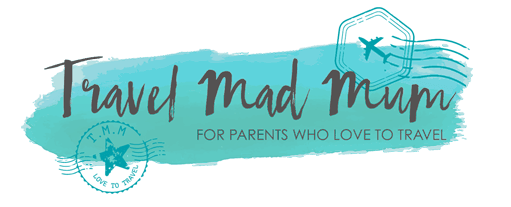
An Incredible Trip Campervanning In Switzerland, Itinerary & Tips
We took the most amazing trip campervanning in Switzerland with our four children recently. After the last couple of years and the crazy times we have all experienced, my biggest ‘travel craving’ was to trip around the Alps !
Switzerland has been at the very top of my bucket list, I visited many years ago but this time was quite different with four little ones in tow. The last time I visited I was on a backpackers budget staying in hostels.
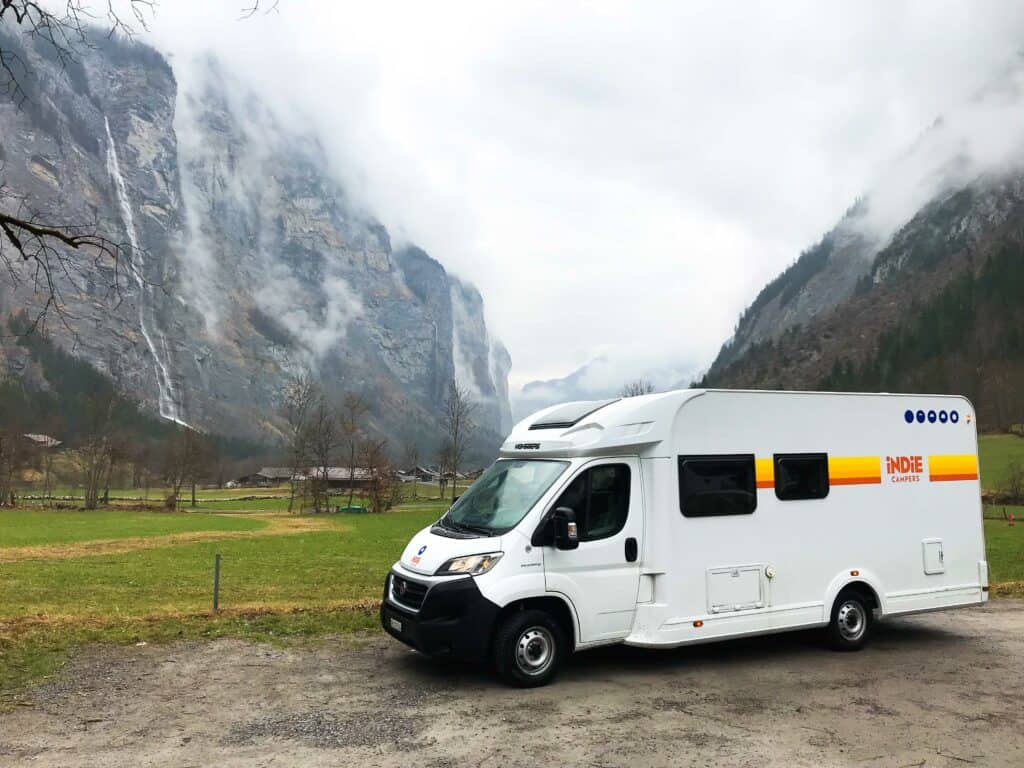
This time around, I wanted to make sure we could still get a lot out of Switzerland without breaking the bank. It is an expensive destination, however doing it in a camper van makes it a lot more affordable.
In my opinion travelling in a camper van is one of the easiest ways to explore with children. You can just role up to an activity or restaurant and leave ‘home’ when you are ready. ‘Home’ is always close by for any emergency nap, nappy explosion or meal time for little ones.
Yes, life is quite compact, however camper vans have such clever designs with plenty of storage solutions for clothing, food and everything else required.
The main thing is not to pack a massive suitcase and use soft bags instead so you can decant once you pick up the camper van.
If you follow us on social media, you will know we lived in an RV in the UK for a year before moving to Abu Dhabi !
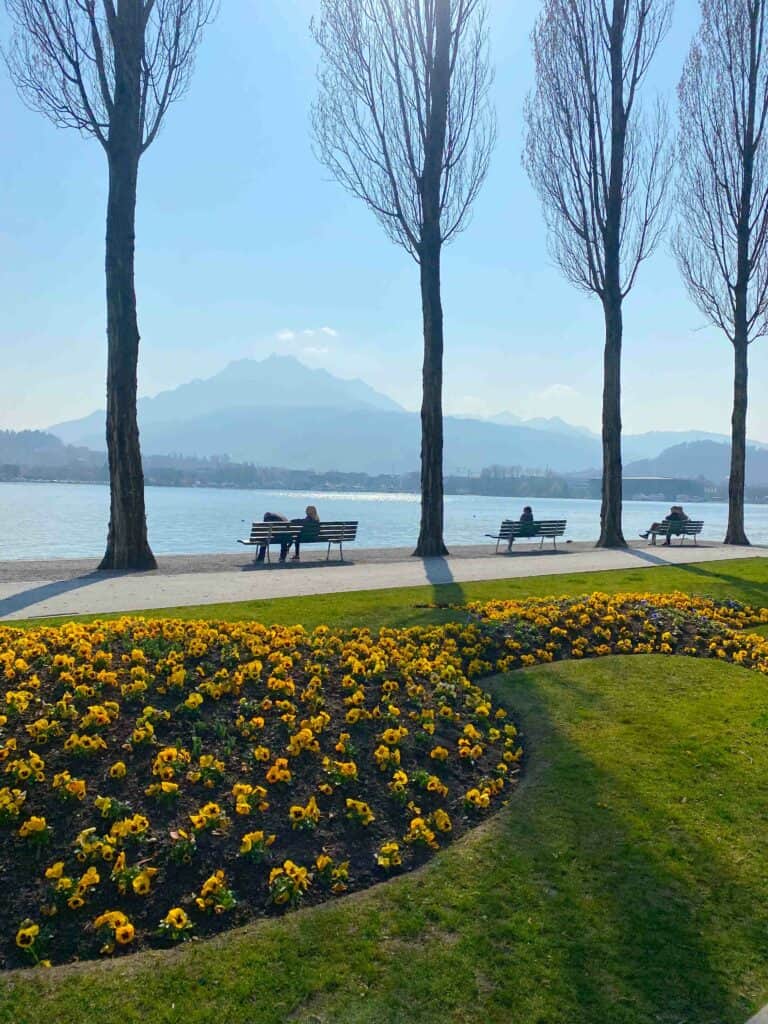
Having lived in the desert for almost a year, I had been wanting to visit somewhere cooler with lush mountainous landscapes , also waterfalls and lakes are my favourite! Travelling in a camper van is one of our greatest passions and Switzerland did not disappoint!
We flew into Zurich and spent two weeks tripping around. This blog covers where we rented the camper van, the route we took, campsite recommendations and of course great activities.
We also cover some top tips and considerations for travelling in a camper van around Switzerland.
Table Of Contents
- Where to rent campervan in Switzerland
- Indie Campervan Features & Pick Up Point
The Swiss Pass
- Lake Brienz
Lauterbrunnen
- Top Tips For Taking A Trip Campervanning In Switzerland
Where To Rent A Campervan In Switzerland
We booked our trip last minute, many campervan rentals seemed quite expensive. The most affordable option with enough space was Indie Campers, a 5 seat belt 6 bed option. We chose the Atlas camper van and it was fantastic for all of our needs.
For 2 full weeks it was approximately £900. There are extras such as bed linen, crockery, outdoor chairs & BBQs you can add to the booking. There is also an option of adding a small heater for the colder months.
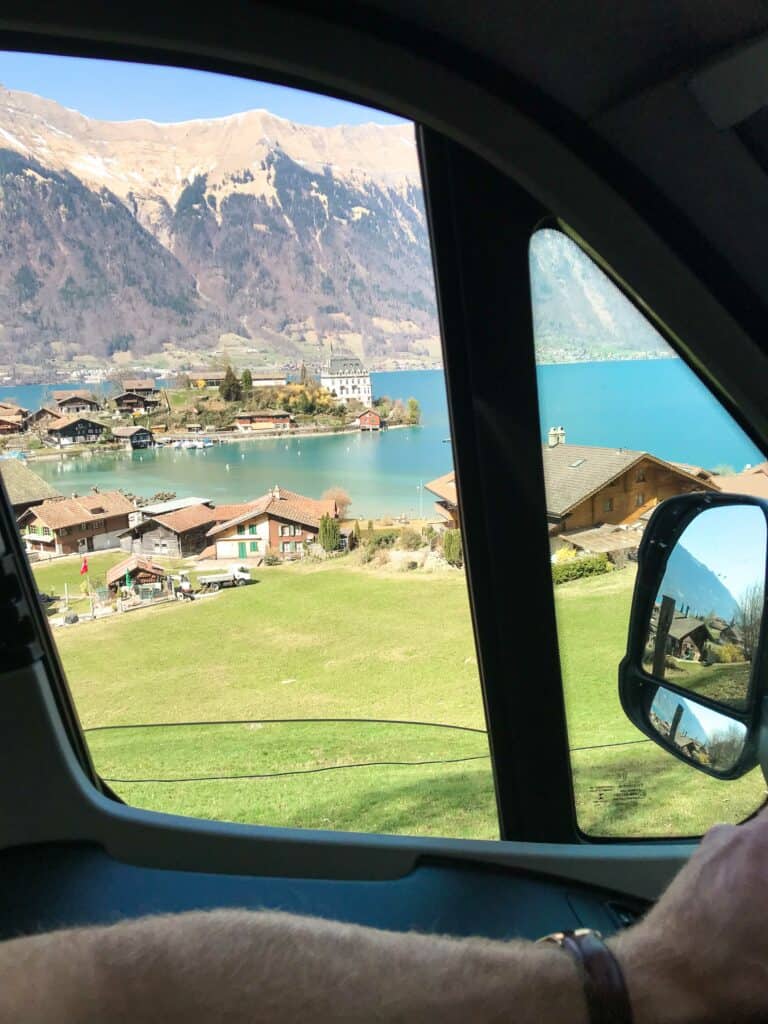
Truthfully the bedding you get from indie Campers is mediocre so it is something you might want to consider. This is my only criticism of the whole experience. We rented a car seat for our babies and they were super comfy.
Indie Camper Features
As mentioned although the camper van can sleep 6, it has 5 seatbelts. The back of the vehicle had a double bed and also has access to a massive carriage underneath for storage. Perfect for anything bulky like strollers, sports gear or heavy winter clothing.
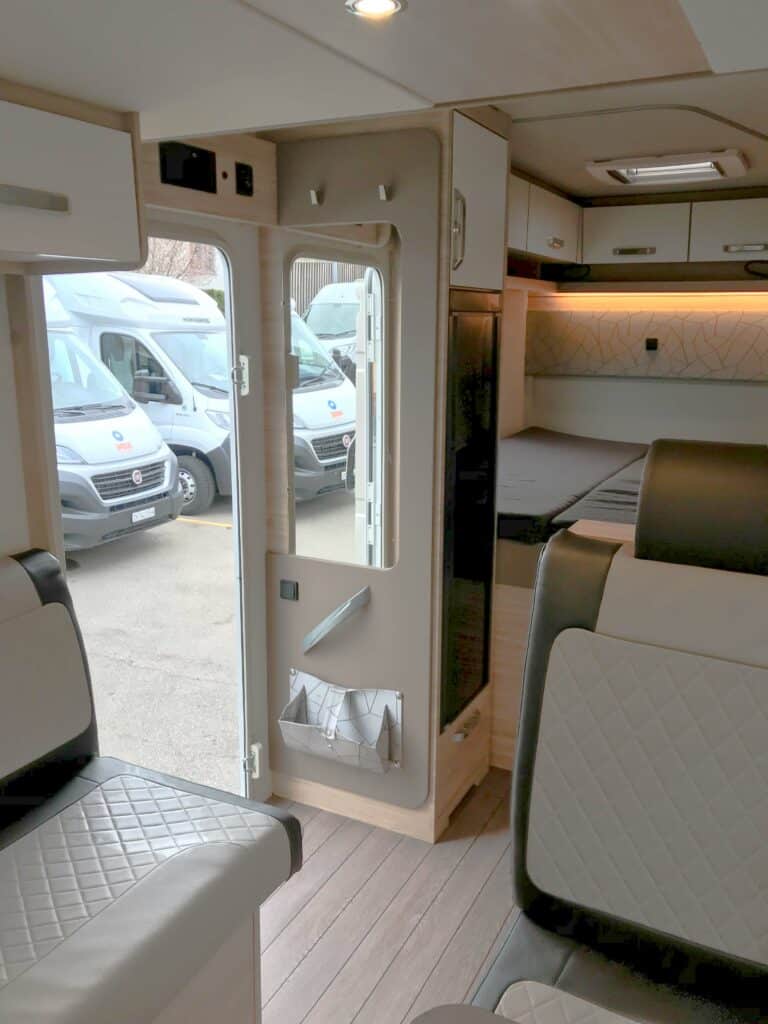
The bed did not look massively comfortable, however I was pleasantly surprised as we slept pretty well in it aside from the bedding. There was a little curtain that went around the bed and although it is not sound proof it was helpful to stop our lights from disturbing the kids.
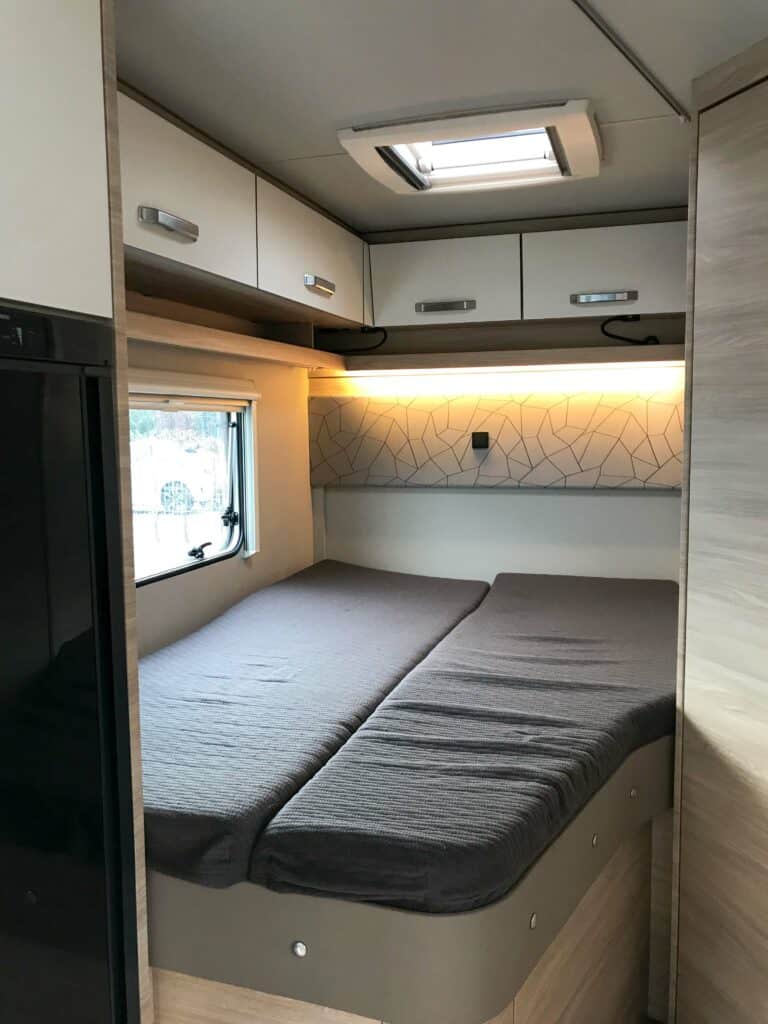
There was a shower, toilet and sink in the bathroom. We chose to shower at the campsites as there were 6 of us and although the water heater was pretty good, the volume of water needed for an entire family is a little unrealistic.
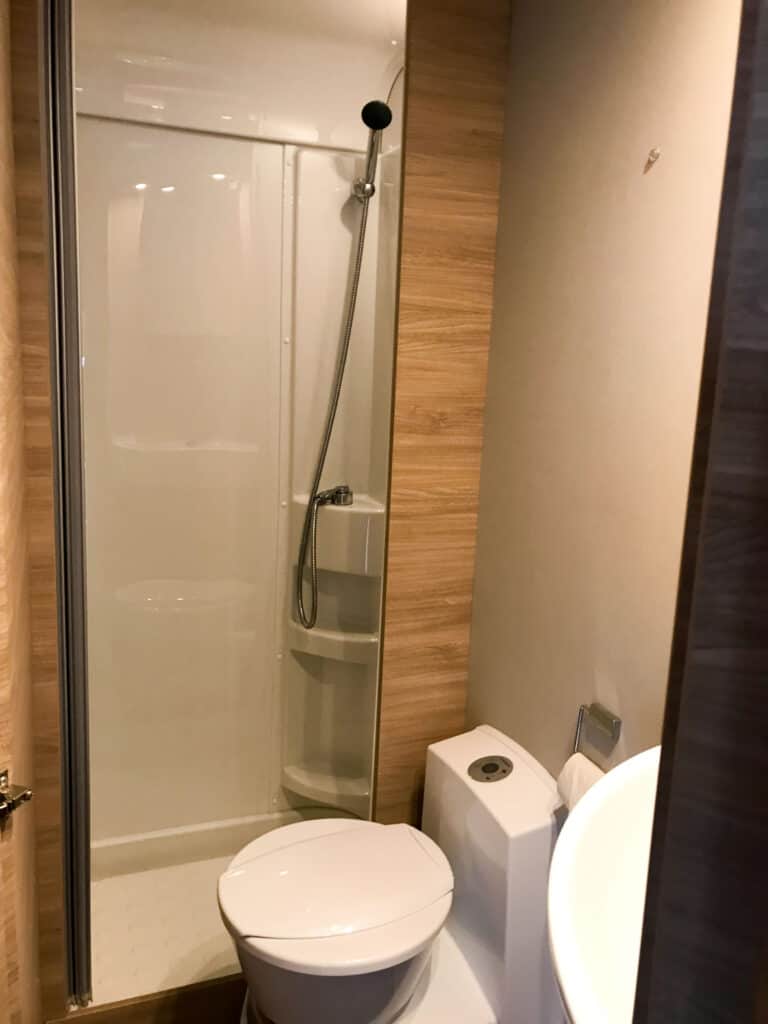
Generally all of the campsite bathrooms were pretty nice. We needed to change the water / toilet every 3 days or so. It is quite easy to do it, the staff give a full demonstration when picking up the campervan.
The kitchen had a 2 stove burner, a good sized fridge and a small freezer section. There was plenty of cupboards and drawers for storing the crockery and groceries and overall great storage for a campervanning in Switzerland trip.
Everything has a really good lock system for when it is time to drive so we did not have any accidents with things flying out of cupboards.
The second double bed was cleverly concealed above the living space. It was super easy to set up. All we had to do was pull it down in the evenings.
The mechanism was on hydraulics so it worked really well. All of the bedding could stay in place when it was raised so it is quite easy to jump straight into bed.
The living space had a little table with a fold out extension. The driver and passenger seat swivelled around to make comfortable ‘arm chairs’. It worked perfect for meals or a game of cards in the evening.
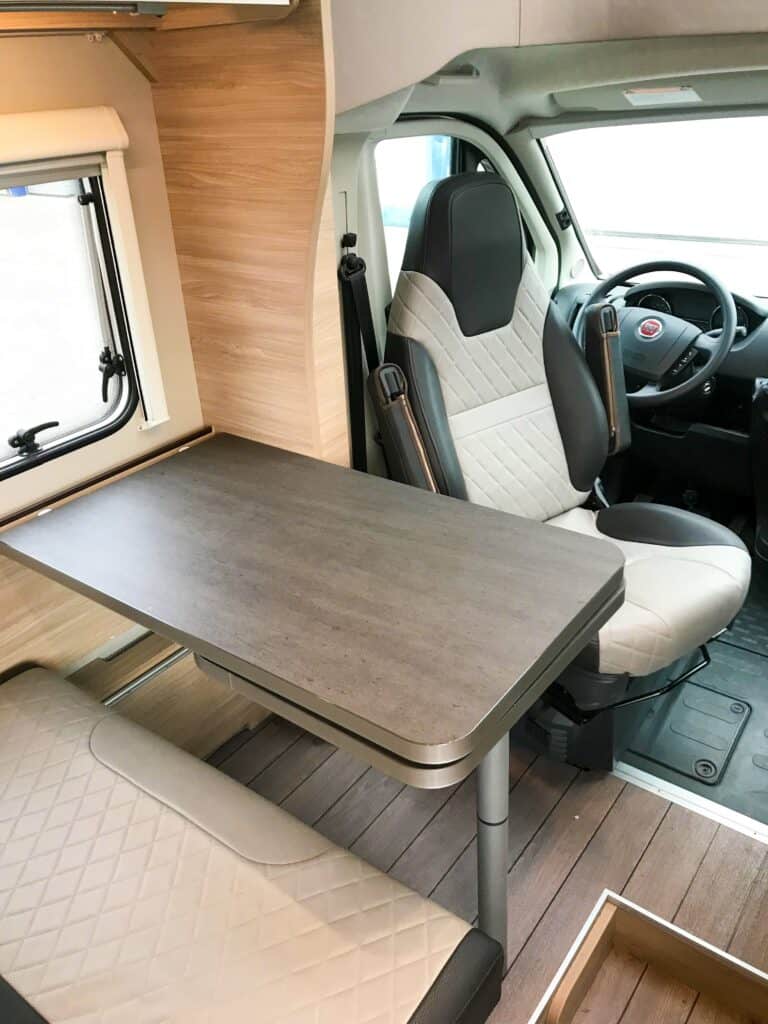
All of the blinds in the camper van were blackout so we really slept well. Above the driver seat was a panoramic window. It allowed us to see the tops of the mountains as we were driving through the alps. This was a lovely feature.
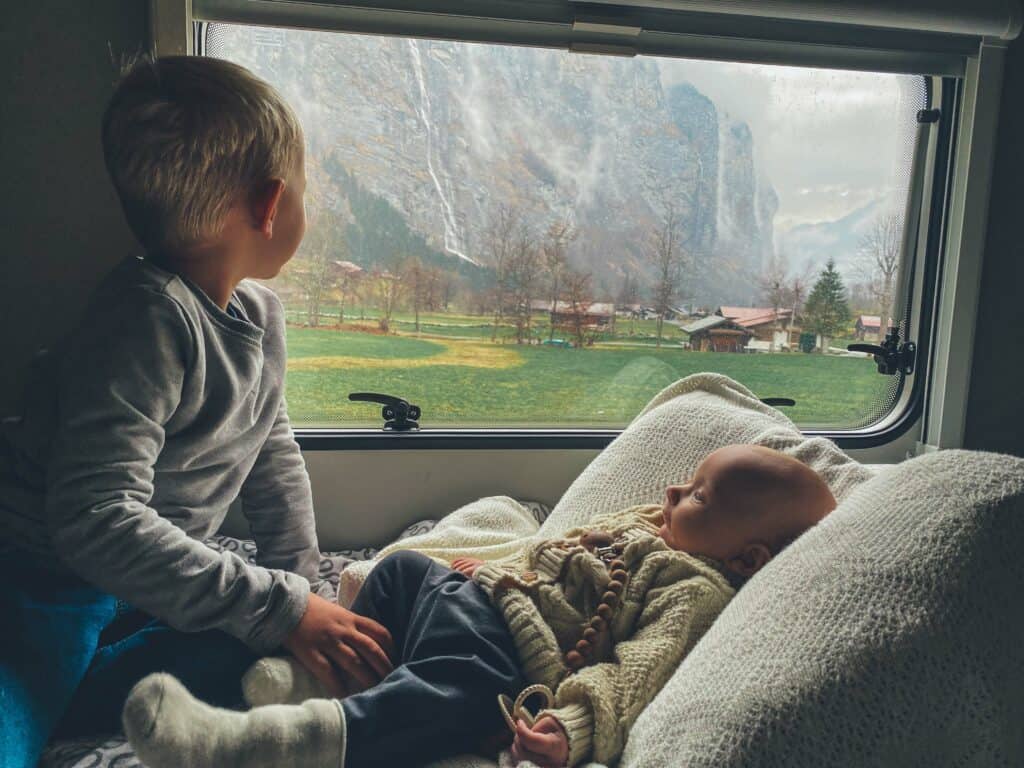
We often opened the blind on the panoramic window in the mornings. The kids would to stay in bed a little longer cozied up with a hot chocolate taking in the views.
As mentioned previously the under bed storage could also be accessed from outside the camper van. It was the perfect spot to store stroller. luggage, BBQ and outdoor seats.
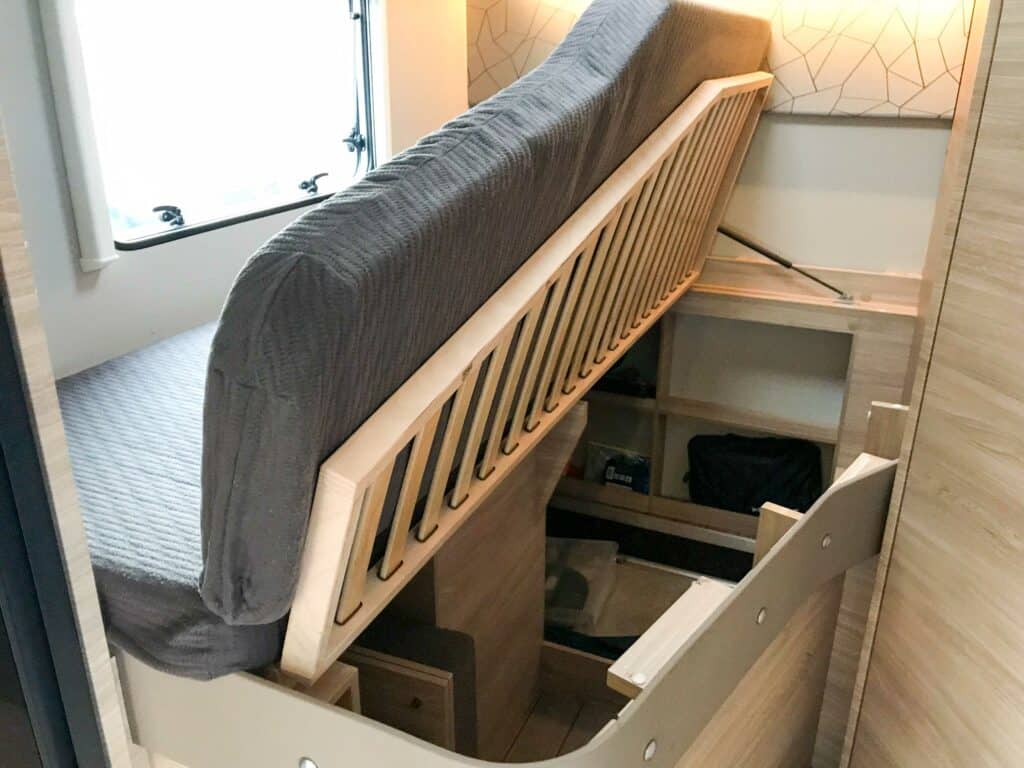
Indie Camper Pick Up Point – Campervanning In Switzerland
We flew into Zurich, Indie Campers was just a short distance on a train directly from the airport or a 20 minute cab ride.
You need to ensure to tell them the time you plan to pick up and drop off on your booking form. They spent quite a bit of time showing us all the features of the vehicle.
They were always available on WhatsApp throughout our trip when we had questions or weren’t sure about something. Overall I found the service pretty good while campervanning in Switzerland.
Table of Contents
Whilst we could easily get direct to many of the places we visited in the camper, there were some spots that required a gondola or train ride, particularly up some of the popular mountains.
These modes of transport are expensive in Switzerland but also needed to reach the beautiful spots. It is best to buy a Swiss Pass to ensure you do not break the bank when it comes to transport.
It covers boats, trains, gondolas and more. It is worth it to keep the costs of travelling around Switzerland down.
Check out Swiss Pass options here.
Zurich Campsite
We arrived into Zurich late afternoon so decided to stay on the outskirts of the city. We found an incredible site called Fischers Fritz right on the bank of lake Zurich with a fantastic restaurant.
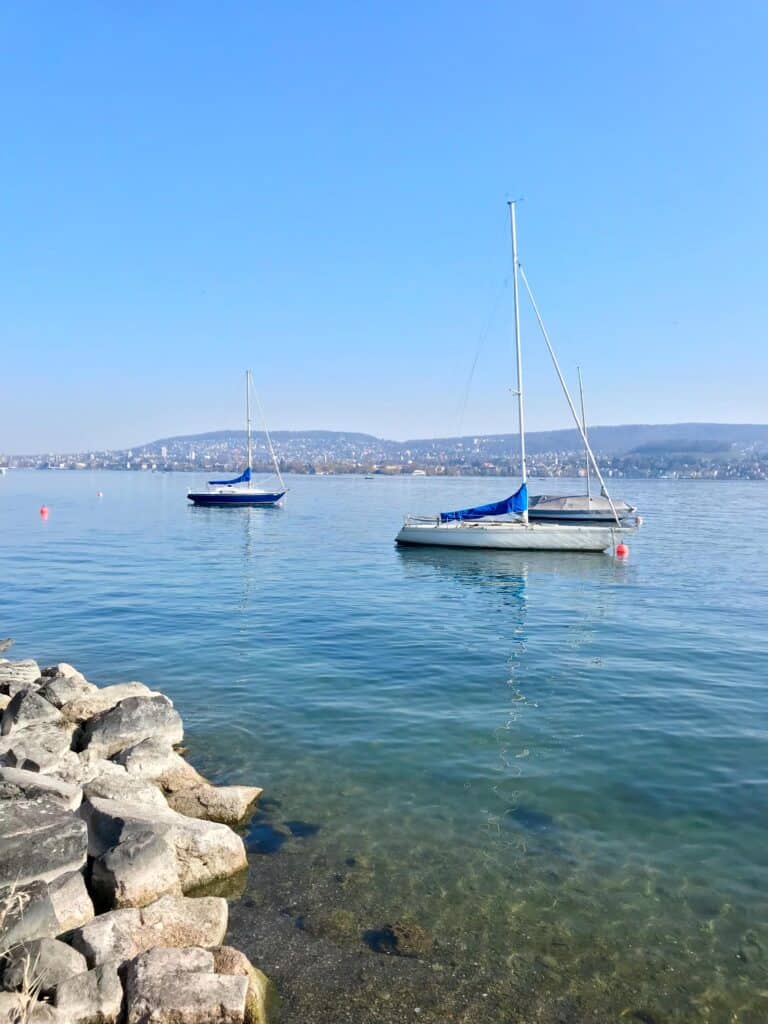
The view from the campsite was incredible, we could see snowcapped mountains on the horizon. The trampoline and playground was also a massive hit with our kids. For those more adventurous, there was also wake-boarding available onsite.
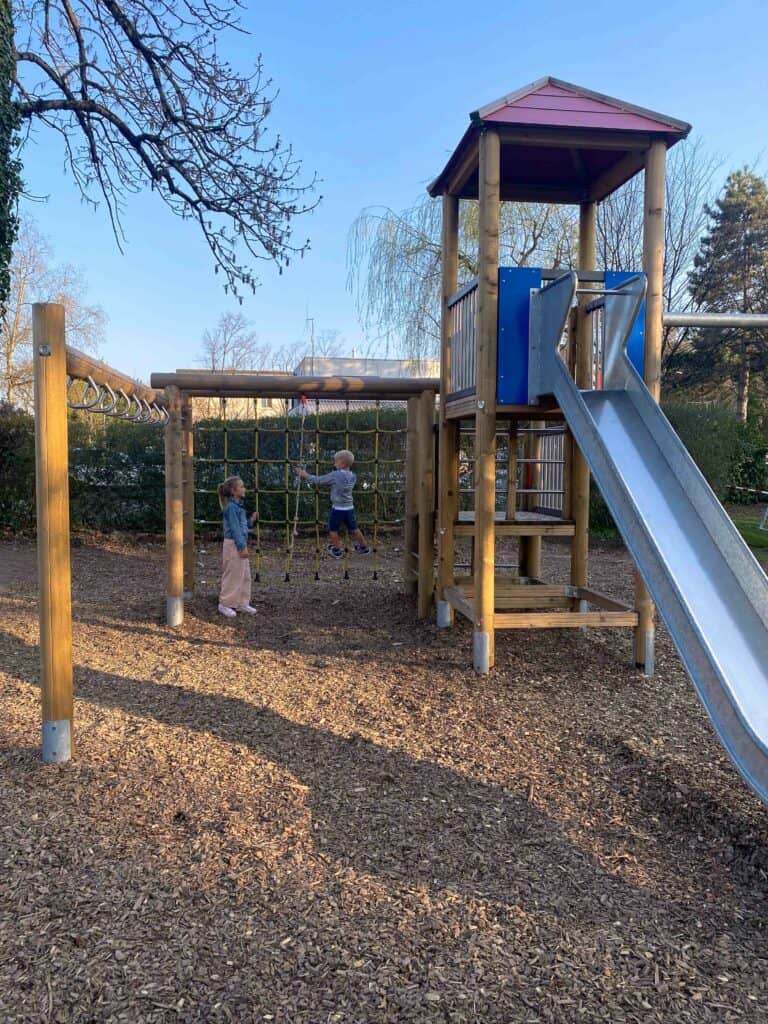
We absolutely loved the restaurant, it seemed a real hit with the locals. They had both indoor and outdoor seating, we just loved the massive outdoor fire pit against the stunning backdrop of the lake. It is a little expensive but the food was amazing.
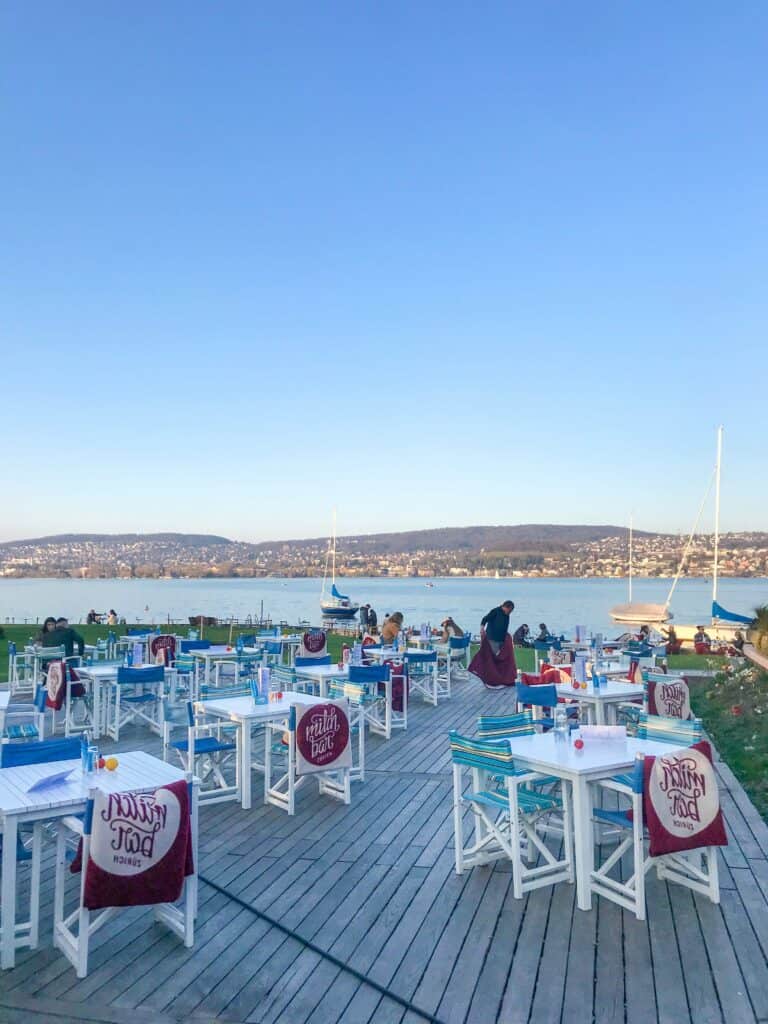
Fischer Fritz is the perfect base to explore the city. We took a bus to the centre from right outside the campsite, it only took 10 minutes.
We had a lovely day of activities in Zurich and an incredible lunch at Hitl, the longest serving vegetarian restaurant in the world. It is super popular, even with meat eaters. They have a daily lunch buffet, you pay by the plate.
After filling our tummies with hearty food, we wandered the medieval streets. Some great things to do with little ones include Wow Illusion Museum, take a boat trip on the lake or visit the Lindt Chocolate Museum.
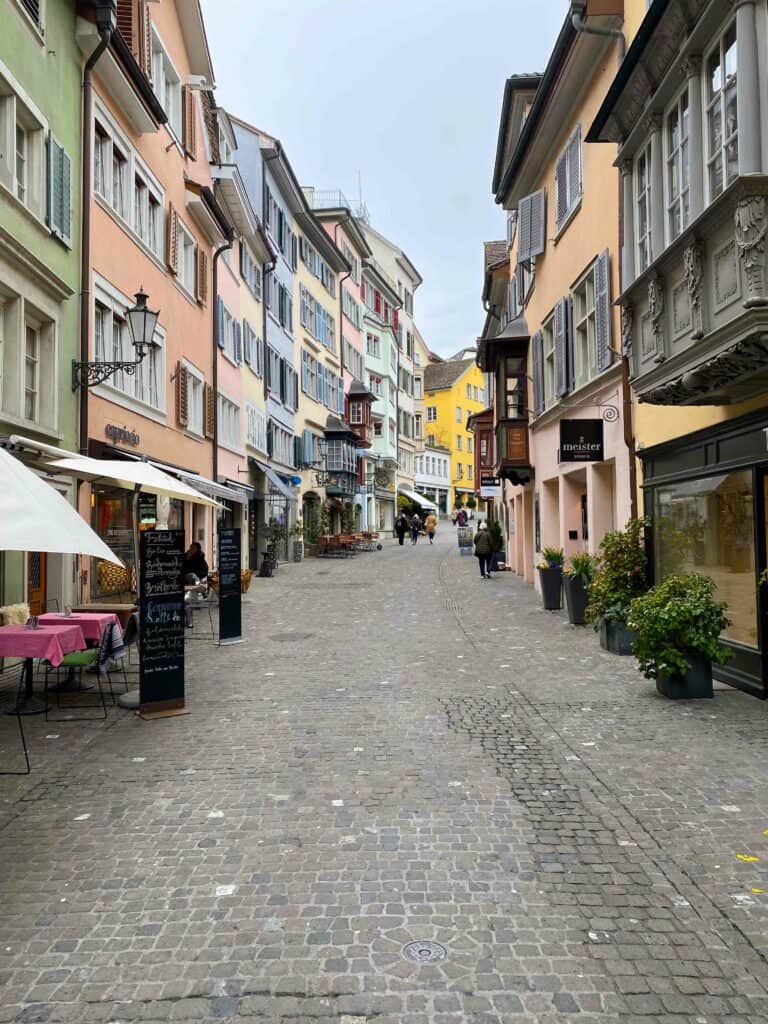
Some local families that follow us on Instagram also recommended, Zurich Zoo or taking a train to the top of Uetliberg.
We visited some attractions on the outskirts of Zurich, approximately a 30 – 40 minute drive from the campsite.
Technorama Science Museum is absolutely incredible for adults and children. Spanning across three floors with hundreds of experimental installations, it takes nearly an entire day to explore it comfortably.
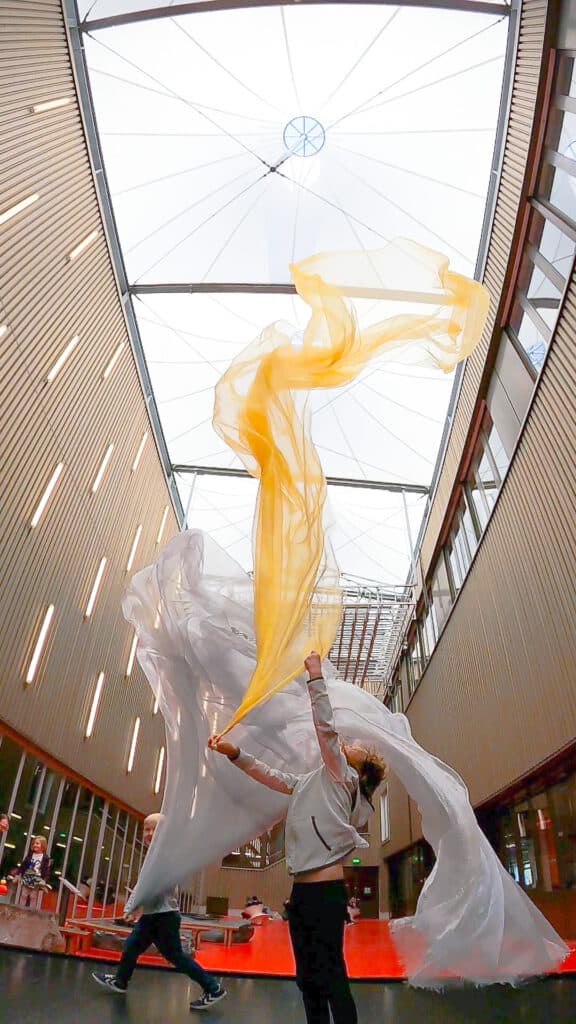
Another ‘must visit’ on the outskirts of Zurich is Rhine Falls which is one of the most powerful waterfalls in Europe . It is located quite close to the Swiss / German border so would be quite easy to nip across if you have time.
A lot of savvy travellers take advantage of the nearby countries, nipping in for grocery stock up as it is much more affordable.
Rhine Falls has a stunning walkway weaving down the side of the cliff edge. Along the way, the vantage points vary from an elevated 180 view of the river and falls, to getting wet from the waterfall spray at the base.
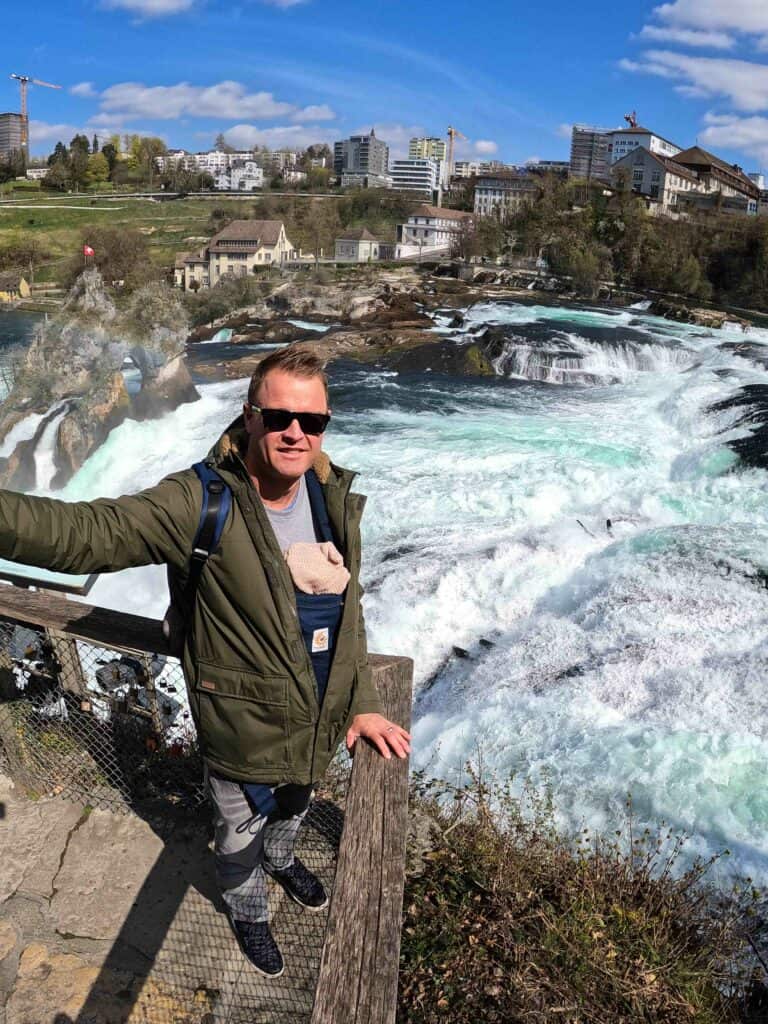
Everything is perfect about Rhine Falls , from the colour of the water to the watch tower quite literally in the middle of the fall (which makes a stunning photo).
You can take a boat tour from the other side of the river. It’s just a short 15-20 minute trip across the river which takes you as close as possible to the waterfall and back again.
Be prepared to get splashed! There are longer options for a boat trip in the area which progresses further down the river.
Book a boat trip on Rhine Falls here .
Lucerne is a stunning town just 45 minutes drive from Zurich. We loved the fact moving around Switzerland does not require hours on the road.
This beautiful medieval town is based on the crystal clear waters of Lake Lucerne and dwarfed by the sight of nearby Mount Pilatus and Rig in the Swiss Alps.
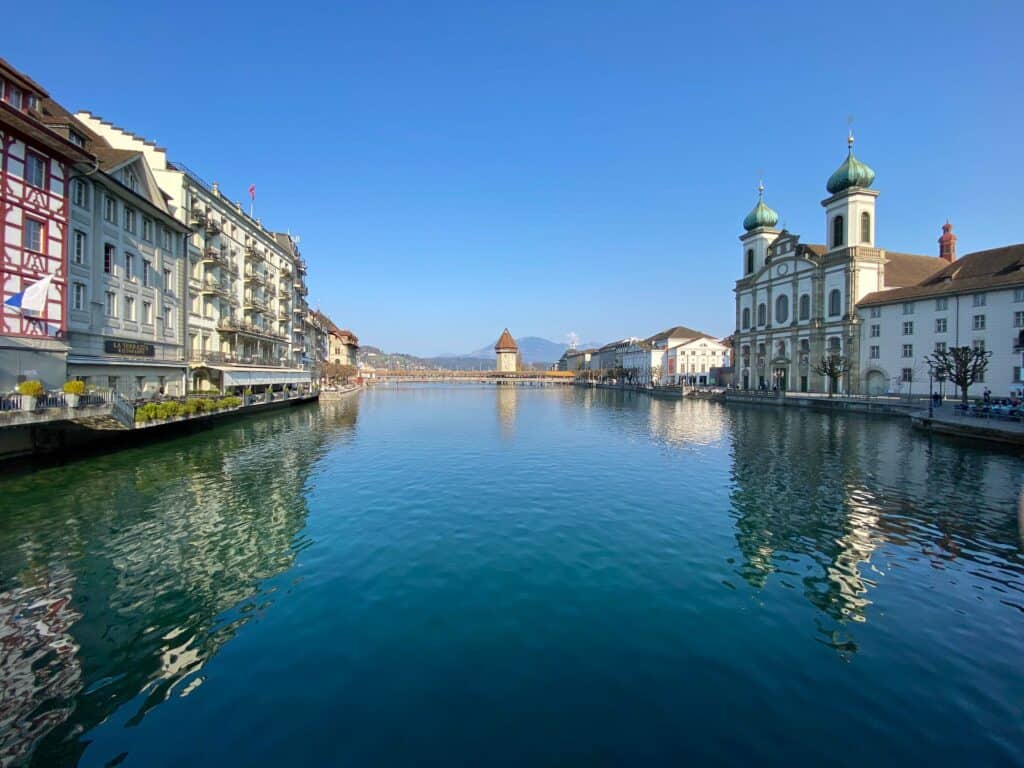
The town oozes history from the 14th Century Wooden Bridge to the quaint chocolate box back streets. It is the perfect place to wander.
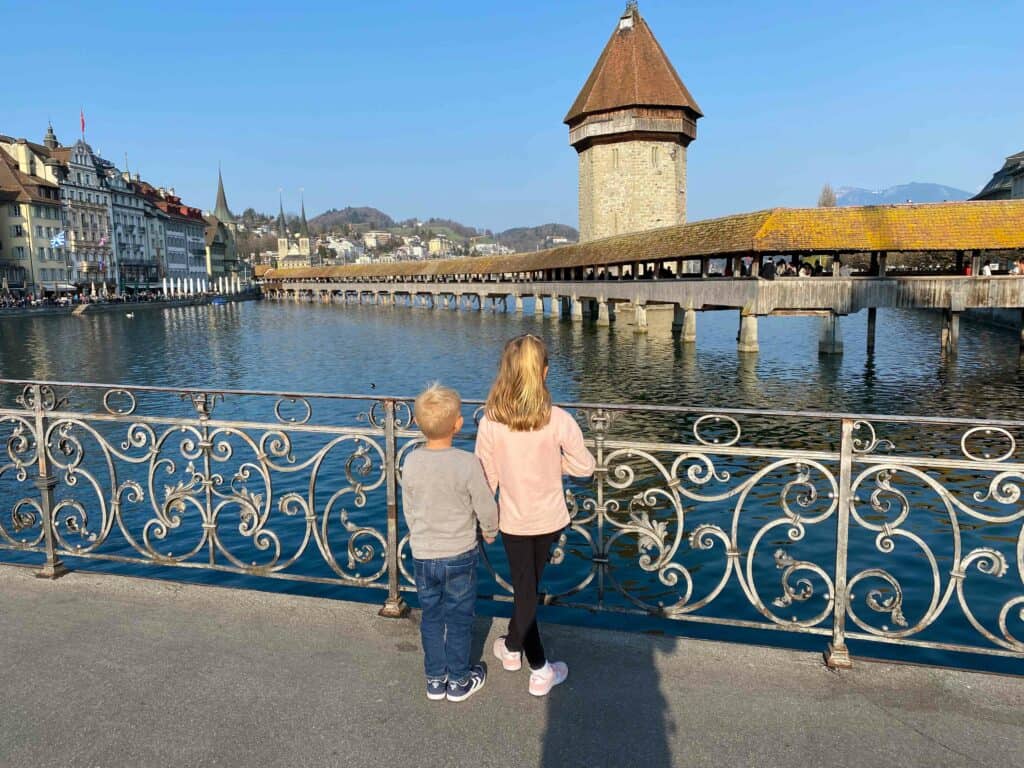
There are some beautiful restaurants along the river banks just past the wooden bridge, perfect for lunch! The vibes are cozy nestled behind arches, big blankets to keep warm and candles to set the mood. Red wine is a necessity!
Mount Pilatus
You can not visit Lucerne without going to the top of Mount Pilatus . It is a little on the expensive side to ride to the top but worth every penny. The views over the Alps are just incredible.
The gondola terminal is just 10 minutes out of town on a bus which comes quite regularly. Starting off with a small family sized gondola, the ride passes through different stops on the way up the mountain .
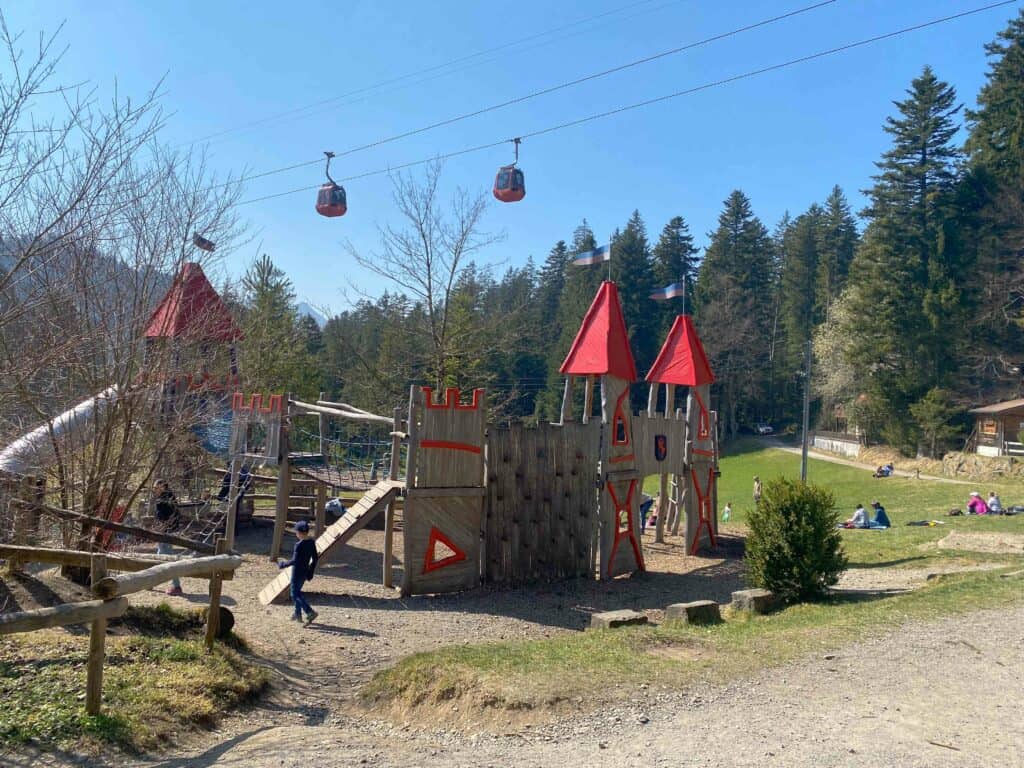
There is an incredible Alpine Playground at the first stop. Picture the backdrop of green fields with Mount Pilatus otherwise filling the entire view. There were a lot of locals cooking on mini BBQs as it was a Saturday afternoon.
Get tickets to Mount Pilatus here!
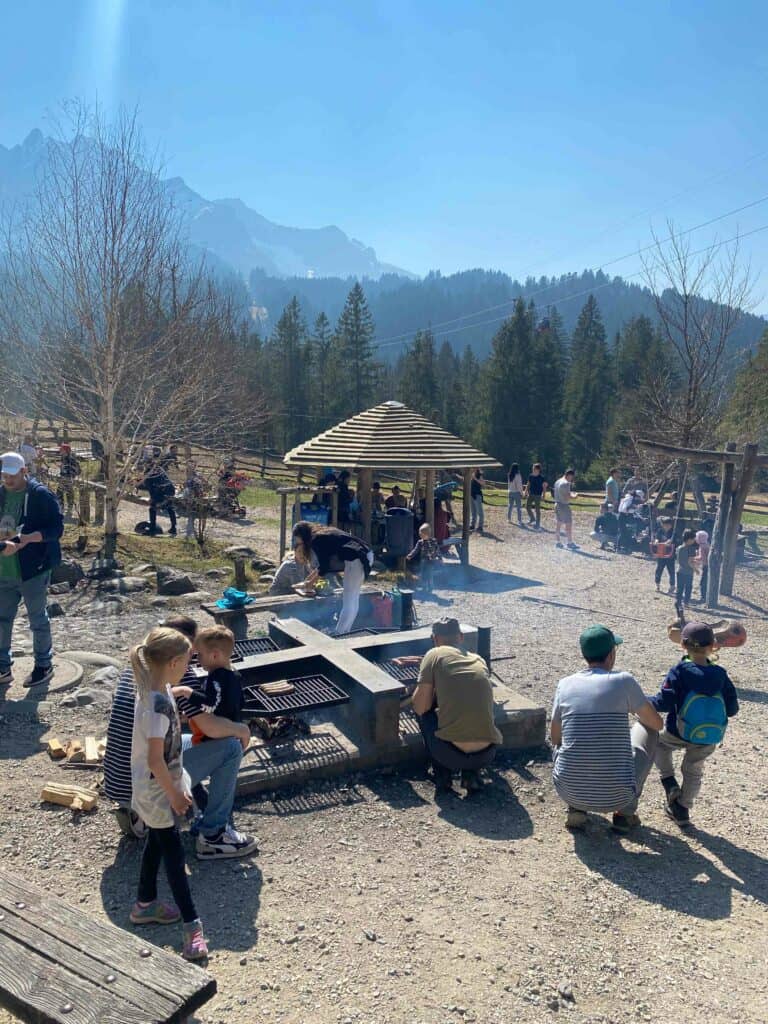
The smell of the bratwurst sausages was filling the air whilst the kids were loving the slides and zip-line. A lot of people hike to this point so it is possible to reach it without the expensive gondola ride.
The next stop along the gondola is an adventure area with a tree-top obstacle course. It is only open at certain points of the year, so if it’s something you want to do, make sure to check ahead.
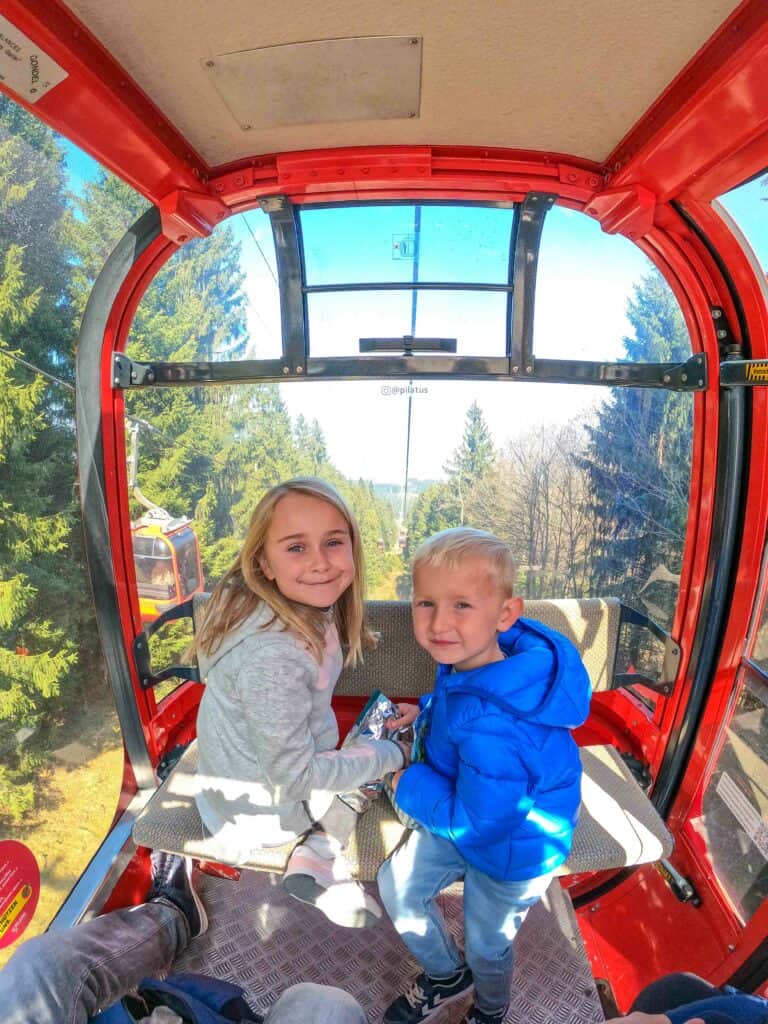
The final stage of the trip to the summit is a much larger gondola which holds tens of people. The views on the last leg are another level of beautfiul. I particularly remember a chapel perched on top a sheer cliff face.
At the top of Mount Pilatus there is plenty of indoor space with a bar / cafe. There was also a digital ‘dragon’ experience which the kids loved.
Appropriately named the ‘dragon walk’ there is a path around the edge through caves with incredible openings.
The arched ‘window’ framed the view impeccably and is something that will stay with me forever. It has to be one of the most stunning outlooks in Switzerland.
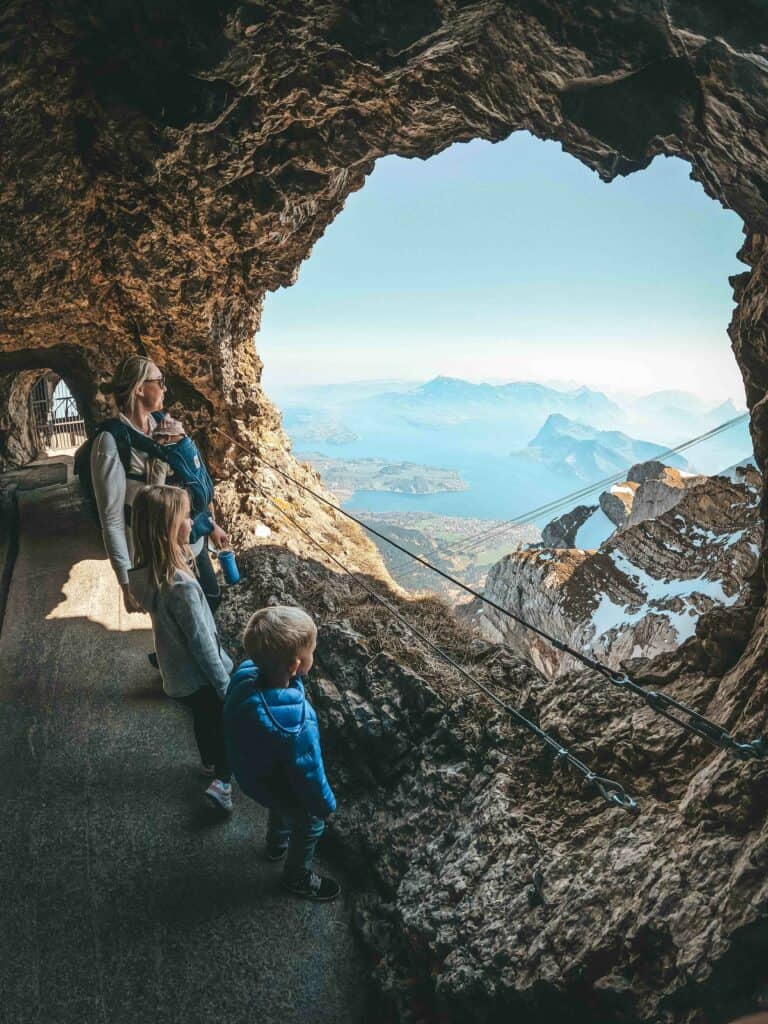
The very last leg to the top is a 200 step staircase winding around the pinnacle. Keep in mind the altitude when exerting yourself on the stairs.
I reminded my kids to take their time. It gets a little colder and windier with no shelter whatsoever but it is absolutely worth it for the pinnacle view of the Alps.
Peak on peak is the view as far as the eye can see. It truly was a magnificent experience.
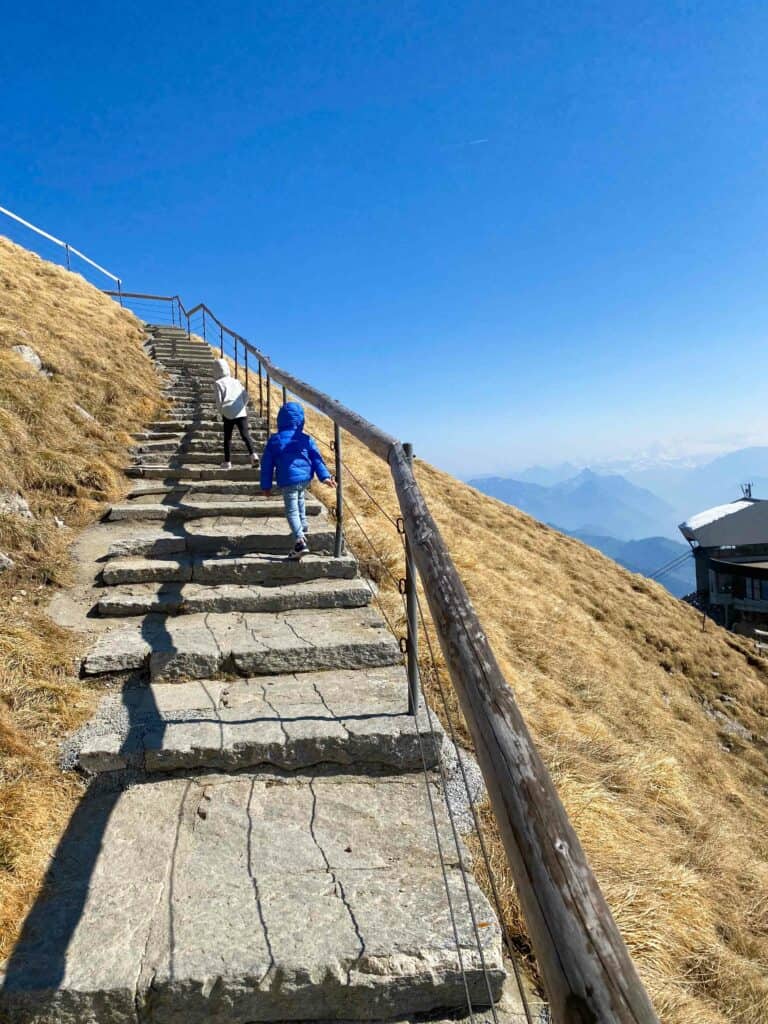
At the foot of the steps is a large patio where paragliders begin their flight . There is lots of seating and sometimes live music with traditional Swiss instruments.
It was such a super relaxing experience, true to Switzerland, a BBQ with bratwurst was filling the air with smells and everyone was chilling with a drink and a blanket on deck chairs.
If the cold is too much to bare, particularly in the winter and spring months, there is also indoor seating space with a restaurant.
Book a paraglide here .
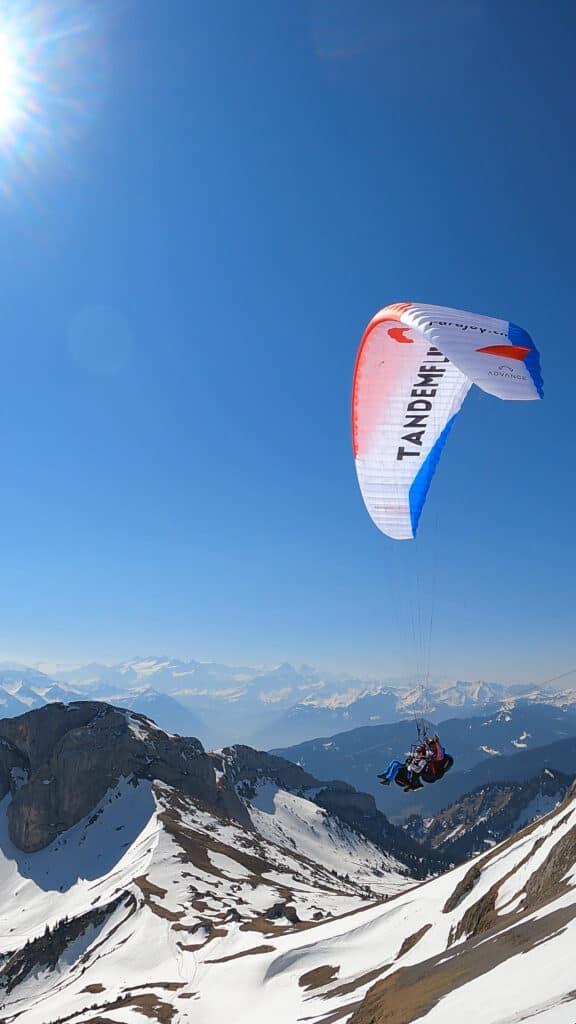
The main campsite in Lucerne is right next door to Verkerhaus , one centre with several museums under the same roof! It was perfect for a rainy day.
Within Verkerhaus is the Swiss Transport Museum which is loved by locals and tourists alike. With ride on mini trams, go karts and a tonne of simulation and digital media experiences, our kids really loved the day!
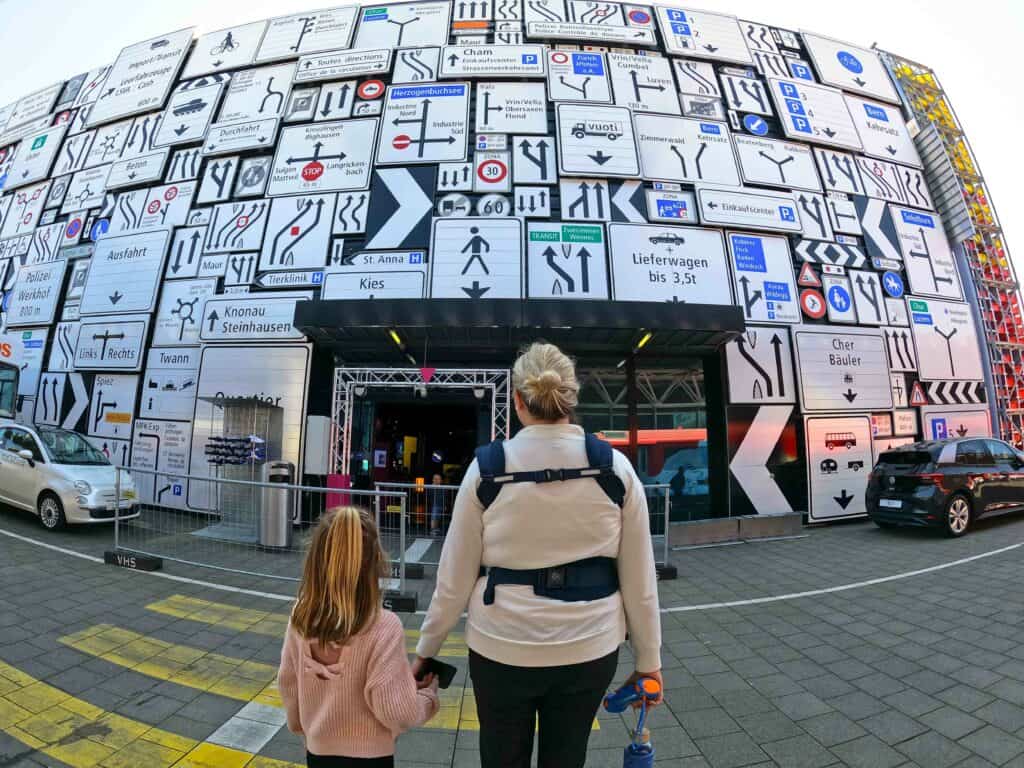
We actually returned to Lucerne towards the end of our trip and spent a second day checking out the 3D Filmtheatre Planetarium and Swiss Chocolate Factory within Verkerhaus .
It is worth booking ahead for the Planetarium and 3D Filmtheatre if you want to go to a kid friendly showing, especially on weekends as it was booked out. Both last about 30 minutes so is perfect for little ones.
Our kids watched a BBC under water documentary in 3D and absolutely loved it. Other showings include Dinosaurs of Antartica and the Serengeti!
As for the Planetarium, the morning kids show was a beautiful trip around the planets with their resident mascot on the dome shaped ceiling.
If you arrive early, you might get one of the super comfy beanbags in the centre of the room which is a lovely full 360 degree view of the show!
Check out tickets to all the Verkerhaus museums here.
Lake Lucerne Boat Trip
Cruising on the crystal clear waters of Lake Lucerne is an absolute necessity when visiting the area. The lake is nestled between Rigi Mountain and Mount Pilatus, it really is a postcard perfect scene!
There are many types of boat trips, from a yacht cruise to something more adventurous like kayaking there is something for everyone. Sunset is a beautiful time to take a trip on the water, especially on a clear day.
The day we cruised the sky was pink and the water was super still. The mountain was reflecting on the water perfectly as swans glided past!
The campsite is around a 15 to 20 minute walk from the centre of town. It’s possible to walk predominantly along the lake the entire way which is definitely worth it!
Check out Lake Lucerne boat trip here.
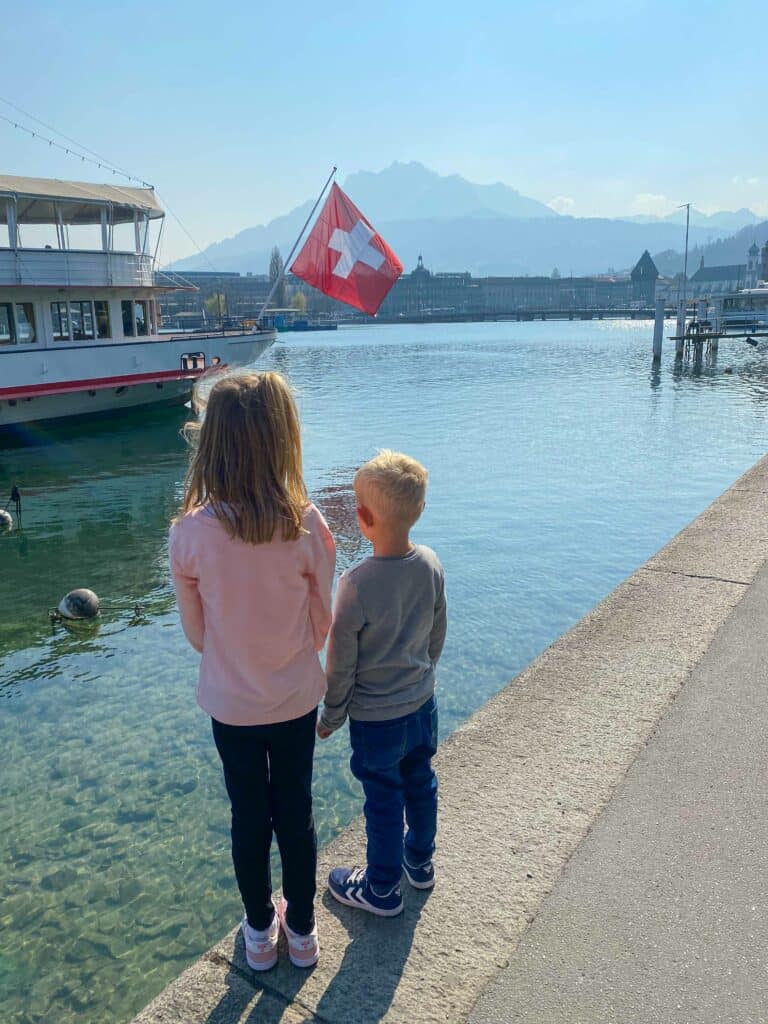
It is worth noting different times of the year have completely different experiences. We travelled in April which is an awkward time weather wise as the snow is starting to melt, however summer hasn’t fully arrived.
It also meant some of the train ride experiences only available in summer weren’t running.
There are pros and cons to visiting at the beginning of spring. For example we got last minute availability in some very popular campsites.
Lucerne Campsite
We stayed at Lido Lucern Campsite just a short distance from the town. It was just one street back from the lake and in such a perfect location for exploring everything in the area.
All guests get free travel on local transport around Lucerne which was super handy as a bus stopped right outside the campsite.
The pass also provided discounts to local attractions including the Mount Pilatus Gondola. Of course if you have a Swiss Pass already, you at least have the benefit of discounts on attractions.
The campsite has a playground for little ones, a cozy restaurant and all the usual laundry and showering facilities which are always helpful with kids. There were views from around the campsite of Mount Pilatus which were lovely in the evening sunlight.
We only intended to stay for a couple of nights, however we returned towards the end of the trip as we loved it so much! Lido Lucerne Campsite is one of the few open in low season when campervanning in Switzerland.
Iseltwald Wharf, Lake Brienz
As we left Lucerne our first stop was Iseltwald Wharf on Lake Brienz ! I have previously travelled to Banff, Canada and had never seen lakes that come anywhere near the infamous Moraine Lake but Lake Brienz was pretty much the same colour and just as beautiful.
There is a tiny lazy village with typical Alpine buildings. It was a dream seeing our kids play on the swings in front of the beautiful houses with the backdrop of the blue lake.
We had lunch in the campervan with the door opening onto the view. We spent a long time just sitting and watching the world go by!
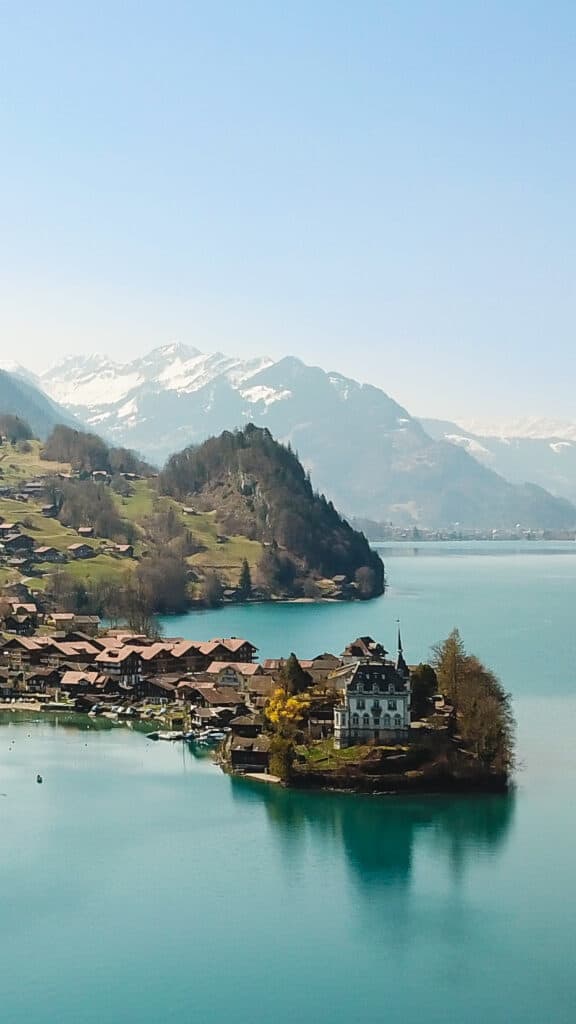
The wharf itself is a beautiful spot for a photo. The water is from a glacier, hence it being a blue colour from the minerals. This perfect reflection is a photographers dream!
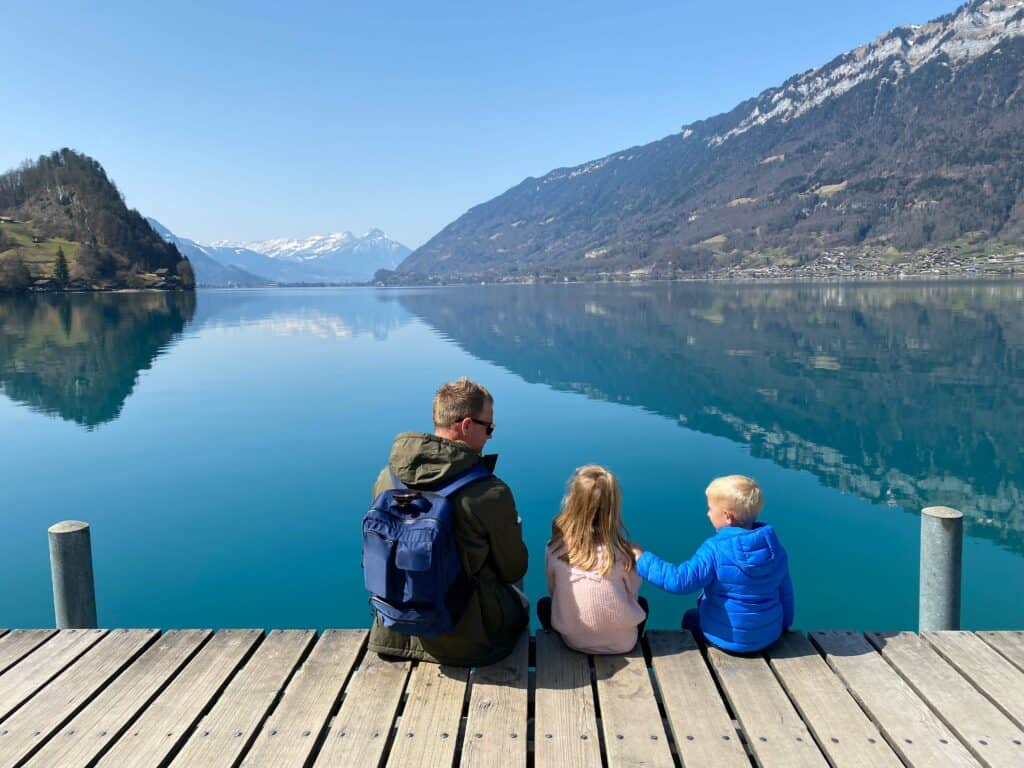
There are a couple of restaurants in the area to stop and have lunch or dinner. Equally there is a campsite right on the lake with stunning views and glamping options.
We didn’t stay at Lake Brienz as it was a last minute find so we moved onto Lauterbrunnen!
Check out boat trip on Lake Brienz here.
The drive to Lauterbrunnen is super windy and not for those who get car sickness. Remember to bring wristbands for the journey. That being said, it is worth ever single minute.
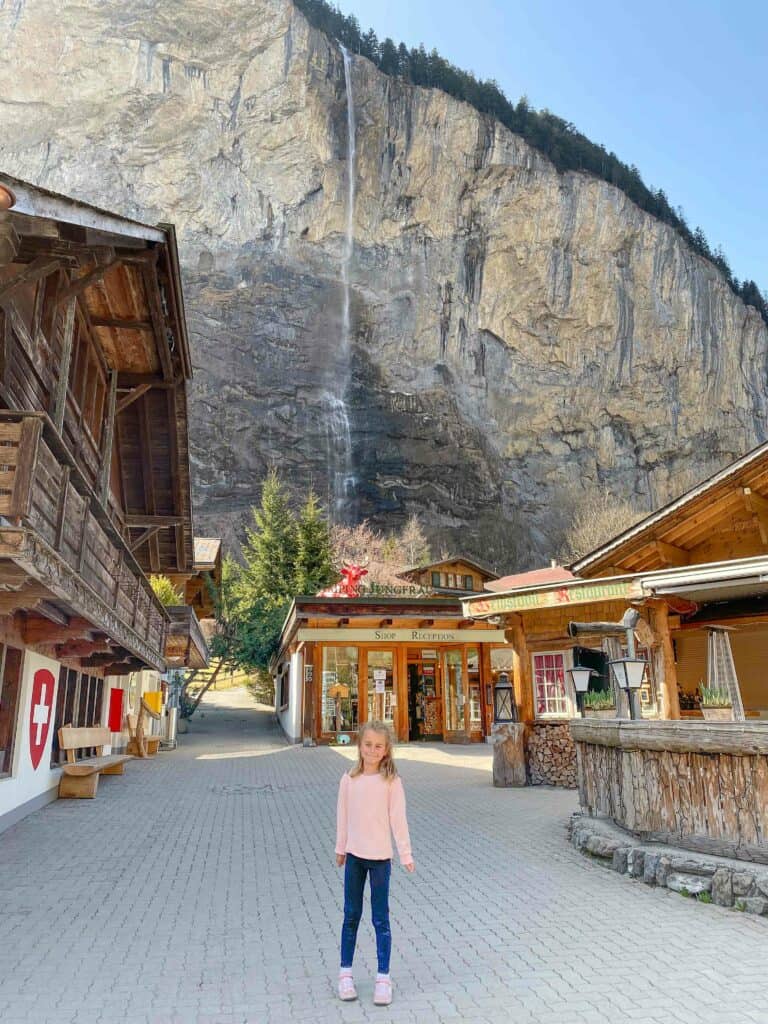
Nicknamed the Valley of 72 Waterfalls, you guessed it, you are likely to see some stunning scenes! The valley has some steep rock faces and towering mountains, not to mention gushing glacier rivers and picturesque trails.
Again it is worth noting Lauterbrunnen is completely different in each season. We were lucky to have two sunny days and two snowy days. We were not prepared for the latter!
Despite our lack of preparation we still got out and explored all of the local popular spots for hiking. There are a tonne of different trails some easier than others.
The village is served by gondolas and trains which weave around mountains and pop out at stunning elevated towns such as Wengen and Grindelwald.
We particularly loved walking around Wengen, a ski town with a buzz. There are plenty of nice restaurants to choose from, many with outdoor seating serving up some true Swiss dishes.
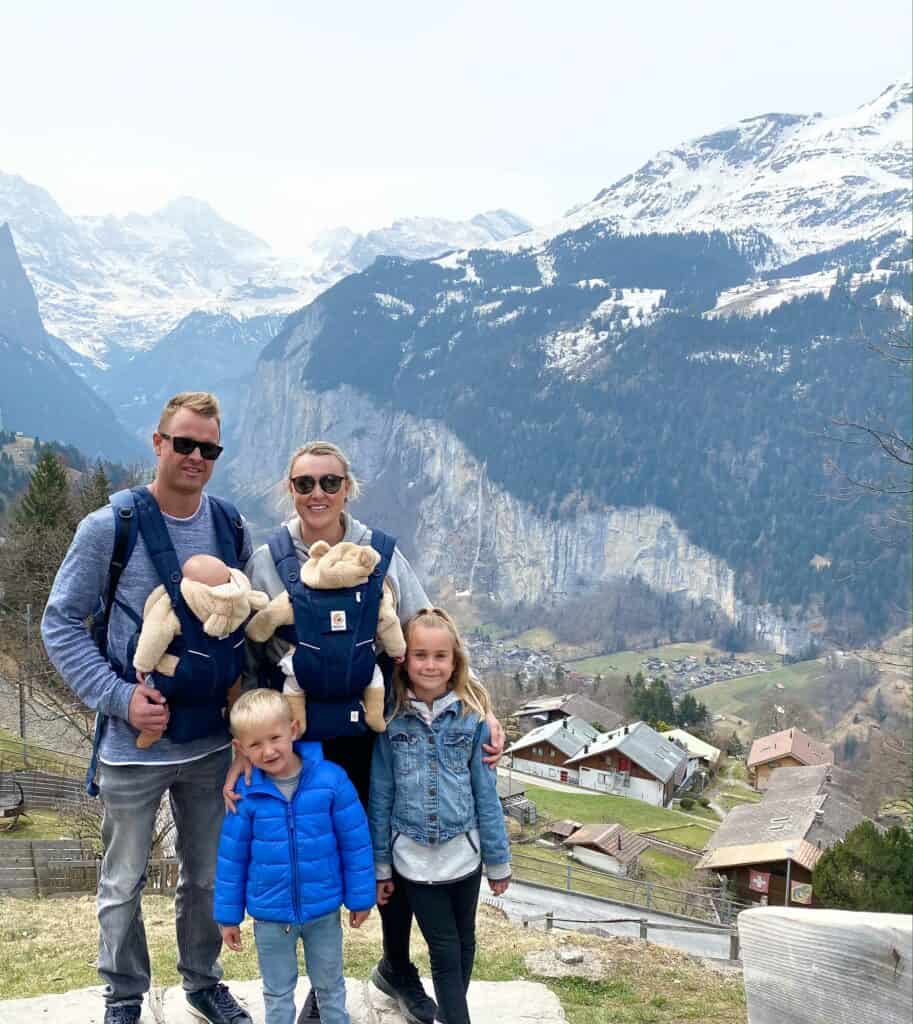
Pasta and More serve up some delicious Rostis with veggie options. Hubby had a cheese fondue, the beer was pretty good too.
If you visit make sure to walk around the chapel, the views of the valley from above are some of the best in the whole area.
Jungfrau is one of the highest peaks in the Alps, not to mention it is home to the highest train ride in Europe. It is possible to ride on the train all the way to the top from Lauterbrunnen train station.
Tickets are expensive but worth it. The top of Jungfrau is a UNESCO World Heritage Site.
There is plenty to do at the top from an observatory deck you can view the Aletsch Glacier on a clear day.
You can also visit the Ice Palace, where you can walk through glacier tunnels and see all kind of ice sculptures. It is a definite ‘must see’ if you visit the top of Jungfrau.
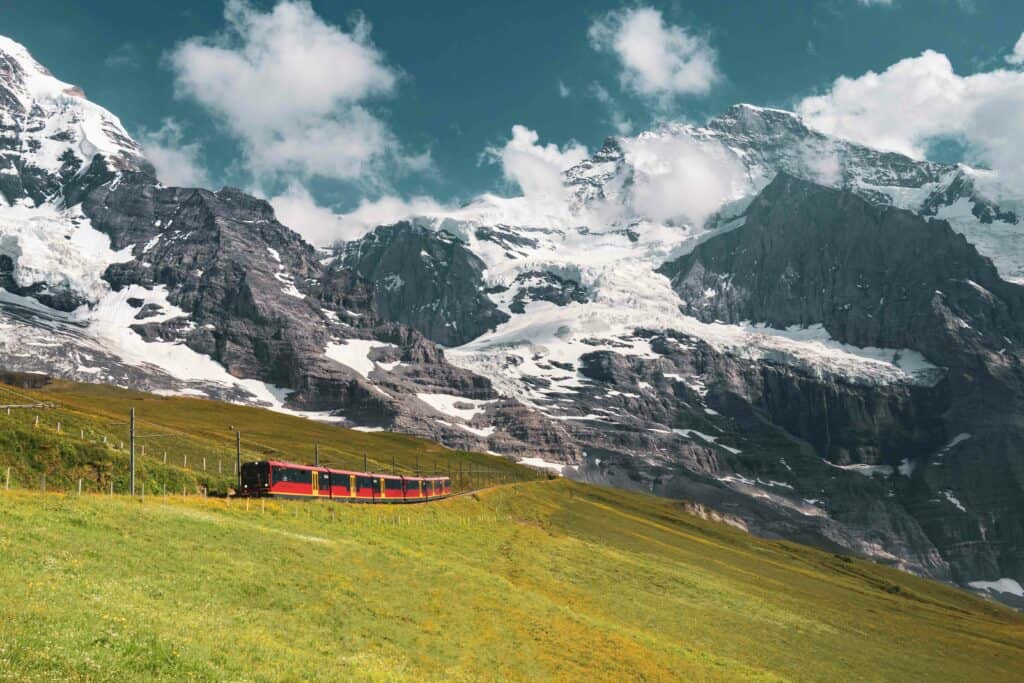
The Alpine Sensation is another hit, a multimedia experience along a corridor with a giant snow globe, the kids love it!
Other experiences include the Jungfrau 360 film experience and the fun park for some outdoor adventures such a sledding.
No matter what you choose to do, it is guaranteed there is a tonne of educational experiences for all visitors!
Check out tickets to Jungfrau here .
Lauterbrunnen Campsite
We stayed at the most spectacular campsite named Camping Jungfrau ! This place was everything and my favourite campsite I have ever stayed in! Perched on the river edge with views of the gushing waterfalls, it was all the nature experiences rolled into one! We loved sitting around the fire pit at night with a hot chocolate. We could hear the river and the waterfall was illuminated with lights.
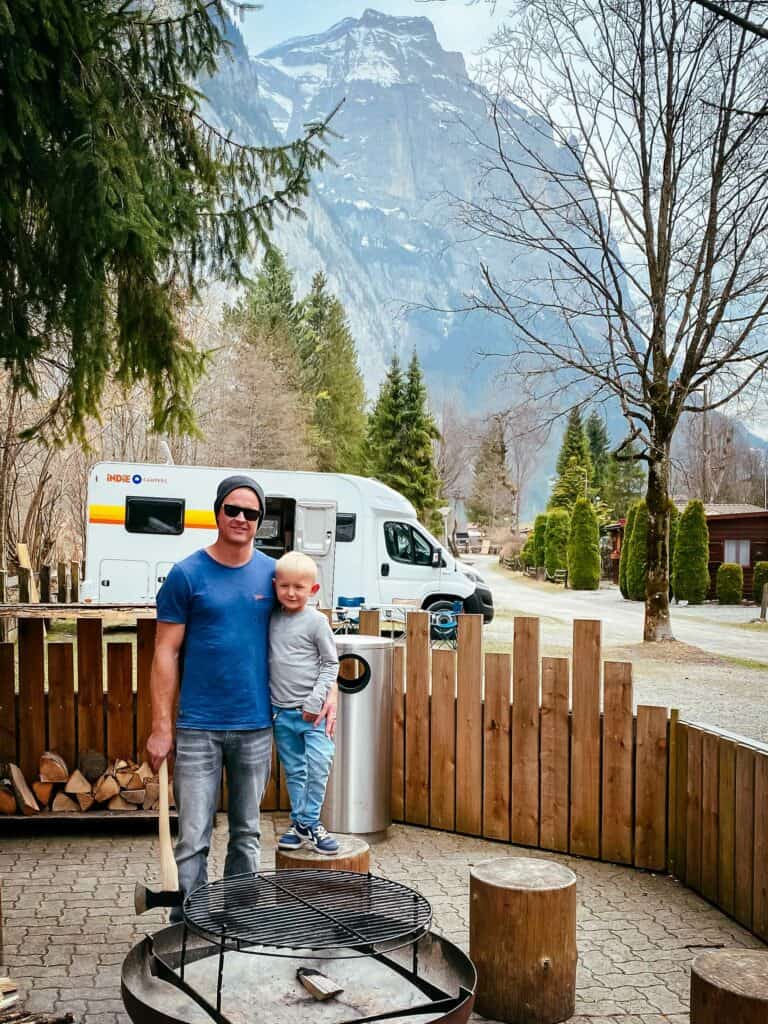
The campsite also had a shop where we could pick up basic groceries, fresh warm bread and pastries each morning.
There are lots of other accommodation options on site including log cabins of various sizes. They are such perfect little dwellings with stunning views, not to mention comfortable and cozy.
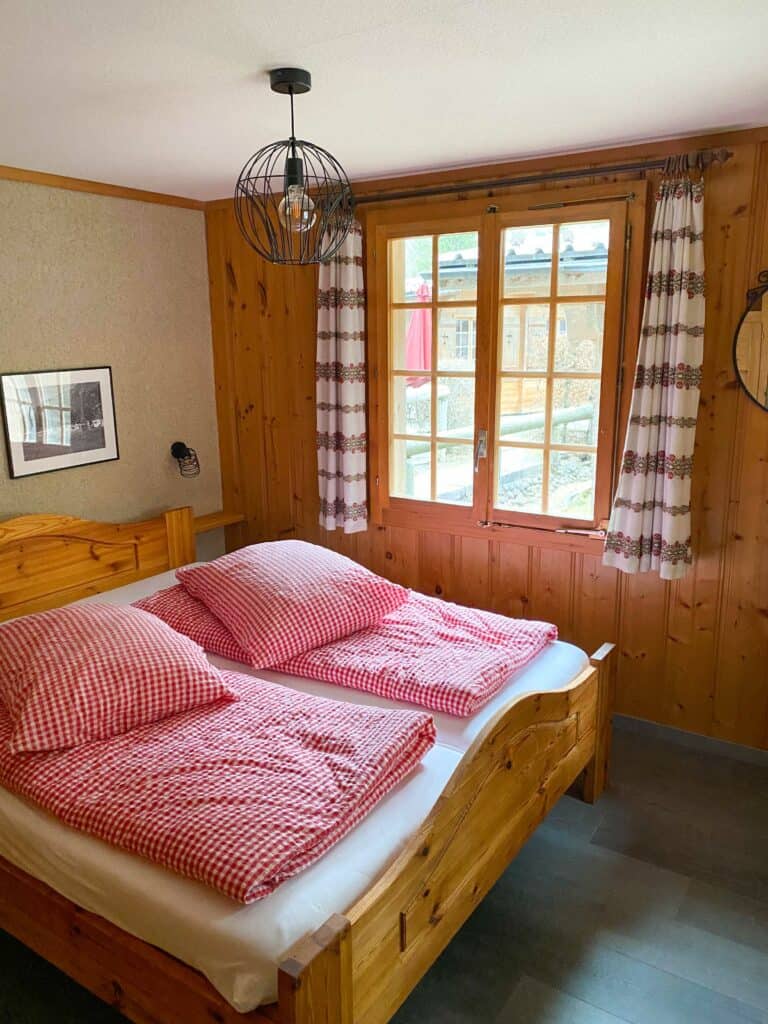
The on-site restaurant is another popular spot with both locals and tourists so it is worth booking ahead.
Restaurant Weidstubli is an incredibly cozy spot with blankets and candle lit tables. The food is great and they are so fantastic with kids providing crayons and an activity book.
The food was great and they were so accommodating with special diet requests.
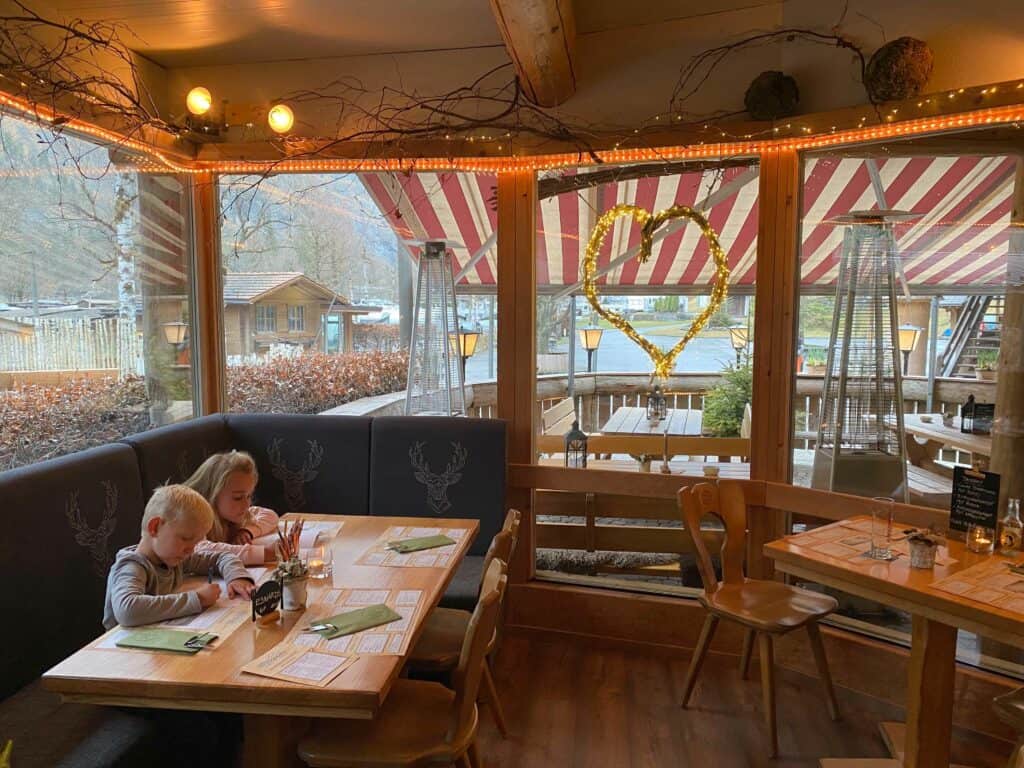
Many people think Zurich is the capital of Switzerland but it is in fact Bern . We struggled to find a campsite in low season other than a self-serve car park which was ok as we did not stay too long. Mainly as it was snowing and we wanted to get back towards Zurich for our flight home.
Bern is a charming city with beautiful chocolate box streets, a typical medieval look and feel! Many of the central streets had covered walkways, it was super helpful with the stormy weather.
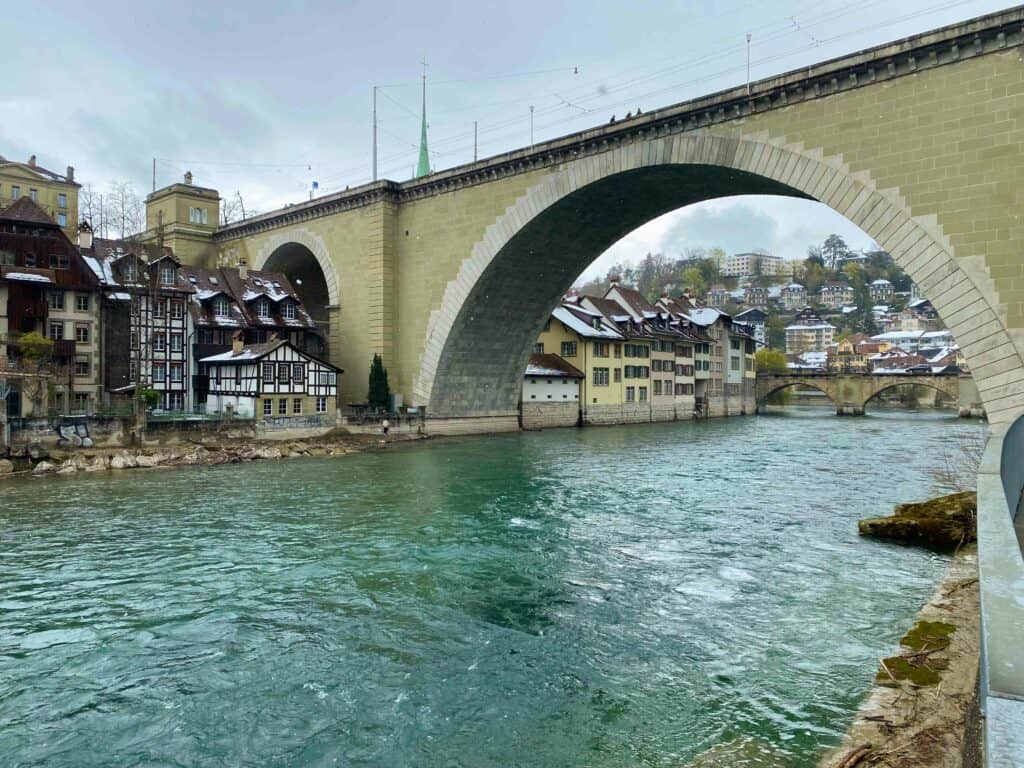
Bern is infamous for the brown bears in the centre of the city. They can be seen on a hillside next to the river.
I found it strange to see wild animals in the centre of a Swiss City and some really conflicting opinions online about it being tradition versus unethical. Each to their own opinion!
The Old Town is another UNESCO heritage site and the perfect place to stroll around. It is well worth taking a walking tour to get all of the interesting historical facts and information.
Check out this walking tour of Bern .
Be sure to keep an eye out for the giant clock which dates back to 1530, it is like something from a fairy tale book!
Another great spot if you are looking to escape the cold (which we were) is the Museum of Communication! It is right in the centre of town.
Featuring a lot of quirky experiences such as lip sinking to some famous movie scenes which are shown on the museum screens, to games and activities.

We even made our own stamps and made a tile for a collage of Yuri Gargarin. There is hours of fun and education at the Museum of Communication.
We were so lucky with the campsites we chose while campervanning in Switzerland. We travelled off season and did not book, we just turned up.
From lakeside camping in Zurich to waterfall views in Lauterbrunnen, the campsites are simply incredible in Switzerland, making it an exciting way to see the country.
Tips for Taking A Trip Campervanning in Switzerland
- If you are staying near a border with a neighbouring country, nip across to stock up on supples. otherwise Co-op is a pretty good place to shop.
- If you are travelling in high season, book the campsites far in advance to avoid disappointment.
- Ensure to pack soft bags that can easily be packed away.
- Pack clothing for all weathers scenarios. The weather can change drastically, with all 4 seasons in one day so make sure you are prepared!
- Consider purchasing the Swiss Pass to keep costs down with transport such as gondolas in particular.
- Consider snow chains if you are travelling during winter and spring season.
Will you be needing travel insurance , flights , rental cars , or hotels for your trip?
Disclaimer: This post may contain affiliate links. By using them it will not cost you any extra, we will receive a small percentage of the sale.
You may also like:
Lisbon with kids

Grand Tour of Switzerland
This 1600 kilometre tour is among the best landscape drives in the world. No other drive of this distance could offer a wider variety of vistas and cultural delights. The route traverses five alpine passes and includes eleven UNESCO World Heritage sites, twenty-two lakes, and four language regions.
Look forward to an exciting journey of discovery through Switzerland and experience maximum enjoyment with the exclusive CITYPEAK Grand Tour Special!
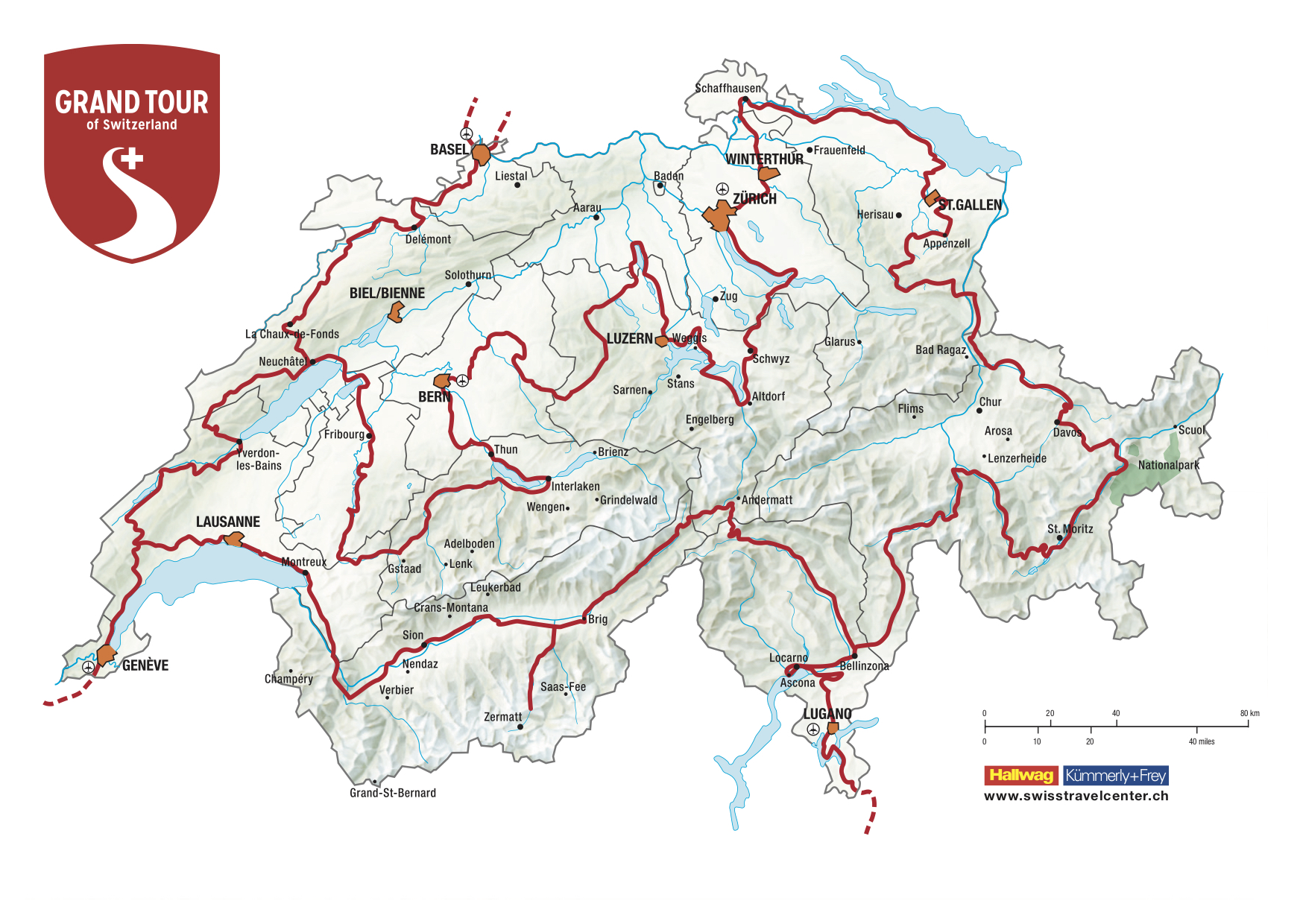
Grand Tour of Switzerland Special
- Grand Tour Snack Box – value CHF 25
- Grand Tour Touring Guide with integrated map – value CHF 32
- Swiss Coupon Pass with special offers on attractions, shopping, and food – value CHF 49
All three products are only available in one package for just CHF 98 (reduced from CHF 106)
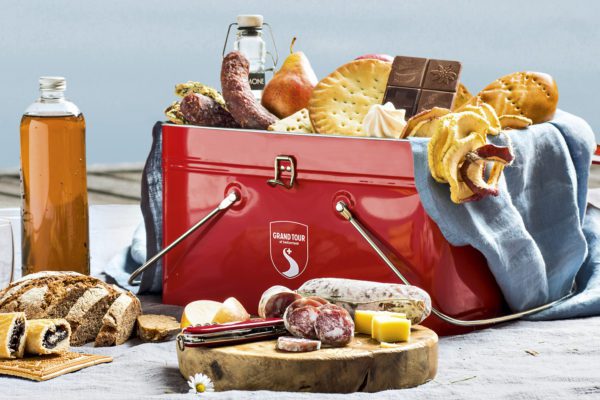
Grand Tour Snack Box
The Grand Tour of Switzerland is more than a display of the country’s spectacular scenery, but also a voyage of culinary discoveries. You will taste a variety of specialties from all parts of the country from our Grand Tour Snack Box. The Snack Box can be filled with enough to satisfy small appetites. The Snack Box is worth CHF 25 and makes a unique souvenir. Fill the box with delicious specialties for two for CHF 20 again and again at any of the 50 official sales points along the Grand Tour.
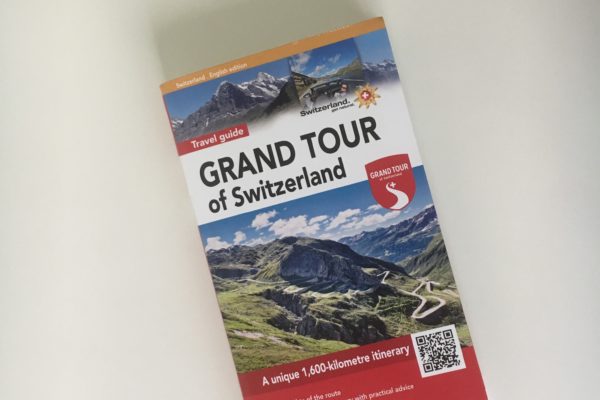
Grand Tour Touring Guide
The Grand Tour of Switzerland Touring Guide contains 288 pages of tour highlights and site descriptions (english version on request). It includes travel tips on the 25 sections of the route and a map of Switzerland at 1:500,000 scale.
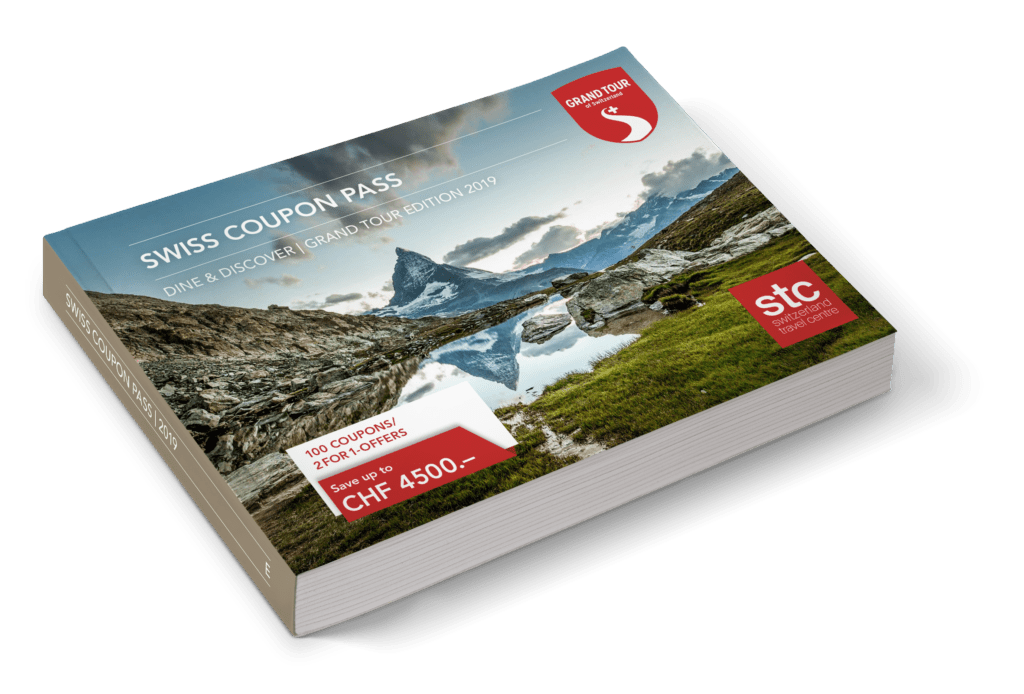
Swiss Coupon Pass
The Voucher Book contains a listing of services and attractions that are found in 11 destinations along the Grand Tour. Just two examples of the 100 exclusive 2 for 1 offers include cable car fare and admission to a thermal spa. Benefit from 50% discounts on many offers from the gastronomical, public transport, and leisure sectors. Up to CHF 4,500 in savings are available.
Itinerary for the Best Switzerland Road Trip in a Motorhome
Everyone should complete a Swiss Alps road trip at some point, as you’ll never be able to believe the incredible views until you’ve witnessed them first hand. Take your motorhome to Switzerland for the ultimate road trip experience, climbing sharp peaks, parking by lakes and savouring delicious fondue! Camping in Switzerland will allow you to immerse yourself in nature and escape the bustle of daily life and technology. And to reduce stress levels further, here is our Switzerland self drive itinerary, so all you have to do is organise your campervan hire and begin!
Be sure to plan enough time in for your trip, as you may wish to stay longer in certain places. This is one of the top perks of motorhome travel, the flexibility it provides. So consider not booking campsites too far in advance, and ensuring you've arranged long term motorhome hire !

Day 1 - Zurich
A visit to Switzerland would not be complete without a stop in this world renowned city. Now we’ve only planned in one day, but we wouldn’t blame you for taking 2-3 days to explore Zurich. There are plenty of things to do in Zurich, and we’ve included a few of our top picks below. You can either drive to Zurich in your motorhome, or if you’re pressed for time simply fly into Zurich Airport. It is Switzerland’s largest airport with plenty of options from across the globe.
Be sure to read up on tolls roads in Switzerland to avoid a nasty surprise later! And check out this blog for tips on driving through Scandinavia in a motorhome .
Things to do in Zurich:
- Head to Lake Zurich to walk the Lake Zurich Promenade. You’ll get to savour the incredible architecture and witness daily life bustling by. You can also take a boat ride on the lake, or to the connecting Limmat River. You can explore the entire city via it’s waterways, and stay cool while doing so!
- A classy city like Zurich has to feature great museums, and one of these is the Kunsthaus Zurich . Grasp this opportunity to witness a variety of art pieces from numerous renowned Swiss artists, as well as works from world-wide names such as Gogh, Rembrandt and Picasso. It also features more interactive exhibits, creating an experience unique to other art galleries.
- If you’re not quite culturally satisfied after the Kunsthaus, make a tour of the numerous historic churches dotted across Zurich. From the Romanesque Grossmunster church, to the 8th century St. Peter church, you’ll find a wide variety of choices!
- Need a few last minute items for your Switzerland road trip? Perhaps a warm jumper for those fresh camping evenings in Switzerland. Head to Bahnhofstrasse, a main street with plenty of shopping options.
- Staying for more than one day? Make a day trip from Zurich to Uetliberg, which is possible with a Swiss Half Fare Card or a Swiss Travel Pass . This mountain peak offers an incredible view of Zurich, and further to the alps in the distance. You can either take a cable car or hike, and it’s considered a manageable track. Treat yourself to something delicious at the restaurant at the peak!
Staying at: Fischers Fritz . Situated alongside Lake Zurich, this spacious campsite will allow you to stay close to the city. If you’re hungry for a celebratory meal, try the delicious seafood restaurant onsite. Price: Starting from CHF 18.50/ £15 per night.
Day 2 - Zurich to Lucerne
Driving time: 48 minutes Once you’ve had your fill of Zurich, drive the short distance to Lucerne. Many consider Lucerne to be one of the prettiest cities in the world since its establishment in the 9th century. Have your camera charged, as you'll be snapping away endlessly.
Things to do in Lucerne:
- Lucerne is constructed on the banks of Lake Lucerne, so be sure to take a boat trip onto the gloriously blue waters. You can also take the Golden Round Trip , which begins on the lake and then moves to a cogwheel railway up to the summit of Mt Pilatus. You can descend using the cableway and gondolas, and then grab a bus back to Lucerne.
- Chapel Bridge is a must see during your time in Lucerne. Most likely built in the 14th century, it was sadly partially destroyed in 1993. It has since been rebuilt and is still a sight to behold. It links the Aldstadt to the right bank of the Reuss River.
- The Dying Lion Monument consists of a collapsed lion laying on broken symbols of the French monarchy, with a pond before it. The monument honors the tragedies of the French Revolution in 1792, when approximately 700 Swiss Guards were massacred during and after the storming of the Tuileries Palace.
Staying at: TCS Camping Luzern-Horw . Perfectly located outside of the city with easy access to the highway, you’ll find plenty of rest after your busy day. Free WIFI and power, to ensure you’re camping in Switzerland is in ultimate comfort. Price: starting from CHF 15/ £12

Day 3 - Lucerne to Interlaken
Driving time: 1 hour, 4 minutes A nice drive to start your day, primarily following the A8 which will take you past numerous lakes and between mountains. You’ll know once you’ve reached Interlaken, as it feels like being transported back to a medieval fairytale. This little town is located between two lakes and surrounded by lush forests and mountains. It is the epitome of Swiss culture, with plenty of hiking and skiing opportunities.
Things to do in Interlaken:
- Roll up your sleeves and prepare for an Interlaken adventure ! Soar to new heights by paragliding or skydiving, or conquer the waves with speed boating or river rafting. Prefer solid ground beneath you? Enjoy an afternoon spent mountain biking.
- Visit the Jungfraujoch railway , which was built between 1896 and 1912, and takes you to the highest railway station in Europe.
- Beside Lake Thun you’ll find the St Beatus Caves. Local legend claims that the dragon of these caves was kicked out by the Irish monk Beatus in the 500s. The cave system left is phenomenal, featuring a waterfall as well. There is also a restaurant and museum!
- Head to the neighbouring town of Unterseen. Not quite in Interlaken, but this small medieval town is worth a visit! There is plenty of history to explore and learn from, and it is less touristy than Interlaken.
- Explore the Weissenau Nature Reserve, a stunning wetland ideal for walking. You’ll also find the ruins of Weissenau Castle, built in the 1200s.
Staying at: Manor Farm Holiday Park . A spacious campsite featuring plenty of accomodation options and spotless facilities. There’s something for everyone here, from a cosy restaurant to playground equipment. Price: starting from CHF 12.50 / £10
Day 4 - Interlaken to Bern
Driving time: 1 hour
No Switzerland road trip itinerary is complete without Bern! The capital city of Switzerland, Bern is filled with history, stunning architecture and plenty to do. The sprawling city stretches out before you, and if you’re more of an urban dweller you may wish to plan in more nights in Bern.
Things to do in Bern:
- Visit Bern’s Old Town to enjoy the covered shopping area. It is built on a cliff beside the Aare River and features a variety of activities and delightful cafes.
- The true beauty of Switzerland lies in its subtle fusion of nature and urban, the respect for natural beauty and how it is encompassed in daily life. The Rosengarten personifies this as a city park with over 400 species of floral diversity, views of the city around and a delicious restaurant.
- You’ll certainly hear it while there, but be sure to also visit the famous clock tower of Zytglogge. Located in Bern’s Old Town, it is a tribute to the clock making history of Switzerland, and features this through the design. Over 800 years old, and you wouldn’t guess it! Be sure to visit in time for the hour change, when moving puppets make an appearance.
- Take an hour to visit the Cathedral of St. Vincent. Also known as the Berner Munster and the Bern Cathedral, this esteemed historic artefact was built over the course of 470 years. It features art across the centuries, and the terrace is also a view to behold.
Staying at: Camping Eichholz . Located within the city, this Swiss campsite is run by a friendly staff. It is possible to rent bikes, with the first four hours free. Located by a river, it is possible to rinse off after a warm day of exploring! Price: CHF 26/ £21
Parking a motorhome in a city can be difficult, so be sure to check out some motorhome parking tips and practice before you go!
Day 5 - Bern to Montreux
Driving time: 1 hour, 15 minutes From Bern, take the A9 until the exit for the A12/E27. Follow this for 84km until the turning off for Route 1/Route 12. This will lead you all the way to Montreux, a sleepy small town near Geneva. Known as the Swiss Riviera, Montreux is known for its short summers, warmer temperatures throughout the year and annual Jazz Festival.
Things to do in Montreux:
- If possible, time your trip for the annual Jazz Festival. This converts the town into a cultural hub, and is the best way to enjoy the warm summer evenings. A true highlight for your Swiss Alps road trip.
- Grab Charlie and hurry on over to the Chocolate Factory! Or at least take a ride on the famous Swiss Chocolate Train, delicious!
- Unlucky enough to be in Montreux during winter, so that you miss the Jazz Festival? We have something just as good in mind! Take the lantern trail of Les Pleiades, following a trail through the landscape that has been painstakingly lit.
- Ever explored a glacier? Now is your chance! Take a cable car up and then ride the Alpine Coaster, a bus that will take you right to Glacier 3000. Brave the world’s first suspension bridge, and reward yourself with some delicious Swiss delicacies at a restaurant. You’ll feel on top of the world, probably because you are!
- Head to the nearby Chapin’s World. This is the only museum in the world displaying the illustrious film career of Charlie Chaplin. It is only 15 minutes away from your campsite, so the perfect end to your day!
Staying at: Camping des Horizons Bleus . Wake up to a stunning view of Lake Geneva, and take advantage of the luxurious facilities offered. Camping in Switzerland at it’s finest! Price: starting from 17 CHF / £14.00
If you’d like to visit Geneva as well, this would be the best point to divert your route! It’s only 1 hour and 15 minutes from here following the A9 and A1. Certainly worth a visit, but given that it is hidden in the bottom corner of Switzerland, it will lengthen your trip significantly.

Day 6 - Montreux to Zermatt
Driving time: 1 hour, 58 minutes The longest drive yet, with the last part taking you up into the mountainous terrain of Zermatt. Be aware that this isn’t the easiest of drives, so be sure to head out on time so that you can arrive with daylight and time to rest. Zermatt is a delightful resort city tucked away in southern Switzerland and has a reputation for having the best views of and access to the Matterhorn.
Things to do in Zermatt:
- A prime skiing destination, pull on your fluffiest socks and head out to the slopes! It’s a safer skiing destination than the Matterhorn, and features a high altitude, multiple glaciers and year round possibilities. Be sure to enjoy apres ski at one of the numerous restaurants afterwards.
- Not a ski bunny? Still visit the top using the cable car, to witness incredible views.
- Take the Gornergrat Railway to witness this impressive set up and experience views like no other!
- Take a walking tour through the village ! A one and a half hour tour, you can finish it off with a delicious warm drink in one of the various cafes.
Staying at: Camping Zermatt . A homely campsite surrounded by peaks and forests, it offers sanitary facilities and more. Price: starting from 13 CHF / £11
It can be hard to stay on budget on your motorhome holiday , so be sure to check out our tips!
Day 7 - Zermatt to Brig
Driving time: 41 minutes
Skirting along the border with Italy, Brig will be the most unique stop on your Switzerland road trip itinerary. A small town with a fascinating history, spend a night in Brig and break up the long drive to Lugano.
Things to do in Brig:
- Cross the Simplon Pass, a mountain pass of 2005m that link Brig with Domodossola in Italy. It was used in the 17th century to transport salt by mule, but now you can thankfully cross it by car or train.
- Explore the Stockalper Palace, you can enter for free and roam around the main court, baroque gardens and more.
- For a good meal and drink, head to Couronne Bar Restaurant. Centrally located, you’ll find this restaurant in an exquisite old building with turrets. The street view is ideal for people-watching as well.
- Take a soak at Thermal Camping Brigerbad . Release all the driving tension that has built up over this Switzerland road trip in a motorhome. Either enjoy the public pool or rent a private one, and consider a massage to round it all off!
Staying at: Camping Geschina . Conveniently located near the E62, this small campsite is a calm oasis after busy days of driving. Fall asleep to the sounds of the nearby river, and watch the sunset over the mountainous view. Price: starting from 15 CHF / £13

Day 8 - Brig to Lugano
Driving time: 3 hours The final stop in our Switzerland road trip itinerary! Inches away from Italy, the wonderful city of Lugano has a delightful Italian air about the city. Positioned across a hilly region, it features an unbeatable view of a lake and the alps in the distance.
Things to do in Lugano:
- Head out onto Lake Lugano. This glacial lake reaches the steep edge of mountains surrounding, and can be crossed by boat or ferry. You could almost consider it to be international waters, as you’ll be able to flit between Italy and Switzerland!
- Your final day in Switzerland deserves to be celebrated in true Swiss style; with a hike! Monte San Salvatore is just classified as a mountain, at just over 900m. Hike to the top within an hour, and if required, take the cable car back down!
- Visit the neighbouring village of Gandria. These quaint cobblestoned streets hold a dark past, as this home to a major smuggling operation only a century ago. You wouldn’t know it now, and the sloping houses and Church of St Viglio will provide a tranquil afternoon stroll.
Staying at: Camping Lugano Lake . A mere 10 minutes from the centre, this campsite will have you perfectly situated to explore the area. It is situated in a national park, and you’ll be able to make use of the private beach. Price: starting from 18 CHF / £15
Getting Home from Switzerland
And there we have it, the end of our Switzerland self drive itinerary. While there are plenty of other great destinations in Switzerland, we sadly could not include them all. From here you can either drive home, or head back to Zurich using the A2 and A4. You can catch a flight from there. You could also choose to head to Geneva now, and catch a flight from Geneva International Airport.

Popular Motorhomes

Fleurine Tideman
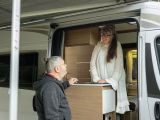
- Stay up to date on great motorhome destinations
- Receive exclusive deals and promotions
- Found a nice motorhome? Save it for later
Goboony uses cookies and similar technologies to provide our service to you. They also help make our communication to you easier and more personalised. With these cookies Goboony (and third parties), can track your internet behavior inside and outside Goboony. Some are necessary to help our website work properly and can't be switched off, and some are optional but support Goboony and your experience in other ways. Using cookies, we (and third parties) adapt our website, advertisements and communication to better suit your interests. You can accept the cookies by clicking on the button below. If you cookie-modal#acceptNecessaryCookies">refuse them we will only use functional and analytical cookies. Read our cookie policy .

- Places to visit
- Motorhome & Caravan news
- Accessories
- Travel reports
- Tips for begginers
- Traffic regulations
Motorhome around Switzerland - a ready route along selected sections of the Grand Tour of Switzerland
This is our second trip to Switzerland by motorhome in cooperation with the tourist organization My Switzerland. This year we chose the beginning of June for our trip, to be able to enter the passes, which are closed in the winter and spring. Virtually all Swiss passes do not open until early June. We also wanted to visit some mountain peaks and take a trip on the famous Bernina Express. Check, by reading the article to the end, whether we managed to achieve everything.
During our trip, you most often asked us about tolls, the possibility of using the telephone and the Internet, as well as about the cost of accommodation. You will find the answers to all these questions and many more in the article below.
What do you need to know before a motorhome holiday in Switzerland?
During our trip, there were a lot of questions about the cost of traveling around Switzerland. It is impossible to say unequivocally whether traveling by motorhome in Switzerland is expensive or not. In my opinion, you can spend your holidays there just like in any other country, i.e. you can spend them on a budget or very luxurious. It all depends on you and the places where you want to sleep and those you want to see.
How much does camping in Switzerland cost?
On average, for one night at a campsite for a motorhome, 2 adults and 2 children, plus electricity connection, you have to count around CHF 50-70, but there are (as well as in Europe) more expensive places. We paid cheaper for the camper-park, about 20 CHF. Once we slept wild on the Nufennenpass.
An application that helps you find cheap accommodation in Switzerland, which was recommended to us by our reader living in Switzerland: https://wohnmobilland-schweiz.ch/ . We also recommend the park4night app.
Is it possible to sleep wild in a motorhome in Switzerland?
First of all, you should look at the signs, follow the general rules of wild camping, and if in doubt, ask the local people or even at the police station.
Internet and telephone in Switzerland
While in Switzerland, we used unlimited internet for tourists from the Salt network. You can buy the service for as many days as you want. It costs 2CHF per day and works very well. We had a bandwidth aggregation router with us, which worked very well except for one place - at Nufennepass. Link to our Huawei router at Ceneo.pl . We received calls via Wifi calling.
Motorhome tolls in Switzerland
We traveled around Switzerland in a motorhome with a DMC of 7.5 tons. We bought the vignette through the Via application. You can buy a vignette for a specific number of days. For 10 days we pay about 34 CHF. You can read more about tolls for motorhomes over 3.5 tons in the article: " What are the tolls in Europe for motorhomes with GVM over 3.5t "
When traveling with motorhomes under 3.5 tonnes, you must purchase a vignette. You can read more about traffic rules here: Traffic rules in Switzerland .
Lake Walensee - where to stay with a motorhome
On the first day we stop at Lake Walensee at the Murg am See campsite which has direct access to the lake. The campsite has pitches overlooking the lake, it also has its own beach and bar. A beautiful bicycle path stretches along one side of the lake. It is worth planning an extra half day to explore the area in this way. At the beginning of June, the water in the lake is still cold, but the first daredevils, including our children, are already jumping in
Viamala Canyon - Grand Tour of Switzerland
On the second day of our trip around Switzerland, we jump on the Grand Tour of Switzerland. The first stop on the tour is Viamala Canyon.
Entrance for a 2+1 family costs 20 francs, and Franek enters for free, because children up to 6 years old have free entry. It is impossible to visit this place with a pram, there are a lot of stairs here. Sightseeing takes us about 30 minutes. We continue to Filisur, from where we will catch the panoramic train to Italy tomorrow.
Grand Train Tour - Bernina Express
I recommend planning your trip on the Bernina Express panoramic train much earlier, and below are my specific tips. We drove the section from Filisur to Tirano and back. In Filisur, it is best to leave the camper at the campsite. Unfortunately, it takes about 30 minutes to get from the campsite to the station. It is not possible to place a motorhome closer to the train station. Access to the car park at the train station is very narrow and I do not recommend driving a motorhome there.
· if you have a Swiss Travel Pass, you must additionally buy seat reservations for this train. We recommend booking them a month in advance or even a few months in advance if you go in summer,
· by booking tickets online so far in advance, you can indicate that you will be using the Swiss Travel Pass even if you do not have it physically yet,
· if you are looking for savings, book a panoramic train one way and take a regular train the other way,
· we recommend purchasing additional seat cancellation insurance. It costs a few francs, and it's really worth it,
The trip took us over 8 hours. If you are traveling with children, bring snacks and some toys,
· It doesn't really matter from which side you buy a seat, you need to have your eyes around your head because every side surprises you with views.
More tips on the Swiss Travel Pass can be found in the article prepared in cooperation with the organization My Switzerland: " How to travel smartly in Switzerland? "
Panoramic trains are prepared for tourists. On board you have staff who help you with everything, there is a food and drink service that is served to the table. You can read more about the Bernina Express journey in our article: Bernina Express - a panoramic train journey along a UNESCO-listed railway route .
The next day we continue the Grand Tour of Switzerland. Unfortunately, in this section we encounter an obstacle. We were supposed to cross the San Bernardino Pass, but we were limited by the dimensions of the camper we were driving. We change the route and just drive through the tunnel under the pass. It is worth remembering when traveling in a motorhome on the Grand Tour of Switzerland that practically on every section of this route, if you encounter any tonnage or dimension restrictions, you can switch to another road that goes parallel to the Grand Tour. Don't worry too much about the dimensions of your vehicles!
Behind the San Bernadrino Pass, it is worth stopping in the town of Bellinzona. There is a camper-park here, which we find in Google Maps by entering phrases such as: Wohnmobilstellplatz or Reisemobilstellplatz in the search engine.
We recommend climbing the Montebello castle. The Grand Tour of Switzerland viewpoint is located here. If you are going to visit more of them, we recommend downloading the application and "collecting" these places in your wallet.
Bellinzona is located in the Italian-speaking part of Switzerland and we will spend the next day in this region.
Locarno by motorhome
We stop at a camper-park in Locarno. We cycle to the city center from where we catch the cable car to the town of Orselina. The journey takes literally a few minutes.
Then we catch Cardada's turn and this is where the adventure begins! There are plenty of hiking trails, viewpoints and attractions for children at the top. At the lower station of the gondola, we get an off-road game, thanks to which the kids easily cover several kilometers looking for animal tracks.
From the top of the place, we catch a chairlift to an even higher vantage point. For the first time in our lives we ride a wagon that goes sideways!
From the top you can fly in tandem with a paraglider and take an instagram photo of the swing.
We go down by chair and gondola, but you can also go down on foot from the top. The lower part of the route leads through beautiful gardens. For all rounds we pay 90 CHF for our 2+1 because Franek enters for free again. (Children under 6 have free entry here)
Verzasca River Valley
Being in the Locarno area, I highly recommend you go up the Verzasca River. It is worth going to the dam of the same name. The famous James Bond heist in Golden Eye was filmed here. On selected days, you can repeat such a jump here. We managed to watch as many as a few jumps! They make a huge impression. Entrance to the dam is free.
Continuing up the river, you will reach the village of Lavertezzo, where the famous Ponte dei Salti is located. It's a great place to unwind and cool down after a day exploring the area. There is even a parking lot for motorhomes where you can stay overnight, but we are going further. We will spend the night on the pass at an altitude of 2500 meters above sea level. Higher up in Sonogno, there are also places designated for motorhomes.
Nufenenpass - motorhome entry to the pass
We have always dreamed of going with a motorhome to one of the passes in Switzerland. This year we made it! We chose Nufenenpass for several reasons:
· There are no tonnage restrictions here
There are no restrictions on the width, height and length of the car
· You can't drive here only with trailers
There is only one narrowing on the way
At the top there is no ban on overnight stays in motorhomes, so we stay for one night. Nufenenpass is not located directly on the Grand Tour of Switzerland, but it's worth a detour if you want to go to a pass with a motorhome.
From Nufenenpass we go towards Lucerne. We are staying at a campsite in the city center. It's hard to get in without a reservation, so we recommend planning a stopover at this campsite in advance!
Pilatus - Golden Round Trip
The Golden Round Trip is a trip around Mount Pilatus. During our journey we will travel by five different means of transport. The first is the ship from Lucerne to Alpnachstadt. We catch this ship from the Lido Verkhouse stop, which is located right next to the campsite where we sleep. Camping in this place is a great starting point not only for a trip to Pilatus, but also, for example, to Mount Rigi.
In Aplnachstad we change to the rack railway. We highly recommend you to book a trolley for a specific hour. Avoid then waiting in a long line. The cable car climbs over 2,000 m in half an hour. We recommend taking something warm to wear upstairs.
You can spend from an hour to two at the top, depending on which trails you want to go to the top and whether you want to eat lunch there. If you are traveling with children, they will certainly want to play an interactive game with dragons.
There are definitely more attractions for children at the lower Fräkmutegg station, which we reach by the third means of transport, i.e. the panoramic gondola. In this place you can spend another hour if you decide to eat lunch here like we did and go to the rope park or bobsleigh and zip line.
You can take the smaller gondola down to Kriens. From there you catch the number 1 bus to Lucerne. We from Lucerne are still walking along the promenade along the lake to the campsite. With the Swiss Travel Pass, we buy tickets for the Golden Round Trip for 150 francs for our 2+1, because children up to 6 years of age (i.e. Franek) enter for free.
You cannot sleep in a motorhome under Stoos, but you can park it near the funicular for the day. A characteristic railway with round carriages leads to the town located in the mountains, which is said to be the steepest funicular railway in the world.
In Stoos you can take a walk (even with a pram), eat lunch and just chill on the grass, or you can go to one of the two peaks. We chose Fronalpstock. We took the chairlift and went down on foot.
At the top there is a beautiful playground, several viewpoints. This is probably the prettiest place we've seen this week. We wanted to eat dinner upstairs, but the kitchen closes after 3pm, so watch out for that. We settle for cookies and go down. Some of the routes lead through pastures, so we walk among the cows and cross the electric shepherd fence ourselves.
We agree that we could spend a few more days in this place, choosing different trails for walks every day. We love it here!
Klausenpass
We spend our last day in Switzerland at the Klausen Pass. There is a great self-service camper-park operating on a fair box basis. From here you can go on a walking tour. You can drive a camper through the pass if your vehicle is less than 2.3 m wide.
Are you looking for further travel inspiration in Switzerland
If you are looking for more information about traveling by motorhome in Switzerland, take a look at our article: Trip to Jungfraujoch top of Europe - what you need to know .
An engineer with a passion for traveling. My dream is to drive a motorhome through the USA from coast to coast. I would also like to do a few longer bike trips around Europe, but I have to convince my husband to do that;)
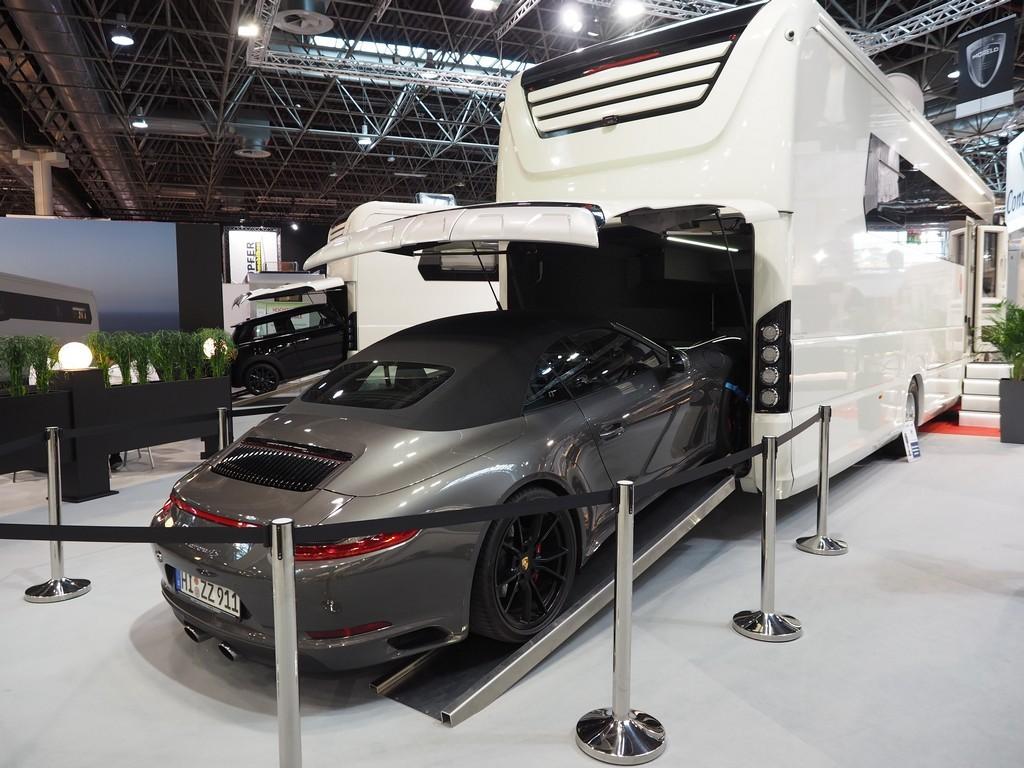

Switzerland for New Year
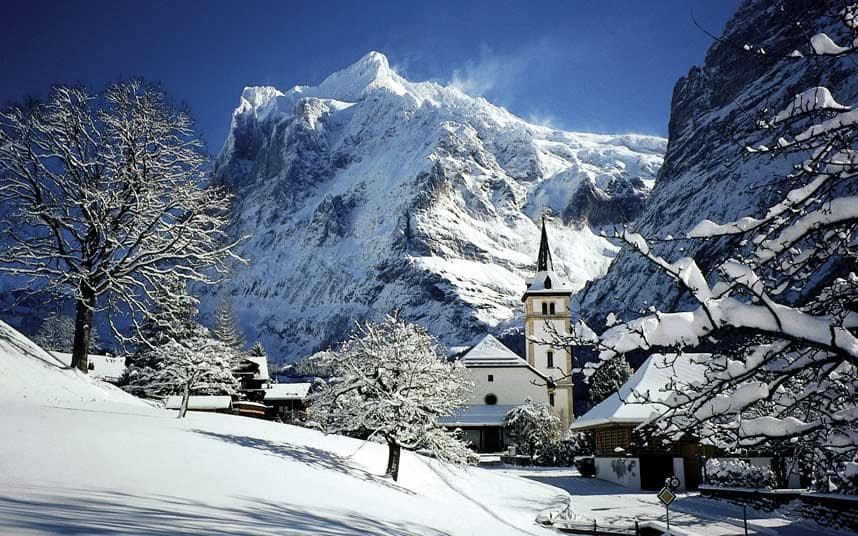
- Optional Extra Package
New Year Festive Fun, Alpine Adventure & Fondue
Join us on this tour to the Stunning Winter Swiss Alps. Located in the Bernese Oberland our well-appointed campsite is in the pretty village of Lauterbrunnen, situated between gigantic rock faces and mountain peaks in one of the most impressive valleys in the Alps. The very name ‘Lauter Brunnen’ (‘many fountains’) suggests the magnificence of this landscape with its 72 waterfalls the most famous being the Staubbach Falls, plunging almost 300 metres from an overhanging rock face, and located directly behind our campsite. The winter resorts of Wengen-Kleine Scheidegg and Mürren-Schilthorn can be quickly reached by mountain railway and cable car from our base, where there are 213 km of piste, fun parks, 100 km of winter hiking trails and 50 km of toboggan runs.
Upon our arrival in Lauterbrunnen we celebrate New Year’s Eve – Swiss Style with dinner and wine. We then have a relaxed program of events over the next 10 days with something to suit everyone. We will have excursions, group meals and of course participate in the Après Ski Events. In order to gain maximum benefit from your time and to see as many of the stunning locations as possible you will be issued with an 8 Day Travel Pass enabling you to use the many nearby cable-car, train, boat and post-bus travel options free of charge. You will be able to enjoy stunning views of the famous Eiger, Monch and Jungfrau mountains. You will have the opportunity to visit the “Schilthorn” famous for its James Bond connection and perhaps enjoy a “Martini 007” cocktail in the revolving restaurant. You will also be able to visit the Highest Railway Station in Europe (3454m) at the Jungfraujoch. After ten days of events our time in Lauterbrunnen comes to an end with a Farewell Dinner on the 9 th January.
Susanna and Ted Brooking – Switzerland for New Year – Dec 2018/Jan 2019 ‘Wow, what a way to start the New Year, This tour exceeded our expectation, a tour hard to beat. Thank you Chris and Alan, excellent Tour Directors.’
Pete and Barbara Ball – Switzerland for New Year – Dec 2018/Jan 2019 ‘We had a superb trip with great guides, Alan and Chris. Lots of lovely meals and après-ski evenings. The cable car ride to the Schilthorn with fantastic views in perfect weather was the highlight. Many thanks.’
Maggie and Peter Lillywhite – Switzerland for New Year – Dec 2018/Jan 2019 ‘Overall a really unforgettable tour, one of the best we have been on. Well planned with excellent meals, the New Year festivities were amazing.’
Day One – Monday 31 st December 2018 (New Year’s Eve) We arrive at Lauterbrunnen in the Swiss Alps, our campsite is well appointed with excellent well heated sanitary facilities making our stay here a pleasant experience. This evening we will have an early dinner in the restaurant before joining in the New Year Celebrations with the other guests. Don’t expect an early night as celebrations can continue into the early hours of the morning.
Day Two – Tuesday 1 st January 2019 (New Year’s Day) New Year’s Day and a late start has been scheduled to allow us to recover a little from the festivities at last night’s celebrations, then we will make our way into Interlaken by train (using your travel pass) for the traditional Festive Parade, Fireworks and Concert.
Day Three – Wednesday 2 nd January 2019 Today we will take the cable car to Grütschalp and continue our journey on foot to Winteregg (1.9km) where we will have a group lunch whilst enjoying some of the most stunning views towards the famous “Eiger, Mönch and Jungfrau” mountains. After lunch, we will continue towards Murren (3km) where you will have free time before making the return journey by train, foot and cable car to Lauterbrunnen. For those of us who do not need the exercise, all or part of the journey between Grütschalp, Winteregg and Murren can be taken by train!
Day Four – Thursday 3 rd January 2019 Free day or join the Tour Directors on an Optional trip to Grindelwald by train (using your travel pass) or for any Skiers in the group the option to go skiing. In the evening, we will meet at the campsite bar and enjoy the “Apres Ski”.
Day Five – Friday 4 th January 2019 Today we can walk from the campsite to Stechelberg (4.5km) where there will be time to have a coffee (payable locally) before taking the Cable Car up to Murren where we will have lunch in a local restaurant. After lunch you can make your way back to the campsite in your own time by a combination of walking, train, cable car or postbus or you could take the cable car (additional cost applies) up to the famous Schilthorn. The opportunities for a warming afternoon drink en-route are endless!!
Day Six – Saturday 5 th January 2019 For the more adventurous and energetic members of the group we suggest a combined train, cable car and walking excursion today. We will take the train from Lauterbrunnen to Wengen followed by the cable car to Manlichen and from here it is possible to walk to Kleine Scheidegg (5km mostly downhill) or combine walking with a cable car. From Kleine Scheidegg you can take the train back to Wengen and onwards to Lauterbrunnen. The less adventurous/energetic group members could visit Europe’s highest station (additional cost applies) at the Jungfgraujoch where the most amazing views abound, before making the return journey via Kleine Scheidegg and Wengen. This evening we will all enjoy the “Apres Ski” in the campsite bar whilst recounting the events of the day followed by a traditional “Cheese Fondue”.
Day Seven – Sunday 6 th January 2019 In order to recover from the events of the past few days we suggest an easier day. We will take the train from Lauterbrunnen to Thun where we will have some free time before boarding our boat for a cruise to Interlaken whilst enjoying a light lunch. After the cruise there will be free time in Interlaken before returning to Lauterbrunnen by train in your own time.
Day Eight – Monday 7 th January 2019 Weather conditions permitting we can organise a “Snow Shoe Walking” session for those who are interested, hire cost paid locally. This evening we walk into town for a Group Dinner in a local Hotel/Restaurant.
Day Nine – Tuesday 8 th January 2019 If you have not already done so why not visit the famous Schilthorn with its revolving restaurant – enjoy a “Martini 007” cocktail (shaken not stirred) and watch the world go around. This evening we will meet in the Apres Ski Bar.
Day Ten – Wednesday 9 th January 2019 A Free Day today, the last day of our stay here in Lauterbrunnen, giving you time for that final bit of sightseeing, skiing or walking. Tonight, we will have a special farewell dinner accompanied by music.
Day Eleven – Thursday 10 th January 2019 The Tour ends this morning. You may return to Calais with the Tour Directors (at your own cost) or remain on the continent to extend your stay.
PRICE TOUR DEPOSIT £000
Motorhome with 2 people = £0000 per person Motorhome with 1 person = £0000
INCLUDED IN PRICE
- 10 Campsite nights in Lauterbrunnen with full facilities including hook up
- Excursions/Events as per the itinerary
- Comprehensive 8 Day Travel Pass for Trains, Cable Cars, Busses & Boats
- Meals as per the itinerary
- Tour information pack with suggested routes & GPS co-ordinates
- Services of Tour Directors travelling in their own motorhome
Excursions, Events & Meals
- New Year’s Eve Celebrations, including Dinner and Wine
- New Year’s Day visit to Interlaken for the Parade, Concert and Fireworks
- 3 X Apres Ski events
- Fondue Meal in the campsite restaurant
- Combined Cable Car, Walking and Train trip to Grütschalp, Winteregg & Murren including Lunch
- Boat Cruise on Lake Thun with Lunch
- Optional trip to Grindelwald with the Tour Directors
- Combined Walking/Bus Excursion to Stechelberg & Murren including Lunch
- Combined Walking, Cable Car and Train excursion to Wengen, Manlichen and Kleine Scheidegg
- Dinner in Lauterbrunnen Hotel/Restaurant
- Optional “Snow Shoe” Walking excursion (equipment hire payable locally)
- Farewell Group Dinner accompanied by music.
This tour starts in Lauterbrunnen Switzerland, but if you would like to travel at the same time as the Tour Directors, please book the optional tour package so that everything can be arranged on your behalf
OPTIONAL PACKAGE
Pre-tour itinerary.
Friday 28 th December 2018 We meet at Dover for our mid-morning crossing to Calais. From Calais we will continue our journey to Bruges and our first campsite on our outward journey. 75 miles
Saturday 29 th December 2018 From Bruges, we continue our journey south to our next overnight stop some 15 miles north of the city of Luxembourg. Tonight, we will have a get-together with food in the campsite restaurant. 180 miles
Sunday 30 th December 2018 We continue south to our final en-route campsite near Mulhouse. 210 miles
Monday 31 st December 2018 Today we have a short drive to Lauterbrunnen where we should arrive in the morning for the start of the main tour. 110 miles
Included in the OPTIONAL PACKAGE
- Return Dover/Calais Ferry with a 60-day Flexible Ticket + Club Class lounge
- Three campsite nights with full facilities including hook up, in Belgium, Luxembourg & Germany
- Meal in Luxembourg Campsite
OPTIONAL PACKAGE PRICE
Motorhome with 2 people @ £000 per person Motorhome with 1 person @ £000
Newsletter sign up Get offers and new tour dates.
Email address:
- © 2015 GB Motorhome Tours Ltd
- Terms and Conditions
- Design: Right Click Creative
- About GB Motorhome Tours
- Meet the Tour Directors
- Tour History
- Terms & Conditions

Switzerland by Motorhome
The below guide has been written based on our experiences visiting Switzerland by motorhome and will hopefully give you an idea of what it’s like to travel there. However, things do change, so before you set off it’s worth checking for up to date travel information from the Foreign Office website , and the latest driving regulations on the AA website . At the bottom of the guide we’ve added links to our daily updates while we were in Switzerland, so you can live the adventure with us.
So far we have only spent a couple of days in Switzerland, we’ll add more information when we next visit the country.
General Information
Country – Switzerland Capital city – Bern, 506 miles from Dover Currency – Swiss Franc (SFr/CHf) 100 Centimes (French)/Rappen (German) = one Franc Languages – French, German, Italian, Romansch Visa requirements – Not part of the EU but visas not required for EU citizens staying less than 3 months. Borders – Not part of Schengen zone so passports and documentation (V5 or hire agreement and insurance certificate) needed for borders (although we were waved through without showing ours). Telephone country code – 41 Emergency numbers – 117 Police, 118 Fire, 144 Ambulance
May 2012 Duration – 2 days Route – Drove north along east coast of Lake Maggiore in Italy, then south and across Lake d’Lugano at Lugano, stopping off in Meride then south back into Italy at Como. Miles driven – 37 Average daily spend – €55.07 – skewed as we were only there two nights and filled up with diesel Average spend on overnight stops – €17.99 (2 nights on camping cheque site – €15 for camping cheque, €2.99 for local taxes)
Diesel 1.91CHf (€1.59) was cheaper than in Italy so we took the opportunity to nip across the border and fill up.
LPG Did not fill up with LPG
Eating out We’ve only spent two days in Switzerland so far and both were on a campsite in the countryside, so we didn’t have the opportunity to eat out.
Supermarkets – supermarket used local store.
- Loaf of bread 1.80CHf (€1.47)
Fuel Unleaded and diesel were widely available with many fuel stations, possibly due to the close proximity of the Italian border.
Tolls / Vignette Vignette is required for the autobahn, priced around €33 for a year – for vehicles up to 3.5t. We were only in the country for two days so stayed off the motorways so we didn’t buy a vignette or pay any tolls.
Road regulations – the ones we know of! Traffic drives on the right and overtakes on the left, so you need to ensure your headlights are deflected either with stick on adapters or duct tape. You must carry an emergency triangle and it is recommended that you carry a high visibility jacket for each person, a first aid kit and a fire extinguisher.
You’ll see yellow diamond-shaped signs, these mean that you have priority. If you see one with a black line through it, you no longer have priority, traffic from the right does – this is usually on approaches to roundabouts. Sometimes drivers entering the roundabout have priority, if we’re not entirely sure we just take our time and give way to anyone who looks like they aren’t stopping. Downhill traffic must give way to uphill traffic in mountain areas and on narrow roads heavy traffic has priority – although we never encountered this so are not sure how it works in practice.
Distances are all in kilometres, and so are speed limited. As you enter a town the urban speed limit of 50kph applies, unless otherwise stated, until you are out of the town. Seatbelts must be worn by driver and all passengers in front and rear seats. Studded tyres are allowed between 24 October and 30 April.
Road conditions We didn’t travel far in Switzerland and the roads we used were of good quality, in often better than those in the UK. When we got into the countryside our satnav managed to take us through some pretty narrow villages, but we made it through going slowly.
Standard of driving It is difficult to judge the standard of driving as many of the drivers in the area we were in were Italian (see our country guide to Italy!).
Overnight stops
Aires/Service points We didn’t use any aires or service points.
Campsites The campsite we stayed on was in the countryside at Meride and accepted camping cheques. It was a small site with good clean facilities and helpful staff who spoke a bit of English.
Free / wild camping We did not try to free camp in Switzerland
Contact with home
Phone Our mobile phone generally found a signal in Switzerland, however we had to walk up a hill out of a valley in the countryside. Call charges were around 30p to make and 10p to receive (per minute). Text messages are free to receive and around 10p to send.
Email/Internet We didn’t try to find free wifi hot spots. We had a data allowance with our mobile contract and used this while in the country. This did mean that we had to climb up a hill in order to connect to the network, however once out of the valley we were stopping in the signal was good.
Post We didn’t use a post office.
Read our daily updates
At the bottom of each daily update there is a link to take you forward to the next day or back to the previous. The links below will take you to the first day of that part of our tour.
Switzerland – May 2012
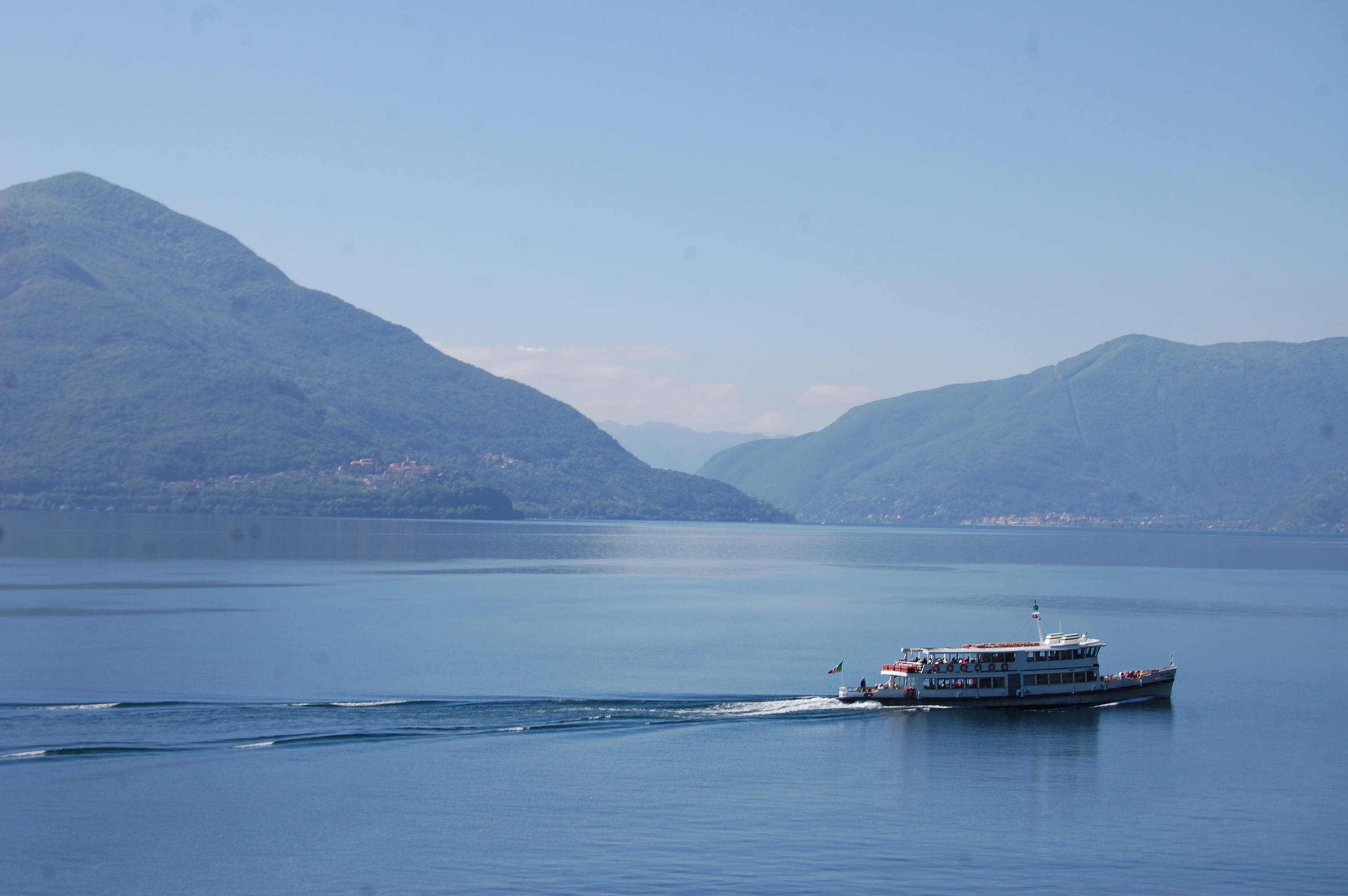
You might also like
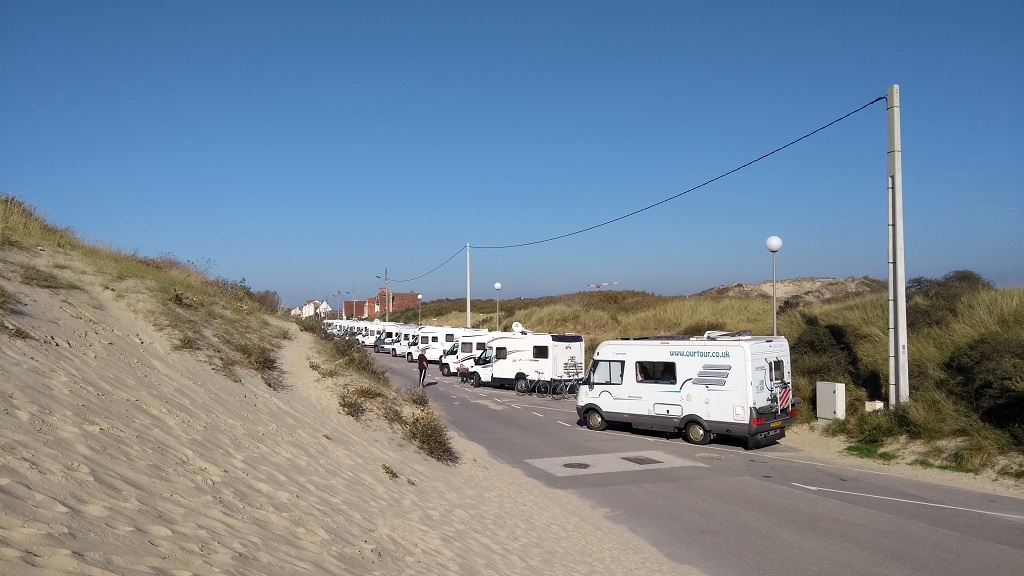
hey we just wondered as Switzerland is not in the EU can we still go with our dogs as we only have eu passports for them? only 3 more weeks of work for us then 2 manic weeks of lastminutepanic.com lol
many thanks sam & pete
Hi Sam and Pete! All sounds very exciting, yeah! We passed into and out of Switzerland a couple of times, and no checks were done on Charlie. That said, your EU pet passports not actually needed for moving around inside the EU (apart from the UK, we’re a weird exception), but is for moving out of the EU and back in again. DEFRA run the scheme and changed it in Jan 2012 so you can (as long as you meet all of their regulations) leave the EU, go to any country, and come back in with no waiting period – hence us being in Africa with him. I’d check out the DEFRA website, call or email (it takes a few weeks for email responses) for the finder details, or ask your vet. If you’ve not got leishmaniasis treatment, and are heading to the Med, ask your vet about it too. Also, if you head to Italy, you can’t get worming tablets off the shelf – you have to go to a vet who may expect your dog to HAVE worms, rather than you pro-actively treating against them (get a stock in the UK for the time you’ll be away, easier that way). Oh, and there are loads of poop bags in Switzerland, top up on ’em! Cheers, Jay
Leave a Reply
Leave a reply cancel reply.
Your email address will not be published. Required fields are marked *
This site uses Akismet to reduce spam. Learn how your comment data is processed .

Privacy Overview
Travel diary: visit Switzerland in a motorhome
You feel like taking a peaceful break while traveling the roads of Switzerland in a motorhome ? At AVIS explore , we've got you covered! Benefit from our expert advice, as well as a complete 3-day itinerary to discover the must-see places in Switzerland. Live a memorable experience through breathtaking landscapes, picturesque villages, and authentic alpine ambiance. Buckle up, we're heading to Switzerland in a motorhome!
Discovering Switzerland in a motorhome
Switzerland is a true Alpine jewel , making it a dream destination for all motorhome travelers seeking a unique experience.
From its snow-capped peaks to its crystal-clear lakes , you'll be mesmerized at every turn of your journey.
As you traverse winding roads, you'll come across well-preserved medieval villages . There, time seems to stand still. You'll also have the pleasure of exploring perched castles and magnificent hiking trails . Not to mention the culinary delights of the region that will delight your taste buds.
Switzerland in a motorhome promises you a stay filled with freedom amidst a mountainous atmosphere .
If you're looking for a comprehensive journey, The Grand Tour of Switzerland is perfect for you. This 1,643 km circuit includes 46 iconic Swiss locations , 22 lakes, alpine passes, and nearly 13 UNESCO World Heritage sites!
Alternatively, at AVIS explore , we've crafted a 3-day itinerary aboard a motorhome for you.
3-Day motorhome itinerary
Thanks to the 3-day motorhome circuit in Switzerland we've prepared for you at AVIS explore , you won't soon forget this beautiful experience!
Day 1: Geneva and its highlights.
Your road trip begins in the heart of Switzerland: Geneva .
Located on the shores of the majestic Lake Geneva , you can stroll along the banks while admiring its sparkling waters, with the Alps in the background. A guaranteed breathtaking panorama ! You can't miss the famous Jet d'Eau , the tallest in the world , reaching 140 meters in height .
Continue your visit by wandering the cobbled streets of the old town , where the Saint-Pierre Cathedral and its imposing columns proudly stand. Take a detour to the numerous museums to immerse yourself in art, history, and science.
Finally, enjoy a little shopping in the luxury boutiques and savor a good coffee in the heart of Geneva's picturesque squares .
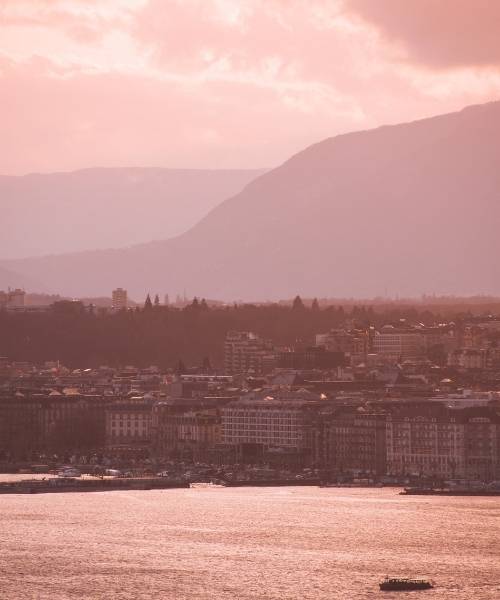
Day 2: Gruyères, Lucerne, and Mount Pilatus.
Your journey through Switzerland in a motorhome continues with a first stop in the town of Gruyères .
It's a true medieval gem , nestled in the canton of Fribourg . Here, you'll discover the timeless charm of the pedestrian city and its cobbled streets . Of course, in the town of Gruyères, you can't miss tasting the famous AOP holed cheese that bears its name, the symbol of the region!
We also recommend visiting the Gruyères Castle , the second most visited in Switzerland.
Then, have lunch in a traditional restaurant with a thousand culinary delights , and indulge in a chocolate treat in one of the local chocolate shops .
Next, hit the road in your Swiss motorhome and head to Lucerne , home to the Transport Museum , a fascinating place. This museum takes you through the evolution of transportation , from bicycles to airplanes.
Finally, thanks to a unique cable car ride , venture up Mount Pilatus, a natural wonder that fascinates travelers from around the world!
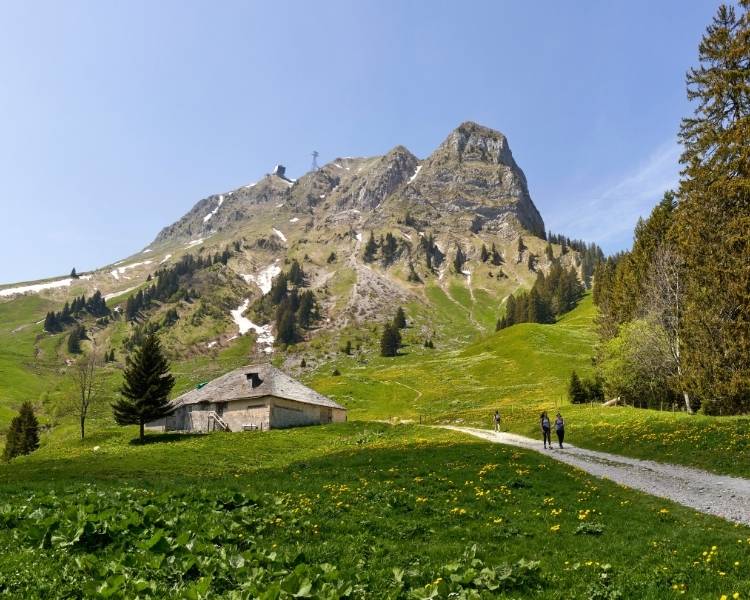
Day 3: Fribourg, the pearl of Switzerland.
Finish your Swiss adventure beautifully with a visit to the city of Fribourg , renowned as one of the most beautiful in the country .
Immerse yourself in its rich secular heritage: a unique journey by funicular . You'll have the opportunity to admire the view of this city and its hidden treasures.
Also, don't miss the majestic Cathedral of Saint Nicholas and its colorful stained glass windows, as well as its observation platform offering a magnificent panorama of Fribourg.
Finally, dive into the lively atmosphere of the Town Hall Square.
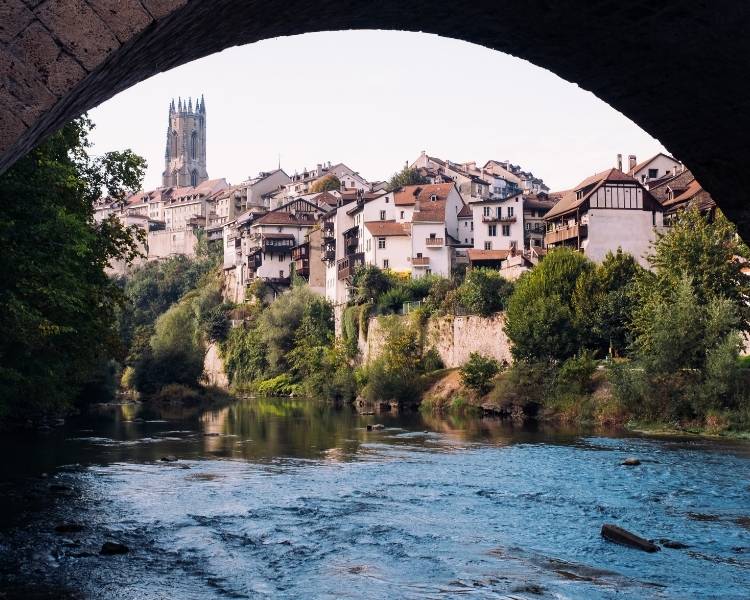
Practical tips for traveling by motorhome in Switzerland
For a smooth road trip in Switzerland, here are some practical tips to know.
First, when you arrive at the border between France and Switzerland by motorhome , you must purchase a vignette to be able to travel freely throughout the country , which
- 40 Swiss francs for one year – about 38 € - for a motorhome weighing less than one ton;
- 38 € for 3 weeks for a motorhome weighing over 3.5 tons.
Since the legislation is very strict in Switzerland , be careful to park your motorhome in dedicated spots . It's difficult to find them outside motorhome areas , so don't hesitate to download Park4Nights , an app that will help you find the ideal spot or get yourself a Michelin guide .
Moreover, there are many installed radars , and fines (called "impaires") are quickly given out. We recommend fully respecting all Swiss regulations .
As for the locals, Swiss people are very courteous and understanding behind the wheel!
Finally, the electric current is the same as in France, 220 Volts, but the sockets are different . When you arrive at a Swiss motorhome area, they will provide you with them.
Motorhome experience in Switzerland
As explained above, for a serene motorhome stay in Switzerland , follow all applicable regulations , especially regarding traffic.
Regarding parking , it's not easy to find many dedicated spots, apart from motorhome areas .
That being said, you can still experience a night with the nearest host using the Homecamper app.
Finally, for the last night of our proposed 3-day travel itinerary, you'll fall in love with the Huttopia campsite , nestled in the heart of a forest , on the border of French-speaking Switzerland .
1. What documents are required to cross the Swiss border by motorhome?
In addition to the usual documents to rent a motorhome at AVIS explore (valid ID, proof of address, driver's license for over 3 years, and insurance ), you'll need to purchase a vignette at the border allowing you to travel in Switzerland.
2. What are the best times of the year to visit Switzerland by motorhome?
It depends on your preferences. Switzerland can be visited in any season, depending on the activities you want to do (choose winter for unique skiing experiences and spring to visit iconic and historical places!).
3. Where can I find motorhome areas in Switzerland and how can I book?
To find motorhome areas in Switzerland, you can:
- find the various motorhome areas ;
- use the Park4Nights app;
- get a Michelin guide .
You'll be able to book directly from the desired motorhome area's website.
4. What are the driving rules to follow in Switzerland with a motorhome?
In Switzerland, regulations are very strict, so it's crucial to follow the driving rules with a motorhome such as:
- speed limits (80 km/h on roads and 100 km/h on highways);
- mandatory seatbelt for all vehicle occupants;
- prohibition to overtake a vehicle over 3.5 tons on certain narrow mountain roads;
- requirement to have a warning triangle and reflective vest on board the motorhome;
- prohibition of certain oversized vehicles on certain mountain roads;
- checking authorized parking spots for motorhomes.
5. What are the recommended activities and attractions during a motorhome trip in Switzerland?
Many activities and attractions are feasible in Switzerland such as mountain hikes, historical and cultural visits, tasting culinary specialties, and numerous scenic routes!
Discover our selection of motorhome travel destinations
It is decided for your next escapade it will be in motorhome but you still hesitate where and especially which route to plan to make your road trip a success. Discover our selection of motorhome travel destinations from our agencies everywhere in France : Aix Marseille, Ajaccio, Basel Mulhouse, Bordeaux, La Roche sur Yon, Lyon, Montpellier, Nantes Rézé, Nice, Paris, Rochefort, Strasbourg, Toulouse
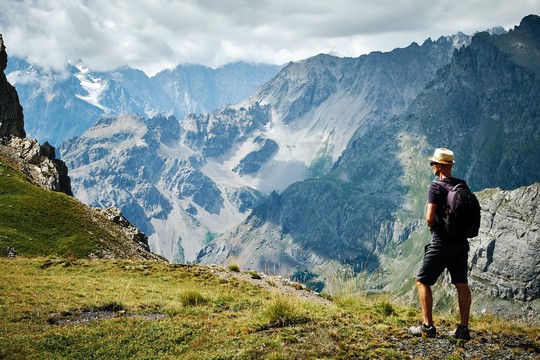
Travel diary: the Alps in a motorhome
Discover an idea of an itinerary over 5 days to set off on the road to the Alps in a motorhome.
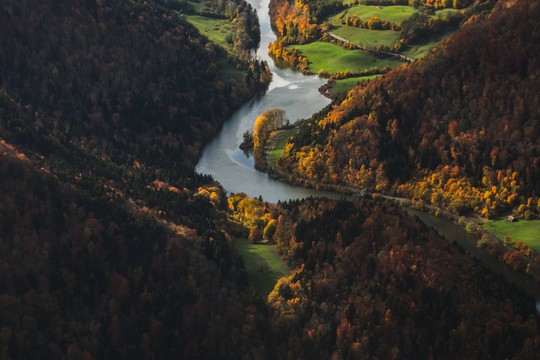
Travel diary: the Jura in a motorhome
Discover the Jura in a motorhome, its winding roads, its Jura mountains and its sublime landscapes
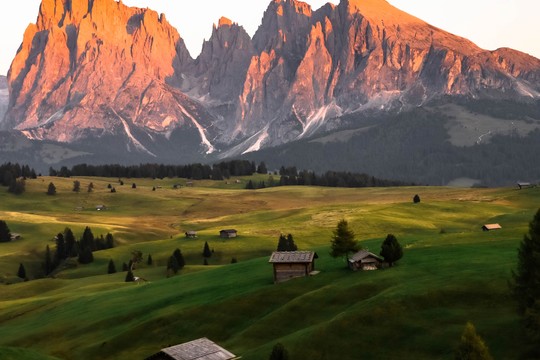
Travel diary: visit Italy by motorhome
Join the club of lovers of Italy with our motorhome road trip from North to South
What can we do to help you?
Our branches by regions
Our branches by cities
- USA RV Rental
- Canada RV Rental
- Europe RV Rental
- Netherlands
- Switzerland
- UK - England, Scotland
- New Zealand RV Rental
- New-Zealand
- New Zealand
- © 2024 Ideamerge LLC
RV HIRE SWITZERLAND
Switzerland motorhome or campervan rental.
Our Switzerland RV rental REVIEWS average 4.7 stars out of 5 , based on 28 Motorvana Switzerland motorhome rental and campervan hire customer reviews.
MOTORVANA uses buying power to give you big RV rental savings. We facilitate the Switzerland RV rental and campervan hire process with ultra-responsive support and a true total motorhome rental cost.
We give you peace of mind.
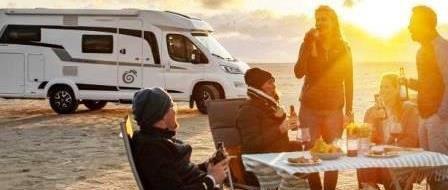
Switzerland motorhome rental SPECIALS: If you place your Switzerland RV rental booking request with Motorvana online, our software will apply any relevant specials from the RV hire vendor as well as our own Motorvana QUANTUM online discount.
Book your RV rental early to secure best price and availability. Many clients book their Switzerland motorhome hire holiday months in advance.
Also, check out our Switzerland RV Rental Customer Reviews page, where you can both read and post RV rental reviews.
Our modern, light, diesel-powered RVs eat Swiss mountains for lunch.
And the RVs are so well designed and appointed, you can fairly consider them Swiss chalets on wheels.
There is no better way to experience the Alps than by RV.
So what are you waiting for? Book a Switzerland motorhome rental with us today to travel Switzerland and the Alps in general with the utmost comfort and facility.
We recommend you rent the smallest RV you think will be comfortable. The narrow roads through villages and over mountain passes in Switzerland and elsewhere in the Alps are suited to small motorhomes and camper vans.
Make sure you fully understand how everything in your rental RV works before you start your RV tour of Switzerland and beyond. Greywater is emptied in RV parks. Blackwater is contained in cassette toilets, which can be emptied at RV dump stations (or even in public restrooms). These cassettes need to be emptied every two or three days.
A great many well-equipped campgrounds are located throughout Switzerland.
Most Swiss campgrounds feature electrical connections (i.e. powered sites), toilets, hot and cold showers, washing machines, and a small shop selling relevant camping supplies.
Switzerland measures just 220 kilometers north to south, and 350 kilometers east to west — dimensions that lend themselves to leisurely RV travel but which are wonderfully complicated by some of the most beautiful mountains and valleys on the planet and by the diverse geographies and cultures associated with the three prime Swiss languages: German, French, and Italian.
Zurich is Switzerland's largest city, with a population of about 400,000 and a greater metropolitan area of nearly 2 million inhabitants. The city is located about 30 kilometers north of the Alps, on the northern tip of Lake Zurich.
An auto caravan hire or campervan hire in Swtizerland is a truly wonderful way to get off the beaten path. Leave behind the crowds that move by tour bus and even by train or car and which flock to the hotels. Combining a motorhome or camper van rental with the magnificent and unique real estate and outstanding RV travel facilities Switzerland offers: it's a magical recipe for a trip of a lifetime.
RV rental and travel is even popular in the winter of Switzerland. It's an awesome way to tour the Swiss ski resorts. Some Swiss mountain passes are closed in the winter but plenty are kept open. You can book snow chains with your Switzerland camper rental. And the rental RV will be equipped with snow tires. Yes, there is a functional kitchen, shower and toilet in these RVs during winter. What's more, the vehicles stay nice and warm at night.
Apart from our Motorvana QUANTUM online discount, the Campervan hire Switzerland prices and policies presented on the Motorvana website match those of our suppliers. You aren't paying extra by going through Motorvana — in fact you're paying far less, thanks to our unilateral, QUANTUM discount.
Motorvana: Free Your Travel
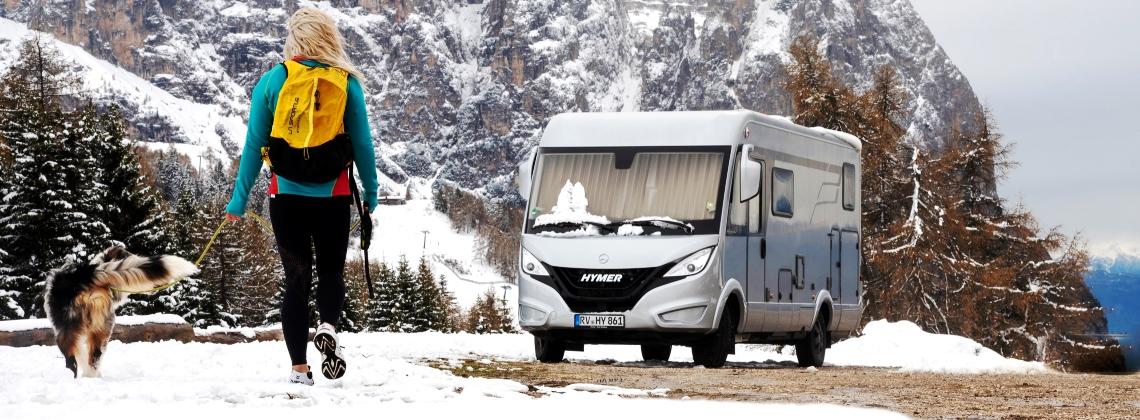
Cost Of Renting A RV In Switzerland
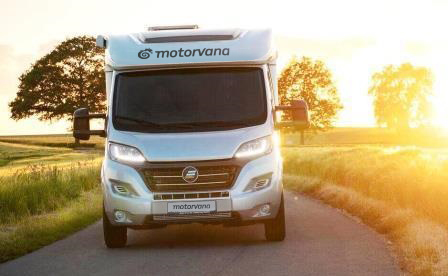
How much does it cost to rent an RV in Switzerland? Several variables determine the cost of a motorhome rental or campervan hire in Switzerland, including RV size, seasonality, and optional extras.
For exact total costs, please submit a SEARCH above. Our online order software will present all the RVs, whether motorhome, campervan or truck camper, ordered by price.
If you then click on the MORE INFO button below a RV image, all details about the RV, price, inclusions, depot location, and policies will be presented.
Various optional items are available for hire with a RV rental, and these greatly affect the total cost. These items (e.g. camping table and chairs, bedding, shuttle transfer) are presented during the ADD OPTIONS step of our online order process, along with selectable pick-up and return times.
In many cases the RV rental company offers free miles / free kilometers and/or an inclusive package that bundles together a set of optional extras for one relatively low price. Again, don't worry about those packages. Just select à la carte the options you want and our software will apply an inclusive package if such is available and if such package indeed gives you a lower price than actually paying for the options à la carte.
Similarly, RV rental companies often offer specials that involve optional extras. Such specials can be complicated and hard for customers to understand. Again, our software is carefully programmed and maintained to automatically apply any specials that benefit you.
We think our software is unique in terms helping our customers optimize their RV rental and minimize their costs in these important respects. Our aim is to provide you with the best value and to increase our sales as a result.
For a variety of information and websites related to traveling Switzerland by RV, please visit our European RV Travel Resources page.
Motorvana Switzerland RV Rental Reviews
This was our first trip to Europe and also our first camper rental. We only had eight days to travel in Europe, and our trip included delivering our daughter to school in Schladming, Austria. A camping trip en route seemed very appealing. We found Motorvana through an Internet search, and through them, we were connected with DRM. From our first correspondence with Mark Carr of Motorvana, we found them to be both most helpful and prompt in answering our questions. The quote provided us was both accurate and comprehensive, and even included bedding. Read More … Rob, Karen and Sarah Stewart, Canada
My wife and I just got back from our third trip in Germany and surrounding Austria, and Switzerland using Motorvana as our agent. We had a great trip and again were very happy with our motor camper and the DRM rental depot near Frankfurt. That location is so easy to get to. It is within walking distance of the first train stop. The train ride is less than 5 minutes and the walk is about 15. Of course you can take a cab to and from the airport. We enjoy the walk after a long plane ride. The weather in mid September has always been great. We visited 11 different campgrounds in our 13 night stay. Make sure you bring your GPS with European database. … We will use Motorvana again as the staff are very helpful and I like dealing with a smaller more personalized company. After this 3rd trip I cannot imagine touring any other way. It is so nice having your bathroom with you all the time and your kitchen. Read More … Roy and Cindy Zimmer, USA
People tended to respond incredulously to the idea that our family was going to tour the Alps in a motor home. "You're going to what? Really…?" seemed to be the most common response. And we had our own doubts too. Would the RV be a piece of junk? What would the campsites be like? How would I do driving a motor home in the Alps or on the Autobahn? According to the internet, the Europeans vacation this way all the time; could we Americans make it work? … [T]he short answer to all these questions is that we had a great time and experienced Europe in a way that few Americans do. Read More … The Benoit Family
Free Your Travel
- Disclaimers & Notices
This website uses cookies .
Motorvana TM and the Spiral Shell Hare logo are trademarks of Ideamerge LLC. All rights reserved. © 2024 Ideamerge LLC
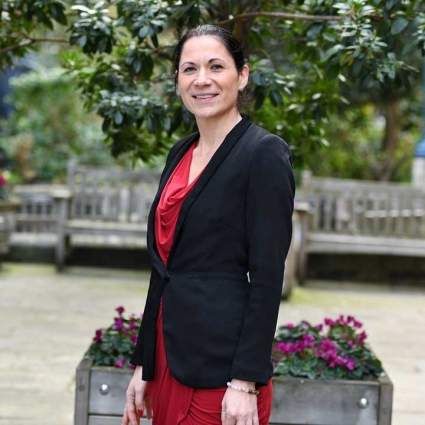
Welcome to Switzerland Travel Centre! You are welcome to contact us by e-mail or by phone on +44 207 420 4900 .
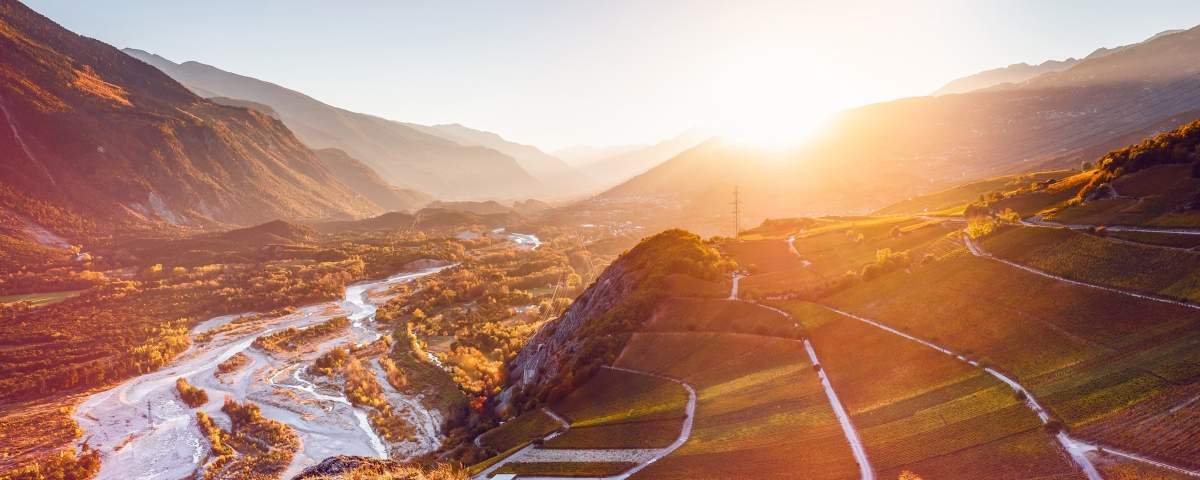
incl. 50% on mountain excursions & public transport
Grand Tour of Switzerland - Original
9 days / 8 nights.
The self-drive Grand Tour of Switzerland takes you on a 1,600 km tour through the most beautiful regions of Switzerland. Past lush green meadows and deep blue lakes, over winding pass roads and from picturesque mountain villages into the lively hustle and bustle of the city.
- Zurich - Lucerne
- Lucerne - Zurich
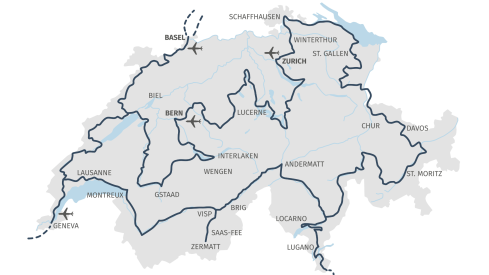
- 50% on mountain excursions & public transport (for foreign travellers only)
- 4 language regions
- 5 Alpine passes & 22 lakes
- 13 UNESCO World Heritage Sites
- Highest point: Furka Pass 2'429 m.a.s.l.
- Lowest point: Lago Maggiore, 193 m.a.s.l.
- Very good road infrastructure (road condition, petrol stations along the route)

«Of course a photo in front of the famous photo spot of the Grand Tour should not be missing.»
Your itinerary.
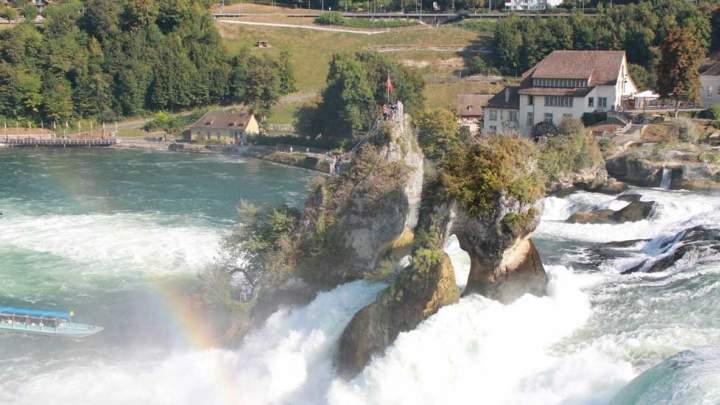
- Europe's biggest waterfall
- Discover how cheese is made in Appenzell
- Castello Montebello, Bellinzona
- Aletsch Glacier Riederalp
- Photo spot at Lake Lucerne in Brunnen
Overnight stay in Zurich.
Highlights: Museums (such as National Museum, Art Museum, Zurich’s Museum of Design, FIFA Museum), galleries, shopping paradise, Uetliberg, Grossmünster church
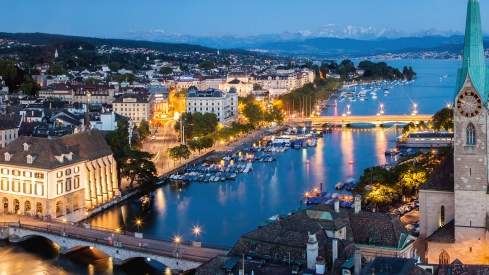
Zürich - St. Gallen / approx. 150 km
Drive from Zurich via the Rhine Falls to St. Gallen. Overnight stay in St. Gallen.
Highlights : Europe’s largest waterfall, the charming old town of St.Gallen, Abbey library of St. Gallen library
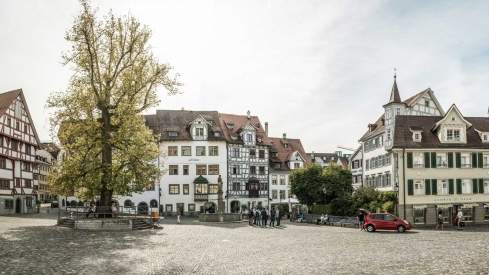
St. Gallen - Davos / approx. 160 km
Journey from St. Gallen through Appenzell and via Maienfeld to Davos. Overnight stay in Davos.
Highlights : rolling hills landscape in Appenzell, Heidi’s Village in Maienfeld

Davos - Lugano / approx. 290 km
Journey from Davos via the Engadin to Lugano. Overnight stay in Lugano.
Highlights : Guarda – the village of Schellenursli, Swiss National Park in Zernez, the train experience on the Bernina Express, hike on Muottas Muragl, world famous St. Moritz
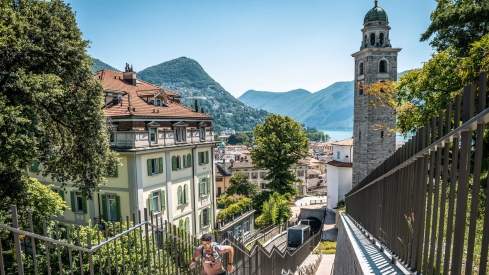
Lugano - Zermatt / approx. 215 km
Journey from Lugano via Bellinzona and passes St. Gotthard and Furka to Täsch. From there take the train to Zermatt. Overnight stay in Zermatt.
Highlights : Monte Brè, Ascona, Bellinzona, alpine passes St.Gotthard and Furka, Aletsch Glacier
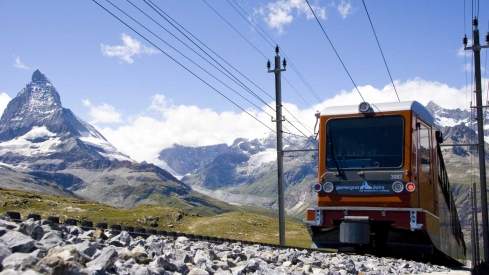
Zermatt - Montreux / approx. 150 km
Journey from Zermatt and Täsch along the river Rhone through the Valais via Sion and Martigny to Montreux. Overnight stay in Montreux.
Highlights : Imposing mountains around Zermatt, Gornergrat, religious gold treasures in Saint-Maurice, Castle Chillon, Lake Geneva

Montreux - Gstaad / approx. 330 km
From Montreux through the Lavaux vineyards, via Lausanne, Geneva, Fribourg and Gruyère regions to GstaadOvernight stay in Gstaad.
Highlights : Lavaux wine region, Olympic Museum, Freiburg, Greyerzer region with cheese factories, Cailler chocolate factory
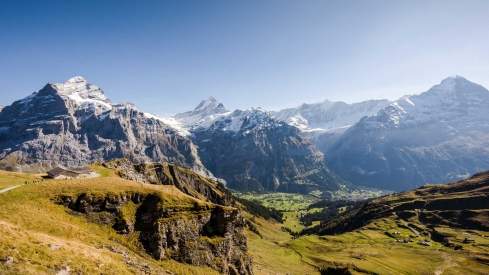
Gstaad - Luzern / approx. 315 km
The journey continues from Gstaad, via Interlaken, Bern and through the Emmental and Entlebuch to Lucerne. Overnight stay in Luzern.
Highlights : chalet village of Gstaad, Lake Brienz, Lake Thun, Eiger, Mönch, Jungfrau, old town of Bern, Emmental cheese factory
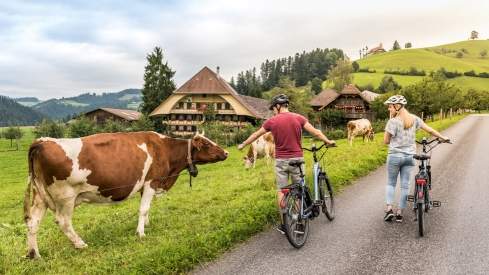
Luzern - Zürich / approx. 140 km
From Lucerne it goes along Lake Lucerne and Altdorf and Schwyz to Zurich.
Highlights : On Wilhelm Tell’s traces in Altdorf, Luzern, the Chapel Bridge and Water Tower, excursions mountains Rigi, Pilatus und Stanserhorn
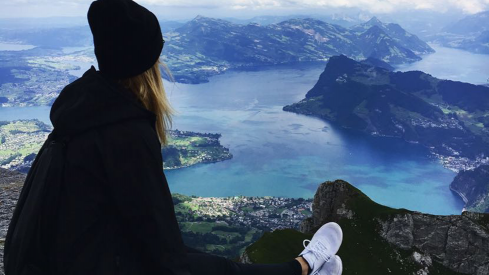
- 8 nights with breakfast in Zurich, St. Gallen, Davos, Lugano, Zermatt, Montreux, Gstaad, Lucerne
- Swiss Half Fare Card (only for people not resident in Switzerland or Liechtenstein)
- 2nd class train ticket Täsch-Zermatt-Täsch
- "Grand Tour of Switzerland" road map from Hallwag
- "Grand Tour of Switzerland" travel guide
- Swiss Coupon Pass with "Eat and Experience" - 2 for 1 offers with a total value of up to CHF 4,500
- From price applies per person in a 3-star double room
- Booking period: all year round Travel period: 01.04. - 23.10.2024
- Price example calculated on 01.03.2024 for 29.09.2024
Good to know
- Travel documents are sent by email and in exceptional cases by post.
- Additional overnight stays bookable
- The route only crosses motorways if it is absolutely necessary to do so
- If you use your own car, a highway vignette is required. This can be purchased directly online as an e-vignette.
- Rental car can be booked optionally
- Recommended travel time: May - October
- Please inform yourself about the road conditions at www.alpen-paesse.ch before you start your journey.
- Alternatives such as tunnels or car transport possible
- Would you like to make someone happy? Why not offer them the trip as a gift ?
Flight Options
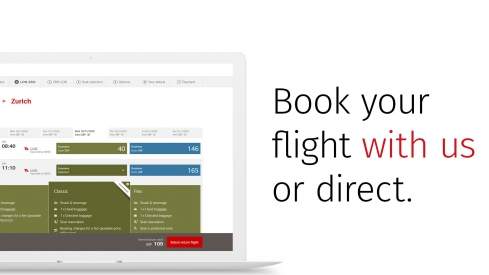
Our in-house flights experts will be happy to offer advice and to book the most convenient flight for your trip.
Your flights will be covered by our package booking conditions and will be protected under our ATOL license. We will charge £35 per person for this flight booking service.
Alternatively book your flights directly with Swiss - our preferred partner for flights to Switzerland.
Speak to an expert
We are both the official and largest tour operator for holidays to Switzerland and have been in operation for over 30 years with ABTA and ATOL protection. Please give us a call and we will be happy to go through your plans. Call +44 207 420 4900 to speak with us or send us your travel request via [email protected] .
Can't call now? Request a callback.
Could also be of interest to you.
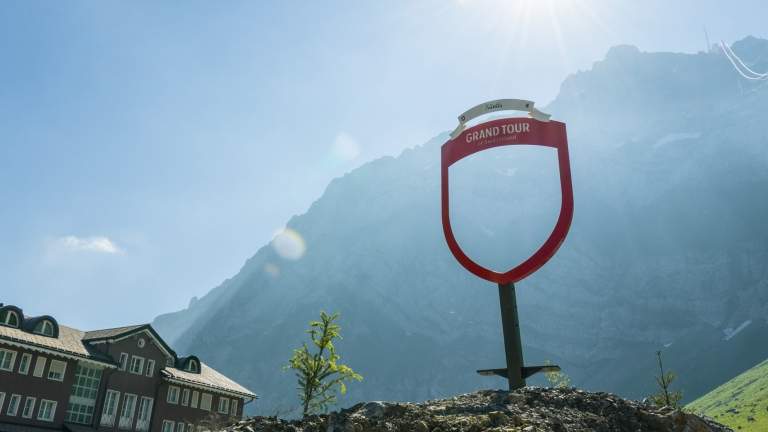
Grand Tour of Switzerland – Eastern Route
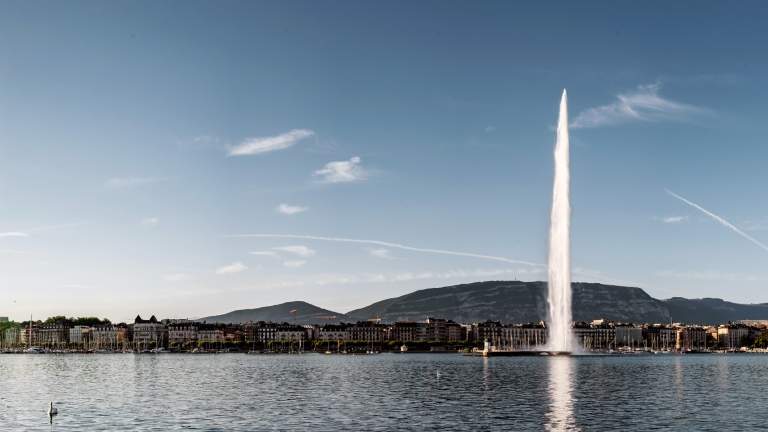
Grand Tour of Switzerland – Western Route

IMAGES
VIDEO
COMMENTS
Motorhome Routes- UK to Switzerland. The quickest route from Calais to Basel (closest major point in Switzerland) is to the NE of Paris, via the A26 and then the N4. This route is around 685km, should take around 7h 25m and will cost about 33€ in tolls for a small camper or a car. A motorhome will cost more.
A 1643 km long route across Switzerland with 9 stages, passing 12 UNESCO World Heritage Sites, 22 lakes and diverse landscapes. Discover the highlights of the country, such as the wine region of Lavaux, the castles of Bellinzona, the biosphere Entlebuch and the sky-blue Lake Brienzer.
This campervan road trip itinerary for Switzerland is fully customizable, so whether you have 7 days or 14 days, you can pick and choose the best stops and campervan campsites that work with your schedule. Before you follow my itinerary, make sure you head over and save/read my post about the best driving and camping tips for a Switzerland road ...
MOTORHOME AND CAMPERVAN CAMPING IN SWITZERLAND. A motorhome tour is the best way to travel around Switzerland in the summer. This is because it is much more economical and budget-friendly than paying for accommodation, which tends to be relatively expensive in Switzerland.
Then, there's the Munt La Schera tunnel, which relates from Switzerland to Livigno and Bormio. The tunnel has its own tolls and is open 24/7. It is the best route for all drivers, including campervan drivers traveling in the area, especially in winter. The toll price for the tunnel is CHF25.00.
In fact, renting a car or driving your own camper is cheaper than taking the trains everywhere in Switzerland. Car rental in Switzerland is relatively affordable — a 1-week car rental in Switzerland costs around US$365 or €300. Currently, petrol costs around €1.3-1.5 per liter.
The Grand Tour of Switzerland goes over five Alpine passes that are at least 2,000 m above sea level: 1. Flüela Pass. Length: 27 km, max. gradient: 10%, usually closed in winter from January to April/May, no restrictions for motorhomes, bypass: Vereina car shuttle station from Klosters Selfranga to Sagliains. 2.
The Escorted Motorhome Tour. Switzerland is more than just chocolate, watches, and yodelling. It is a land of 4 languages and multicultural sophistication. It is a small country but has a host of great places to see and visit with beautiful alpine scenery, glittering blue lakes, emerald valleys, and quaint villages.
A motorhome journey of Switzerland will take you past the most beautiful landscapes. The Grand Tour, as the name suggests, will take you past all the country's highlights. This motorhome journey is 1643 kilometres long. Along the way, you will see, among other things, 12 UNESCO World Heritage Sites and 22 lakes.
A scenic route that connects all tourist regions in Switzerland on a journey over five Alpine passes, past 22 lakes and 12 UNESCO World Heritage sites. The Grand Tour of Switzerland offers a meaningful connection between the Alpine region and cities, tradition and history, nature and culture, art and architecture, the known and the unknown, the calm and the adventure.
Where To Rent A Campervan In Switzerland. We booked our trip last minute, many campervan rentals seemed quite expensive. The most affordable option with enough space was Indie Campers, a 5 seat belt 6 bed option. We chose the Atlas camper van and it was fantastic for all of our needs. For 2 full weeks it was approximately £900.
Camping Lugano Lake. A mere 10 minutes from the centre, this campsite will have you perfectly situated to explore the area. It is situated in a national park, and you'll be able to make use of the private beach. Price: starting from 18 CHF / £15. Location: Via Molinazzo 9, 6982 Agno, Switzerland.
Grand Tour of Switzerland Special. Grand Tour Snack Box - value CHF 25. Grand Tour Touring Guide with integrated map - value CHF 32. Swiss Coupon Pass with special offers on attractions, shopping, and food - value CHF 49. All three products are only available in one package for just CHF 98 (reduced from CHF 106)
Zurich is the largest city in Switzerland and is situated on the shores of a lake by the same name. Due to its significant international airport, Zurich is a prominent place to rent an RV in Switzerland. A short drive away is Lucerne, a renowned lovely old town with one of Europe's oldest covered bridges.
Nomady - Camping away from Camping. Camping guide. TCS camping guide. Motorhome campsites. You discover over 100 permissible, private and public motorhome campsites in Switzerland. Wohnmobilland Schweiz. Stellplatz Schweiz. Anzeigen. 30 km.
Take your motorhome to Switzerland for the ultimate road trip experience, climbing sharp peaks, parking by lakes and savouring delicious fondue! ... If you're not quite culturally satisfied after the Kunsthaus, make a tour of the numerous historic churches dotted across Zurich. From the Romanesque Grossmunster church, to the 8th century St ...
This is our second trip to Switzerland by motorhome in cooperation with the tourist organization My Switzerland. This year we chose the beginning of June for ou
After ten days of events our time in Lauterbrunnen comes to an end with a Farewell Dinner on the 9th January. Susanna and Ted Brooking - Switzerland for New Year - Dec 2018/Jan 2019. 'Wow, what a way to start the New Year, This tour exceeded our expectation, a tour hard to beat. Thank you Chris and Alan, excellent Tour Directors.'.
Switzerland by Motorhome. August 16, 2012 / 2 Comments / in Motorhome Destinations. The below guide has been written based on our experiences visiting Switzerland by motorhome and will hopefully give you an idea of what it's like to travel there. However, things do change, so before you set off it's worth checking for up to date travel ...
Arrived at the border between France and Switzerland in a motorhome, you must buy a sticker to be able to travel freely in the country: for a motorhome weighing less than one ton, count 40 Swiss francs for one year, ie 38 €; for a motorhome weighing more than 3.5 tonnes, it costs 38 € for 3 weeks. Your motorhome tour of Switzerland begins ...
Combining a motorhome or camper van rental with the magnificent and unique real estate and outstanding RV travel facilities Switzerland offers: it's a magical recipe for a trip of a lifetime. RV rental and travel is even popular in the winter of Switzerland. It's an awesome way to tour the Swiss ski resorts.
European Motorhome Tour day 42-43. We head up a valley into the Mountains and overnight at an Ice Rink. We are really cramming in the activities now as this...
9 days / 8 nights. from £ 860. Tooltip. Customisable! The self-drive Grand Tour of Switzerland takes you on a 1,600 km tour through the most beautiful regions of Switzerland. Past lush green meadows and deep blue lakes, over winding pass roads and from picturesque mountain villages into the lively hustle and bustle of the city.